fMRI
Digital Poster
fMRI
3681 -3704 fMRI: Preclinical
3705 -3729 fMRI: Physiology
3730 -3754 Multimodal fMRI
3755 -3779 fMRI Contrast Mechanisms & Signal Characteristics
3780 -3804 fMRI: Applications
3855 -3878 fMRI: Connectivity Methods
3880 -3904 fMRI Connectivity Applications: Human
3905 -3929 fMRI: Analysis Methods
3930 -3954 fMRI: Acquisition & Artefacts
fMRI: Preclinical
Digital Poster
Digital Poster
fMRI
Wednesday, 15 May 2019
| Exhibition Hall | 13:30 - 14:30 |
| Computer # | |||
3681. 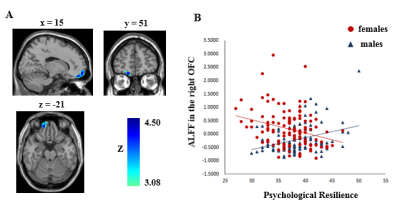 |
1 | Sex-linked neurofunctionnal basis of psychological resilience in late adolescence
Cheng Yang, Song Wang, Qiyong Gong
Psychological resilience refers to the ability to bounce back from adversity and previous studies have shown sex differences in psychological resilience. Here, we employed amplitude of low-frequency fluctuations (ALFF) to investigate sex differences in the relationship between resting-state brain activity and psychological resilience in 231 healthy adolescents. Behaviorally, we found that males were more resilient than females. Neurally, a positive correlation between psychological resilience and the ALFF in the right orbitofrontal cortex was detected among males while a negative correlation was observed among females. Together, our study provided the first evidence of sex-specific neurofunctional substrates underlining psychological resilience in adolescents.
|
|
3682. 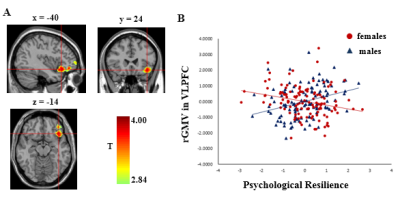 |
2 | Gender differences in the relationship between gray matter structure and psychological resilience in late adolescence
Cheng Yang, Song Wang, Qiyong Gong
Although behavioral studies have shown that males are more resilient than females, the effects of gender on the relationship between brain structure and psychological resilience are largely unknown. Here, we investigated the gender-specific associations between psychological resilience and regional gray matter volume (GMV) in 231 healthy adolescents via structural magnetic resonance imaging. We found that the relationship between psychological resilience and GMV differed between genders in the left ventrolateral prefrontal cortex, with a positive correlation in males and a negative correlation in females. Therefore, our study provided the first evidence for the gender-specific neuroanatomical correlates of psychological resilience.
|
|
3683. 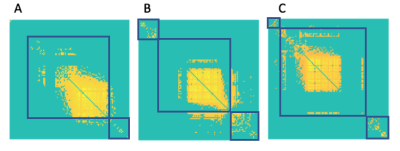 |
3 | Effects of Omega-3 Fatty Acids on Brain Connectivity in Long-Evans Rats
Adebayo Braimah, Diana Lindquist, Ruth Asch, Jennifer Schurdak, Robert McNamara
This study examines the impact of dietary fatty acid intake on functional connectivity of the maturing brain. This study was performed with 88 rats. In vivo as well as ex vivo neurological data was collected by means of MR imaging and postmortem gas chromatography. The graphs were compared by using network-based statistics and showed non-significant trends between the controls and the fatty-acids deficient group. Network metrics were also computed and showed non-significant trends between the controls and the fatty acids deficient group.
|
|
3684. 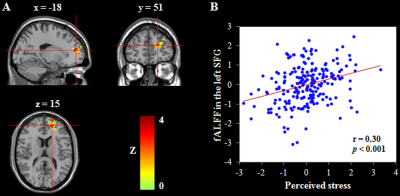 |
4 | Stress and the brain: Perceived stress mediates the impact of the superior frontal gyrus spontaneous activity on depression in late adolescence Presentation Not Submitted
Song Wang, Qiyong Gong
Perceived stress (PS), which reflects the tendency to appraise one’s life situations as stressful and overwhelmed, is a stable predictor for depression. Here, we used resting-state functional magnetic resonance imaging to investigate the neural basis of PS and the underlying brain mechanism linking PS and depression in 217 adolescents. We found that PS was positively related to the spontaneous activity in the left superior frontal gyrus (SFG). Furthermore, PS mediated the link between the left SFG activity and depression. Altogether, our study might present a neurofunctional marker of PS and reveal an underlying brain-stress mechanism for predicting depression.
|
|
3685 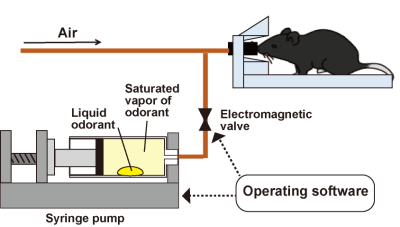 |
5 | Odor stimulation by automated syringe pumps in combination with the independent component analysis for BOLD-fMRI study of mouse whole brain Video Permission Withheld
Fuyu Hayashi, Mitsuhiro Takeda, Naoya Yuzuriha, Sosuke Yoshinaga, Hiroaki Terasawa
Olfactory perception in mice involves the activation of brain regions. We previously developed a method that uses repetitive odor stimulation and independent component analysis (ICA) for BOLD-fMRI studies. Using BOLD-ICA, we sought to detect odor-evoked responses in the mouse whole brain. Previously, the administration of an odorant substance had been performed by manually operating a syringe pump to infuse the saturated vapor of an odorant substance. We constructed a system that automatically controls the syringe pump, to ensure the accuracy of stimulation timing and duration. We demonstrate the improved detectability in the BOLD-ICA method by the automated system.
|
|
3686.  |
6 | Structural and Resting-State Functional Connectivity Changes of the MPS I Mouse Brain
Wei Zhu, Yi Zhang, Yucong Ma, Kyle Schaible, Nanyin Zhang, Xiao-Hong Zhu, Perry Hackett, Walter Low, Wei Chen
Mucopolysaccharidoses (MPSs) is a group of inherited lysosomal storage disorders that could cause multiple organ failure, cognitive impairment, and shortened life span. In spite of the recognizable clinical morphological and physiological features associated with MPSs, brain connectivity changes and physiopathologic mechanisms responsible for these alterations in the central nervous system are rarely studied but might be a reliable biomarker for disease severity and treatment efficacy. A new study of brain connectome on MPS I mouse model using resting-state functional MRI (rs-fMRI) technique was conducted and a dramatic deterioration on functional connections involving multiple brain regions were observed.
|
|
3687 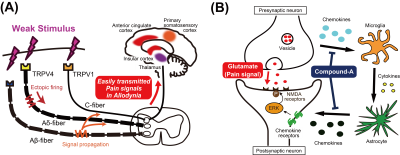 |
7 | BOLD-fMRI evaluation of analgesic candidates with different analgesic mechanisms against allodynia-specific pain in a chronic pain animal model Video Permission Withheld
Mikio Sameshima, Sosuke Yoshinaga, Naoya Yuzuriha, Mitsuhiro Takeda, Hiroaki Terasawa
The aim of this study is to evaluate the pain-relieving effect of a novel chemokine signal-inhibiting compound on allodynia-specific responses in a chronic pain animal model, using our BOLD-fMRI-based pain evaluation system with a green laser. We observed activations in four brain regions related to pain. We found that the compound suppresses green laser-evoked allodynia-specific responses in three regions. We expect that the compound has synergistic pain-relieving effects with existing analgesic agents. Our system is useful to evaluate the effects of new analgesic candidates in non-clinical and, expectantly, clinical studies.
|
|
3688. 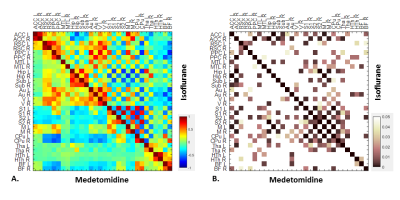 |
8 | Altered bilateral functional connectivity in rat brain under isoflurane and medetomidine anesthesia
Ting Yin, Rolf Gruetter, Ileana Jelescu
Anesthetic agents are commonly used in rodent resting-state functional MRI. When anesthetized under different agents, brain functional connectivity can be altered. It has been shown that after isoflurane initiation, brain connectivity measured under medetomidine was extensively affected in a time-dependent manner. Here, we further compare the difference of resting-state networks detected under isoflurane and medetomidine anesthesia.
|
|
3689 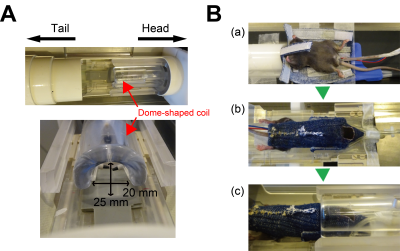 |
9 | An awake mouse MRI method using mouse clothes for fMRI applications Video Permission Withheld
Sosuke Yoshinaga, Satoshi Fujiwara, Shunsuke Kusanagi, Kazunari Kimura, Rikita Araki, Mitsuhiro Takeda, Hiroaki Terasawa
In current awake MRI methods, fixing apparatuses implanted in the brain by surgery and acclimation procedures by training have been explored, to suppress head movement in the scanner. Previously, we reported an awake MRI method using mouse clothes designed for a cryogenic coil system, without surgery and training. We now report the successful optimization of the awake mouse MRI method for fMRI applications, using the newly designed mouse clothes. Resting-state analyses showed bilateral functional connectivities in the cortical and limbic system networks in an awake mouse. Our method will contribute to the acquisition of awake-specific neuronal responses.
|
|
3690. 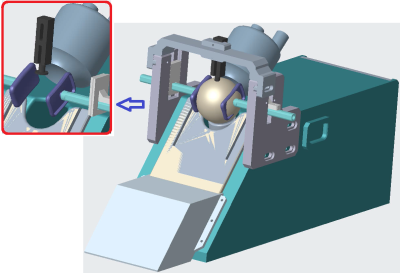 |
10 | Awake Macaque MRI Setup on 7T Human Scanner Platform for High-Resolution Anatomical and Functional Imaging
Yang Gao, Meizhen Qian, Pinyi Wang, Yi Sun, Anna Roe, Xiaotong Zhang
We introduced a customized setup for awake sitting macaque MRI in a 7T horizontal-bore human scanner. Considerations in the specialized design of monkey cage and head fixation device consisting of 1) monkey comfort in a Sphinx position, 2) stable head fixation, 3) easy mounting of the surface array for cortex imaging, and 4) easy presentation of visual stimuli. Our findings demonstrate that, in a well-trained awake monkey, with the increased contrast sensitivity and substantial gains in spatial resolution offered by ultra-high field MRI and a custom-made dense RF array, our setup is capable of achieving improved SNR and high time efficiency.
|
|
3691. 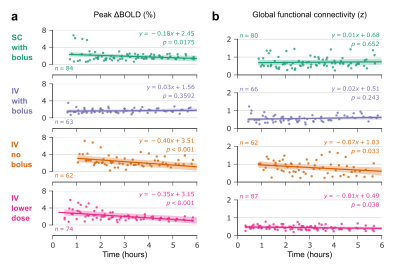 |
11 | Are fMRI measurements in medetomidine-anesthetized rats temporally stable?
Nikoloz Sirmpilatze, Jürgen Baudewig, Susann Boretius
Medetomidine is often used to anesthetize rats during BOLD fMRI, yet the exact protocols for its administration differ across studies, compromising comparability and raising questions regarding the stability of fMRI measurements over several hours of anesthesia. We performed multiple repeated measurements of somatosensory and resting-state fMRI in medetomidine-anesthetized rats for up to six hours. Four different protocols of medetomidine administration were tested for their capacity to sustain stable measures of stimulus-evoked response and functional connectivity. The reported results are expected to help researchers in choosing the administration regime best suited for their needs.
|
|
3692. 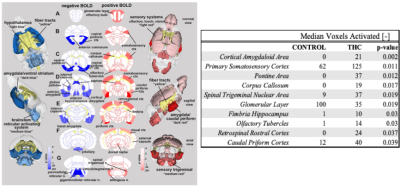 |
12 | Neurological, Physiological, and Behavioral Effects Following Acute Cannabis Nose-Only Exposure in C57BL/6J Mice
Yasmeen Farra, Dongyang Yi, James Coleman, Praveen Kulkarni, Craig Ferris, Jessica Oakes, Chiara Bellini
Cannabis use is rising worldwide. Robust standardized methodologies in animal models are needed to further elucidate the impact of cannabis on overall health. Our aim was to identify acute exposure methods that provide a viable model for human cannabis consumption. C57BL/6J mice were exposed to cannabis aerosols using a Volcano® vaporizing device. Cannabis dosage levels were identified that elicited a human-like response. Animals were exposed while undergoing fMRI scans of their neurological activity. BOLD data, coupled with blood pressure and behavioral tests, demonstrated that our exposure methods generated a reproducible response that can be adapted for further studies.
|
|
3693.  |
13 | Examining fMRI time-series Multi-Scale Entropy as a Biomarker for Excitation/Inhibition Balance in the Brain
Kaundinya Gopinath, Eric Maltbie, Leonard Howell, Phillip Sun
The maintenance of a dynamic balance between excitatory and inhibitory synapses in the neocortex is critical for brain function. Many psychiatric disorders are characterized by disturbance of E/I balance. In this study we examined the potential of the fMRI time-series complexity metric multi-scale entropy (MSE) to act as a biomarker for E/I balance, using a non-human primate (NHP) model. We disturbed the E/I balance with the sub-anesthetic ketamine, which induces disinhibition of projection neurons, especially in prefrontal cortex (PFC) during fMRI of conscious NHPs. Our results confirmed that fMRI MSE is a sensitive marker for E/I balance in the brain.
|
|
3694. 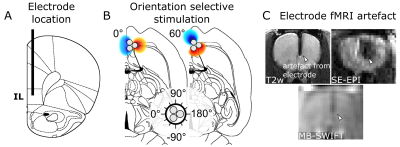 |
14 | Tuning Neuromodulation Effects by Orientation Selective Deep Brain Stimulation in the Rat Medial Frontal Cortex
Lauri Lehto, Pavel Filip, Hanne Laakso, Alejandra Sierra, Julia Slopsema, Matthew Johnson, Lynn Eberly, Walter Low, Olli Gröhn, Heikki Tanila, Silvia Mangia, Shalom Michaeli
With simultaneous fMRI and Deep Brain Stimulation (DBS), we demonstrate modulation of activity in rat amygdala by using axon Orientation Selective Stimulation (OSS) DBS in rat infralimbic cortex, a homologue brain region for treating depression in humans. Our results demonstrate orientation selectivity based on number of activated pixels especially in the amygdala, though qualitatively also other brain areas showed modulation based on stimulation angle. OSS may add a new level of optimization for treating major depression disorders.
|
|
3695. 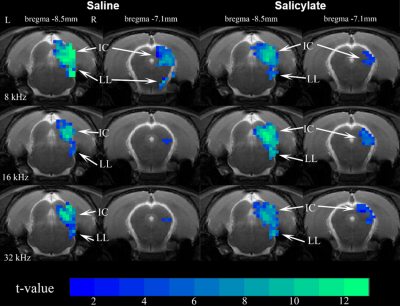 |
15 | Sound-evoked functional magnetic resonance imaging of tinnitus and hyperacusis neural mechanisms
Eddie Wong, Benjamin Auerbach, Richard Salvi, Ed Wu, Condon Lau
Tinnitus involves the perception of sound in the absence of external acoustic stimuli. The underlying mechanisms of tinnitus have been investigated using noninvasive, whole brain functional imaging methods. However, the changes in the subcortical auditory system are less well understood. To address this knowledge gap, we conduct an auditory fMRI on a well-established sodium salicylate-induced rodent tinnitus and hyperacusis model. The results reveal frequency-dependent changes in auditory subcortical structures, inferior colliculus and lateral lemniscus by salicylate induced tinnitus. This study has advanced our understanding of subcortical auditory processing during tinnitus/hyperacusis and advances the rat model for further fMRI investigations.
|
|
3696 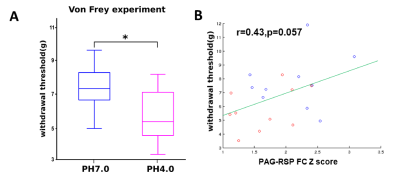 |
16 | Reduced brain functional connectivity induced by generalized pain identified by mice Rs-fMRI Video Permission Withheld
Md Nasseef, Emmanuel Darcq, Waiya Ma, Jai Singh, Naoki Dozono, Kevin Lancon, Philippe Seguela, Hiroshi Ueda, Brigitte Kieffer
Fibromyalgia (FM) is a disorder characterized by generalized pain. The acid saline-induced muscle (ASM) model is considered an acceptable animal model of FM with widespread chronic pain. Here, we investigated the impact of FM-like pain on neural communication, using the ASM model with non-invasive mouse resting state fMRI. We found that generalized pain reduces functional connectivity at the level of periaqueductal gray and retrosplenial cortex, two regions related to pain processing and FM. Moreover, we found a positive correlation between pain sensitivity measured by Von Frey test and the intensity of FC reduction at individual subject level.
|
|
3697.  |
17 | Comparisons of resting-state networks obtained at 3 and 7 Tesla MRI in anesthetized rhesus monkey
Chan-Ung Park, Eunha Baeg, Boo-Hee Choi, Bo-yong Park , Hyunjin Park , Seong-Gi Kim
Understanding resting-state fMRI (rsfMRI) is an important issue to identify the functional principles of the normal and pathological brain networks. Despite the importance in comprehending network as a whole, a deeper understanding of the resting-state networks is limited due to the lack of a proper animal model. Here, we used anesthetized non-human primate (NHP) for understanding rsfMRI networks commonly detected in humans. BOLD and MION-enhanced CBV rsfMRI networks were obtained at 3T and 7T. Stable eight cortical networks were observed from MION experiments at 3T and 7T, and similar networks were also detected from 7T BOLD due to enhanced sensitivity.
|
|
3698. 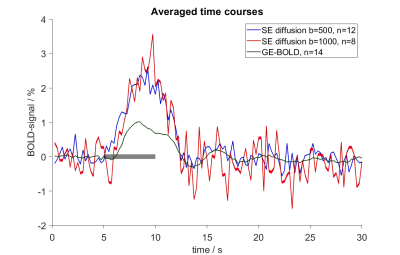 |
18 | Signal changes in functional diffusion measurements in rats are not caused by tissue heating, but have a vascular contribution
Franziska Albers, Daniel Schache, Lydia Wachsmuth, Henriette Lambers, Cornelius Faber
Functional diffusion MRI has been proposed as an alternative to BOLD fMRI, to offer a more direct read-out of neuronal activation. One aspect of the controversial discussion around functional diffusion is whether these signals follow the neuronal activation more closely. We performed BOLD and diffusion measurements with 250 ms temporal resolution upon sensory stimulation and found similar temporal evolutions for BOLD and diffusion signals. Specifically, both signals slowly returned to baseline after the stimulus. However, diffusion measurements with b=500 showed an earlier onset. We performed heat application to rule out tissue heating as a contribution to functional diffusion signals.
|
|
3699.  |
19 | Effects of Isoflurane on Brain Functional Connectivity in Common Marmosets
Naoki Kawaguchi, Junichi Hata, Yawara Haga, Kanako Muta, Koya Yachida, Koshiro Terawaki, Hirotaka Okano, Hideyuki Okano, Akira Furukawa
We examined the effects of isoflurane on brain functional connectivity in common marmosets using resting-state fMRI. We found that the thalamus was closely related to the mechanism of action of anesthesia and the default mode network (DMN), which is thought to function at rest. Isoflurane exhibited similar effect on the thalamus and human DMN region in humans but partly different effect onthe marmoset DMN region.In the future, we need to perform further investigations in detail by increasing the amount of data and reviewing analysis methods.
|
|
3700. 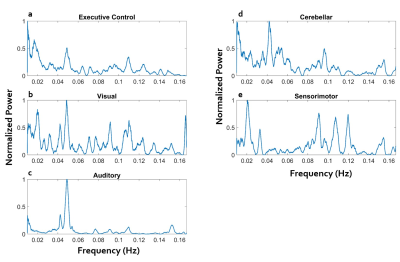 |
20 | Identification and Characterization of Resting State Networks in the Translational Pig Model
Gregory Simchick, Alice Shen, Hea Park, Franklin West, Qun Zhao
Due to the similar size, structure, composition, and neurodevelopment of the pig brain in comparison to the human brain, the pig serves as a valuable large animal model for studying brain connectivity. Presented here are five resting state networks (RSNs) identified within the three-week-old piglet brain determined using temporal sparse dictionary learning. Each RSN’s learned activation map correlates well with a constructed pig RSN atlas with Pearson spatial correlation coefficients in the range of [0.30 0.53], and clear differences in the power spectra, as well as unique characteristic frequencies, associated with the learned signal for each RSN are observed.
|
|
3701. 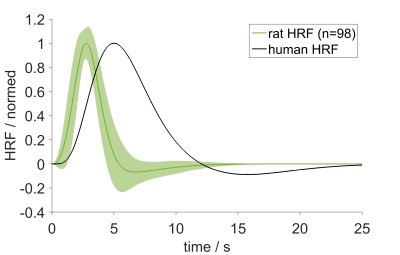 |
21 | Creation and evaluation of a generic rat hemodynamic response function for analysis of BOLD fMRI measurements
Henriette Lambers, Martin Segeroth, Franziska Albers, Lydia Wachsmuth, Timo van Alst, Cornelius Faber
For a reliable analysis of BOLD fMRI data, a suitable model of the hemodynamic response is essential. Therefore, an accurate model of the BOLD response of small animals is required in preclinical studies. Commonly used analysis tools like SPM or BrainVoyager have implemented HRFs optimized for humans by default. Since the BOLD responses of rats proceed faster than those of humans, we have determined a generic rat HRF based on 98 BOLD measurements of 35 rats which can be used for statistical parametric mapping. Statistical analysis of rat data showed a significantly improved detection performance using this rat HRF.
|
|
3702. 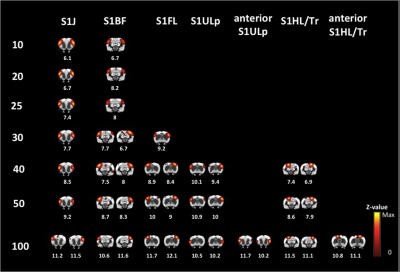 |
22 | The Effect of IC Number Selection in Group ICA for Rat Functional Connectivity
Tyng-Shiuan Hsieh, Chia-Feng Lu, Bao-Yu Hsieh, Cheng-Yu Chen, Yu-Chieh Jill Kao
Optimal IC number used in the ICA has been a kernel issue for functional MRI (fMRI) analysis. Nevertheless,
|
|
3703. 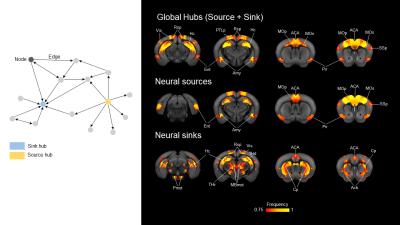 |
23 | Network structure of the mouse brain connectome with voxel resolution
Ludovico Coletta, Marco Pagani, Boris Bernhardt, Alessandro Gozzi
We provide a fine-grained description of the network structure and topology of the mouse connectome with voxel-resolution. We show that structural connectivity hubs can be spatially segregated into a dichotomic set of neural sink and neural source regions, and that functional and structural hubs show concordant neuro-anatomical topography. We finally demonstrate that the modular structure of the mouse connectome recapitulates large-scale fMRI networks of the mouse brain, including a default mode network core community, which is characterized by high structural resilience. Our results lay the foundation for topologically-driven targeted manipulations of the mouse connectome.
|
|
3704. 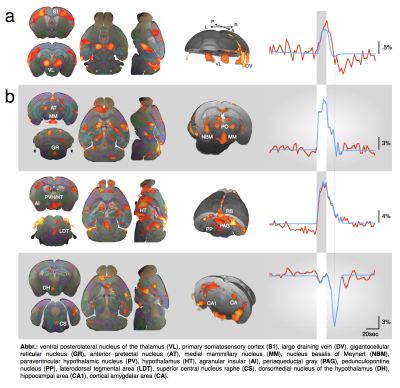 |
24 | Sympathetic Contribution in Somatosensory Mouse fMRI: Revealing "Hidden" Key Structure Activations by Detailing Functional Response Dynamics
Henning Reimann, Mihail Todiras, André Klage, Michael Bader, Andreas Pohlmann, Thoralf Niendorf
Electrostimulation of the paw is considered a basic paradigm to produce a reliable somatosensory response in animal fMRI. Yet, there is disagreement over the murine BOLD response: based on the anesthetic protocol either unilateral or bilateral patterns were reported. We hypothesize sympathetic activity as an origin of bilateral patterns, which is likely to be suppressed in protocols that employ α2-adrenoreceptor agonists. Utilizing finite impulse response (FIR) basis set modeling we present preliminary data that reveals "hidden" activity of brain structures which are known driving forces of sympathetic pathways. Our overall aim is to reveal the underlying mechanisms of this complex response to a simple paradigm and its implications for somatosensory mouse fMRI.
|
fMRI: Physiology
Digital Poster
Digital Poster
fMRI
Wednesday, 15 May 2019
| Exhibition Hall | 13:30 - 14:30 |
| Computer # | |||
3705. 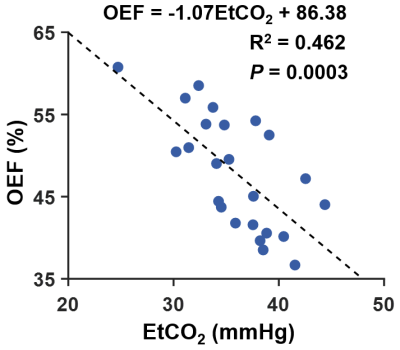 |
26 | Normal variations in brain oxygen extraction fraction (OEF) are partly attributed to differences in end-tidal CO2
Dengrong Jiang, Zixuan Lin, Peiying Liu, Sandeepa Sur, Cuimei Xu, George Pottanat, Kaisha Hazel, Sevil Yasar, Paul Rosenberg, Marilyn Albert, Hanzhang Lu
Quantitative assessment of brain oxygen extraction fraction (OEF) is of substantial clinical significance in many brain diseases. However, a remaining issue associated with OEF is its considerable inter-subject variations within healthy population. Therefore, it is important to investigate the physiological underpinnings of OEF variations among normal subjects. The present work used two studies, a discovery study and a verification study, to examine the extent to which end-tidal CO2 (EtCO2) can explain inter-subject variations in OEF. It was found that, across subjects, OEF is inversely correlated with EtCO2, and EtCO2 alone can account for about 50% of variances in OEF.
|
|
3706. 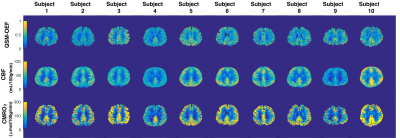 |
27 | Whole-brain OEF quantification: a comparison study between QSM and dual-gas calibrated BOLD
Yuhan Ma, Hongfu Sun, Junghun Cho, Erin Mazerolle, Yi Wang, G. Bruce Pike
The microvascular QSM approach for quantifying baseline brain oxygen metabolism has great potential due to its simple set-up and high spatial resolution. In this study, we aim to investigate the feasibility of the high SNR microvascular QSM-OEF technique with a hypercapnia gas challenge and compare OEF and CMRO2 measured by QSM-OEF with those measured using the dual-gas calibrated BOLD technique (DGC-BOLD-OEF), a reference standard. Baseline OEF and CMRO2 measured by hypercapnia QSM-OEF were found within the expected normal range for healthy subjects. Statistically significant but relatively small differences (5% difference) of OEF and CMRO2 were found between QSM-OEF and DGC-BOLD-OEF techniques.
|
|
3707 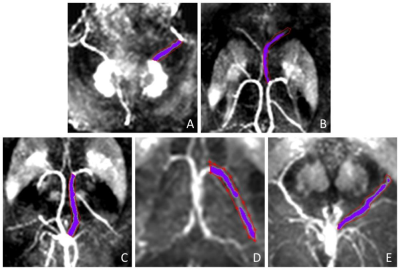 |
28 | The correlation between cerebral venous oxygen saturation change and cognitive score in Alzheimer's disease patients by using susceptibility weighted imaging mapping Video Permission Withheld
Junyi Dong, Yanwei Miao, Xiaoxin Li, Liang Han, Lizhi Xie, Qingwei Song, Ailian Liu
Alzheimer's disease (AD) is a progressive neurodegenerative disease and vascular factors may be important in the development and progression of AD[1]. Magnetic susceptibility weighted imaging (SWI) is widely used in the diagnosis of central nervous system diseases, and venous oxygen content is the basis of SWI angiography. The venous blood oxygen level can be reflected by measuring the phase value of venous blood. This study first made use of SWI mapping (SWIM) to measure the change of magnetic susceptibility and the change of blood oxygen and then explores the correlation between cerebral venous oxygen saturation change and cognitive score in AD patients
|
|
3708. 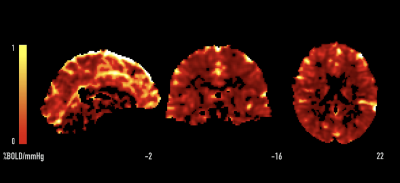 |
29 | Hypercapnic Normalization to Correct for Caffeine-Induced Changes in Task-Based BOLD fMRI Responses
Jacinta Specht, Rebecca Williams, Erin Mazerolle, G. Pike
This repeated-measures study sought to determine whether hypercapnic normalization can be used to address caffeine-induced vascular changes affecting BOLD responses. Visual/motor BOLD activation and cerebrovascular reactivity (CVR) under caffeine and placebo conditions were examined. CVR-correction was performed by dividing the task BOLD signal by CVR. Prior to CVR-correction, peak BOLD responses for both caffeine and placebo conditions were found in the visual cortex. After CVR-correction, peak responses were in the subcortical regions. Caffeine produced larger responses in the cerebellum compared to placebo, while subcortical activation was larger under placebo conditions. These results show that CVR-correction may benefit subcortical signal detection.
|
|
3709. 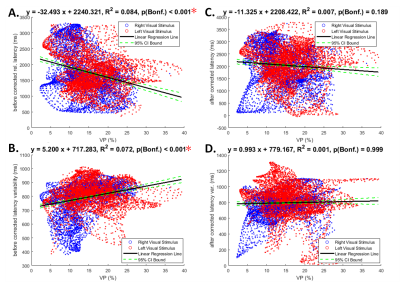 |
30 | The temporal stability of BOLD is improved by calibrating the cerebral vascular reactivity underpinned by the vascular probability within the group
Yi-Tien Li, Jacky Lu, Ren-Horng Wang, Pu-Yeh Wu, Ying-Hua Chu, Fa-Hsuan Lin
We hypothesize that the local venule vasculature underlies the BOLD signal latency and its variability. This hypothesis was tested by measuring the BOLD signal in the human primary visual cortex with a 10-Hz sampling rate during a visuomotor and a breath-holding (BH) task. A venule probability (VP) map was estimated by susceptibility-weighted images. We found that VP was significantly correlated to the relative BOLD latency and relative latency variability during the visuomotor task. These correlations disappeared after subtracting the latency in the BH task from the latency in the visuomotor task. These results support our hypothesis.
|
|
3710. 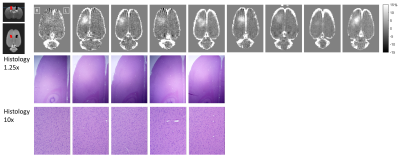 |
31 | The neurovascular response is attenuated by focused ultrasound-mediated disruption of the blood-brain barrier
Nick Todd, Yongzhi Zhang, Margaret Livingstone, David Borsook, Nathan McDannold
Focused ultrasound (FUS) disruption of the blood-brain barrier (BBB) is a promising technology for achieving targeted delivery of pharmacological agents into the brain. While the method has been shown to be safe from the standpoint of not damaging tissue cells, it causes other changes to local physiology that are not fully understood. This study aims to characterize the effects on the hemodynamic response that FUS BBB opening causes. We present BOLD and CBF fMRI results to investigate the particular mechanisms within the neurovascular response responsible for this effect.
|
|
3711. 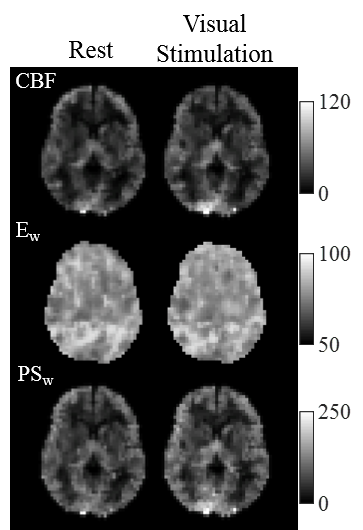 |
32 | Increased Blood-Brain Barrier Water Permeability in the Visual Cortex in Response to Visual Stimulation
Kenneth Wengler, Kwan Chen, Mark Schweitzer, Xiang He
Evidence of cell swelling upon activation has been observed in early diffusion functional MRI studies, and has been attributed to the co-transported water due to transient changes in ionic transmembrane flux. Blood-brain barrier (BBB) water permeability is also believed to be a marker of cerebral metabolism. Here we provide an initial investigation of visual stimulation on BBB water permeability parameters, water extraction fraction (Ew) and permeability surface area product (PSw), using the recently developed Intrinsic Diffusivity Encoding of Arterial Labeled Spins (IDEALS). Significant increase of PSw were observed with no change of Ew in the visual cortex during visual stimulation.
|
|
3712. 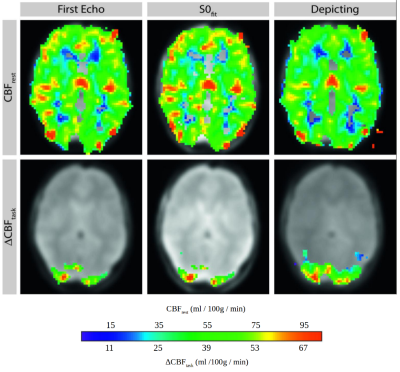 |
33 | Improved sensitivity for detecting functional CBF changes by center-out EPI with very short echo time
Ratnamanjuri Devi, Toralf Mildner, Kathrin Lorenz, Jöran Lepsien, Harald Möller
Compared to BOLD imaging, the detection of functional CBF changes by arterial spin labeling is difficult due to the inherently small signal changes in the range of one percent or less. We compared a multi-echo EPI readout to center-out EPI that achieves a very short TE. The reduction of the minimum TE from 9.3 ms (multi-echo EPI) to a value of 1.8 ms (center-out EPI) yielded significantly improved statistical power in the human visual cortex in addition to diminished confounding BOLD and physiological noise contributions.
|
|
3713. 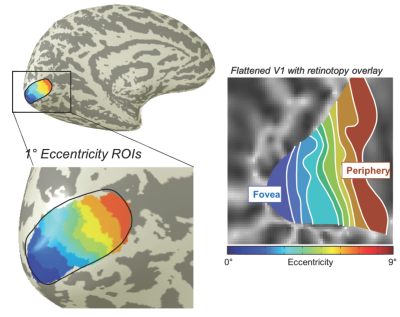 |
34 | Measurements and modeling of the negative hemodynamic response function in human early visual cortex
David Ress, Natasha DeLaRosa, Jung Hwan Kim
A negative BOLD response is often observed in early visual cortex. Previous measurements indicate that negative BOLD is the consequence of flow decreases. However, negative BOLD is usually evoked by blocked experimental designs that obscure details of their temporal dynamics. To understand the physiology of the negative BOLD, we used a slow event-related paradigm to elicit strong hemodynamic response functions (HRFs) in primary visual cortex as a function of eccentricity. We used a modified version of the Arterial Impulse Model to predict the neurovascular and neurometabolic mechanisms of negative BOLD. Results indicate that negative BOLD physiology is profoundly different than positive BOLD with greater non-linearity.
|
|
3714.  |
35 | Quantifying and Correcting for the Assumptions of the Static Dephasing Regime in Quantitative BOLD
Matthew Cherukara, Michael Chappell, Nicholas Blockley
The effect of diffusion is believed to cause underestimation of oxygen extraction fraction (OEF) in streamlined quantitative BOLD (qBOLD). We propose physically motivated modifications to the qBOLD model in order to account for this effect, and demonstrate, using Monte Carlo simulations, and analysis of healthy in vivo data, that simple scalar corrections to the inferred reversible relaxation rate ,
can substantially reduce the error in OEF and deoxygenated blood volume (DBV) estimation. These corrections have the potential to be improved further by taking other physiological and acquisition-related parameters into account.
|
|
3715. 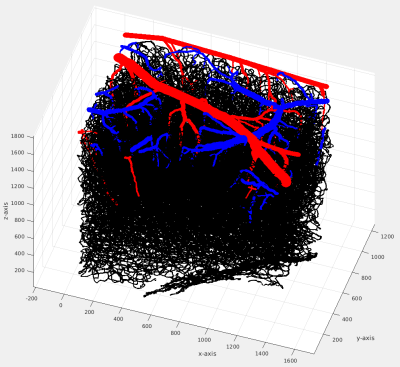 |
36 | Quantification of draining vein dominance across cortical depths in BOLD fMRI from first principles using realistic Vascular Anatomical Networks
Joerg Pfannmoeller, Avery Berman, Sreekanth Kura, Xiaojun Cheng, David Boas, Jonathan Polimeni
The neuronal specificity of gradient echo (GE) BOLD is diminished by the extravascular signal from large draining veins, whose contribution can be reduced by using small voxel sizes and sampling far away from the cortical surfaced. Here we use simulations of the GE-BOLD signal based on a realistic vascular network (VAN) to quantify the extent of the pial vein dominance into the cortex field strengths between 7 and 14 Tesla. We estimate a pial vessel dominance down to a depth of 800 μm at 14 Tesla in humans, suggesting that small GE-BOLD voxels below this depth can be immune to the effects of these surface vessels.
|
|
3716. 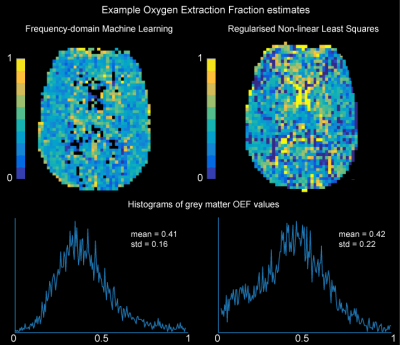 |
37 | A frequency-domain machine learning (FML) method for dual-calibrated estimation of oxygen extraction fraction (OEF) and cerebral metabolic rate of oxygen metabolism (CMRO2)
Michael Germuska, Hannah Chandler, Rachael Stickland, Catherine Foster, Jessica Steventon, Valentina Tomassini, Kevin Murphy, Richard Wise
A frequency-domain machine learning method is presented that significantly reduces the bias and variance in dual-calibrated estimation of oxygen extraction fraction, as demonstrated with simulation and in-vivo imaging. In addition, the method substantially reduces the processing time compared to previous robust analysis methods.
|
|
3717. 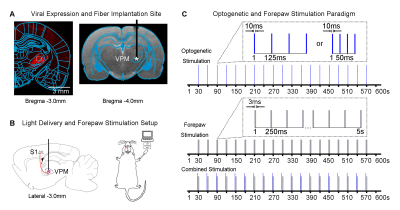 |
38 | fMRI investigation of the role of interhemispheric interactions in cortical sensory processing
Eddie Wong, Alex Leong, Xunda Wang, Celia M. Dong, Ed Wu
Effective sensory communications require massive interconnected interhemispheric cortico-cortical projections. However, little is known at present regarding the exact interactions that occur bilaterally between sensory cortices across the brain hemispheres and how they influence cortical processing. Here, we employ optogenetic stimulation of the whisker-related thalamic excitatory neurons in combination with the somatosensory forepaw stimulation. We demonstrate a novel platform to investigate the interhemispheric interactions underlying cortical sensory processing.
|
|
3718. 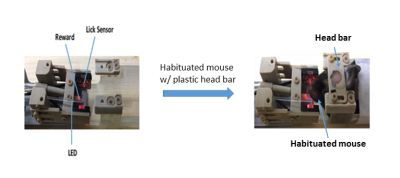 |
39 | Elevated activation of a murine limbic network during cue-reward association learning revealed in 15.2 T fMRI
Keisuke Sakurai, Shota Ando, Chihiro Takahashi, Teppei Shintani, Wonbeom Jung, Dinh Anh, Chanhee Lee, Yunbok Kim, Seong-Gi Kim, Tatsuhiro Hisatsune
An operant learning device for head-fixed mouse was developed for ultra-high field (15.2 Tesla) fMRI. Habituated mice were learned to water reward, associated with cue of light stimulation as a conditioning stimulus. We obtained 1,000 sets of BOLD fMRI (GE-EPI, TR/TE = 1000/11 ms), and found that elevated activation of a limbic learning network, including the entorhinal, perirhinal, and retrosprenial cortices and the hippocampal formation, during cue-reward association in learned mice.
|
|
3719 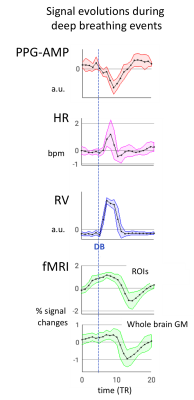 |
40 | Sympathetic contribution of respiratory effects to the fMRI signal Video Permission Withheld
Pinar Ozbay, Catie Chang, Jacco de Zwart, Peter van Gelderen, Jeff Duyn
fMRI signal covariation with fluctuations in systemic physiology, including cardiac rate and respiration, is well established. Recent work showed strong correlations between peripheral vascular tone, a proxy for sympathetic activity, and fMRI global signal during drowsiness and sleep. As sympathetic activity may also be triggered by inspiration, even during the alert waking condition typical of task fMRI, we investigated the relationship between respiration, peripheral vascular tone, and fMRI signal during a visual task.
|
|
3720. 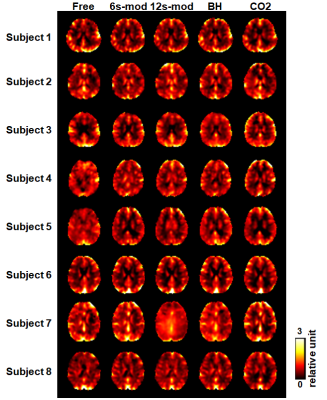 |
41 | Cerebrovascular Reactivity (CVR) mapping using intermittent breath modulation
Peiying Liu, Cuimei Xu, Hanzhang Lu
Cerebrovascular reactivity (CVR) mapping is typically performed using CO2-inhalation or breath-holding as a vasoactive challenge while collecting BOLD images. Recently, resting-state BOLD has been used to map CVR by utilizing spontaneous fluctuations in breathing pattern, but the results could be noisy in subjects with little fluctuation in their spontaneous breathing. Here we developed a new technique for CVR mapping that does not require gas-inhalation yet provides substantially higher sensitivity than resting-state CVR mapping. This new technique is largely based on resting-state scan, but introduces intermittent modulation of breathing pattern in the subjects to enhance fluctuations in their end-tidal CO2 level.
|
|
3721 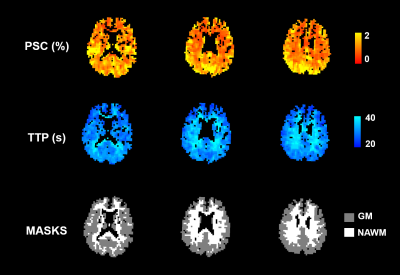 |
42 | Breath-hold BOLD-fMRI cerebrovascular reactivity metrics predict cognitive impairment in cerebral small vessel disease Video Permission Withheld
Joana Pinto, Tânia Charrua, Ana Fouto, Luísa Alves, Sofia Calado, Carina Gonçalves, Margarida Rebolo, Miguel Baptista, Pedro Vilela, Rita Nunes, Patrícia Figueiredo
Cerebral small vessel disease (SVD) is associated with an increased risk of stroke and dementia, being implicated in age-related cognitive decline. In this work, we investigate the potential of cerebrovascular reactivity (CVR) to provide sensitive biomarkers of SVD, by evaluating metrics extracted from breath-hold BOLD-fMRI in terms of their predictive power of cognitive impairment in a group of SVD patients. We modelled the breath-hold BOLD-fMRI response using a sinusoidal approach, and derived both CVR amplitude and delay-based maps. Multiple linear regression analysis showed that CVR metrics significantly contributed to explain cognitive impairments in working memory, long-term memory and executive function.
|
|
3722. 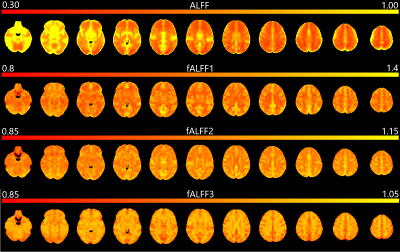 |
43 | Amplitude of low-frequency fluctuations in resting-state BOLD-fMRI is associated with cognitive decline in cerebral small vessel disease
Joana Moreira, Joana Pinto, Ana Fouto, Luísa Alves, Sofia Calado, Carina Gonçalves, Margarida Rebolo, Pedro Vilela, Miguel Baptista, Patrícia Figueiredo
Cerebral small vessel disease (SVD) is a major vascular contributor to dementia and stroke, being associated with age-related cognitive decline. In this work, we aim to assess the potential of spontaneous BOLD fluctuations metrics to predict cognitive impairment in a group of SVD patients, therefore providing sensitive SVD biomarkers. The amplitude of low-frequency fluctuations (ALFF) and fractional ALFF (fALFF) were computed in four different frequency bands as metrics of spontaneous BOLD signal fluctuations. Results from multiple linear regression analyses demonstrated that spontaneous BOLD fluctuations metrics contribute to the prediction of cognitive impairment in executive function, processing speed and working memory.
|
|
3723. 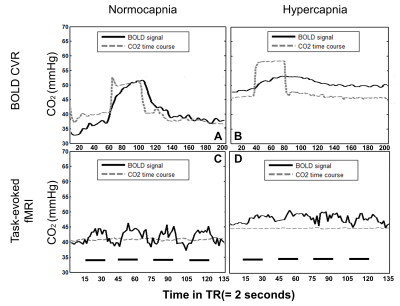 |
44 | Voxel-wise analysis of functional MRI activation in regions of provoked impaired cerebrovascular reactivity: a translational model
Marco Piccirelli, Christiaan Hendrik Bas van Niftrik, Giovanni Muscas, Martina Sebök, Joseph Arnold Fisher, Oliver Bozinov, Antonios Valavanis, Luca Regli, Christoph Stippich, Jorn Fierstra
A voxel-wise investigation of the relationship between the cerebrovascular reactivity (BOLD-CVR) alteration and the task-evoked Blood-oxygenation-level dependent functional MRI (BOLD-fMRI) challenges the commonly accepted linear and global correction method used. Our controlled CVR modulation in healthy subjects is a good investigation translational model for patients affected with glioblastomas or stroke.
|
|
3724. 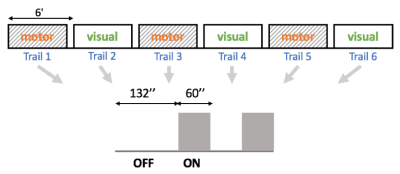 |
45 | Cerebral blood flow affected by the order of functional tasks Presentation Not Submitted
Yaoyu Zhang, Jia-Hong Gao
This study investigates the order effect of functional task-induced CBF responses. ASL sequence was implemented to quantify CBF responses to the same task but in paradigms of different task orders in both the motor and visual cortices. Results of the study show an order effect in which that the greater the work load of the prior task, the greater influence it can exert on the CBF response of the posterior task. This study emphasizes the importance of the randomized task design and gives insight on underlying task-induced CBF response mechanisms.
|
|
3725. 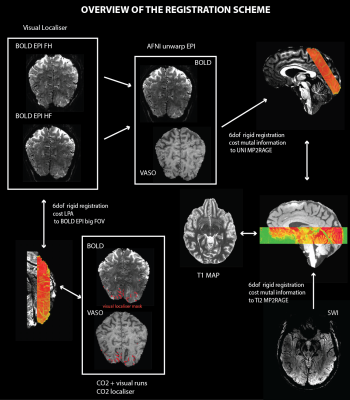 |
46 | VASO signal decreases associated with BOLD increases: a possible role of CSF volume redistribution
Marcello Venzi, Joseph Whittaker, Laurentius Huber, Kevin Murphy
Using manipulations of the arterial tension of carbon dioxide, we demonstrate that the paradoxical decrease in CBV associated with BOLD increases is restricted to voxels with large proportions of CSF. Excluding those voxels , we show that visual responses during hypercapnia have no change in amplitude in VASO and BOLD contrasts, but the time-to-peak of BOLD responses lengthens and CBV peak times, being longer at baseline, remain the same.
|
|
3726. 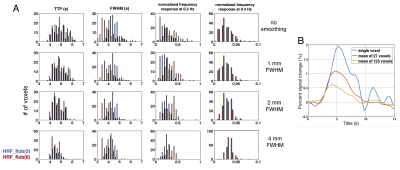 |
47 | Fast fMRI responses supported by inter-voxel variability of hemodynamic response functions
Jingyuan Chen, Jonathan Polimeni, Nina Fultz, Gary Glover, Laura Lewis
In this abstract, we use very high-resolution fMRI to evaluate inter-voxel variability of hemodynamic response functions (HRF) elicited by a visual task. We show that HRFs exhibit wide variability across voxels, with a subset of HRFs occurring at temporal scales much faster than the canonical HRF, which we consider as one mechanism that underlie fast neural-activity-related dynamics. Influence of spatial resolution on HRF dynamics are also evaluated, we show that the use of small voxels (without spatial averaging) sampling parenchymal signals may enable faster observed hemodynamics.
|
|
3727. 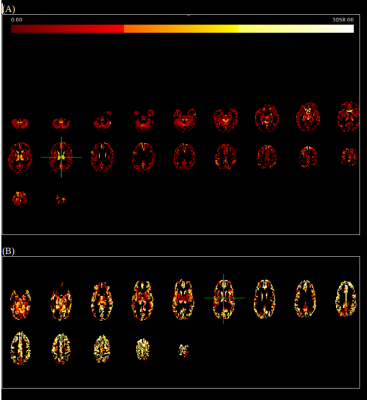 |
48 | Title: A Closer Look at the Vascular Component of Hemodynamic Response Function and Its Variations by Aging
Azin Esmaelbeigi, M. Aras Kayvanrad, J.Jean Chen
It has been shown that the brain vasculature changes with aging. The unhealthy brain vasculature is associated with risks of a lot of conditions such as stroke and ischemic attacks. Moreover, some studies have confirmed the causality of the impaired vasculature and the diseases of aging such as Alzheimer’s disease. Herein, we study the effect of aging on the vascular component of the hemodynamic response function. The results demonstrated narrower and more positively skewed distributions of peak spectral power in older controls which indicate degradation in some regions of the brains of the older adults.
|
|
3728. 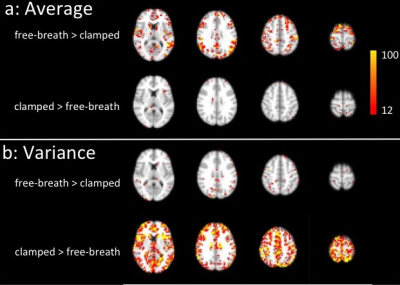 |
49 | The Effect of End-tidal PETCO2 Clamping on Resting-state fMRI Connectivity
Ali Golestani, J. Jean Chen
The pressure of end-tidal CO2 (PETCO2) has a significant impact on the blood oxygenation level dependent (BOLD) signal and clamping it leads to detecting additional brain activation in task-based fMRI. However, the effect of PETCO2 clamping on the resting state connectivity has not been yet investigated. In this study we compared whole brain connectivity patterns of 13 healthy subjects during free-breathing and clamped PETCO2. Results showed clamping the PETCO2 removes the global and widespread effect of PETCO2 fluctuation in the gray matter, leading to weaker connectivity and more between-subject variability in the connectivity values.
|
|
3729. 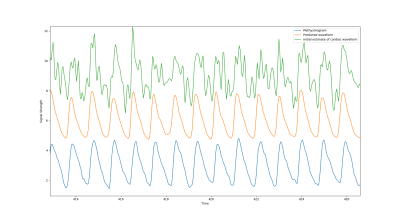 |
50 | Deriving cardiac waveforms from fMRI data using slice selective averaging and a deep learning filter.
Serdar Aslan, Blaise Frederick
This work is a new technique to find Cardiac waveform from the fMRI data. For that purpose, a three stage data analysis is performed. In the first two stages, a candidate signal is derived by averaging over the voxels in every slice and combining them with proper time delays and resampling to 25Hz. As the third stage a deep learning architecture is used to improve the signal quality. The reconstructed signal is a good estimate of the plethysmogram data which is collected simultaneously with fMRI data.
|
Multimodal fMRI
Digital Poster
Digital Poster
fMRI
Wednesday, 15 May 2019
| Exhibition Hall | 13:30 - 14:30 |
| Computer # | |||
3730. 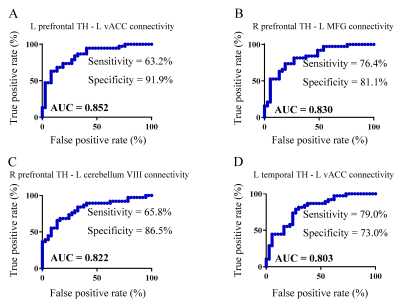 |
51 | Sensorineural hearing loss and cognitive impairments : contributions of thalamus using multimodal MR Presentation Not Submitted
Xiao-Min Xu, Gao-Jun Teng
In present study, we systematically investigated the structure, function and perfusion features of the TH and its seven subdivisions through multimodal MRI, aiming to uncover the potential role of the TH in SNHL and its correlations with cognition measurements.
|
|
3731.  |
52 | Altered Brain Structure and Function Correlate with Disease Severity and Affective Disorders in Patients with Hemifacial Spasm Presentation Not Submitted
Yuan Wang, Hui Xu, Chenguang Guo, Ming Zhang
Hemifacial spasm (HFS) is characterized by unilateral and paroxysmal contraction of orofacial muscles. A group of HFS patients and healthy controls underwent MRI examination and clinical assessment for facial spasm and affective disorders. HFS patients showed thickened left fusiform in cortex along with reduced subcortical volume in the right amygdala. Increased amygdala-driven connections were revealed to the bilateral superior frontal gyrus (SFG) and orbital gyrus (OG), and increased functional connectivity (FC) was detected of fusiform seed to several subregions of frontal lobe. These altered FC changes were associated with certain clinical indices, providing new insight into pathophysiology of the disease.
|
|
3732. 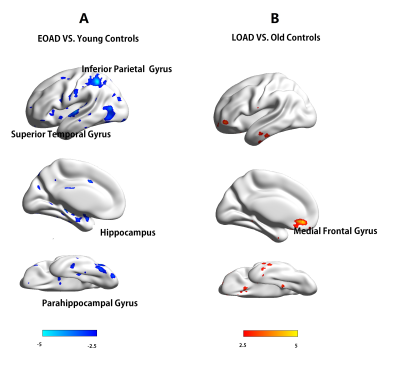 |
53 | Distinct Patterns of Interhemispheric Connectivity in Patients with Early- and Late-Onset Alzheimer’s Disease
Kaicheng li, Xiao Luo, Qingze Zeng, Peiyu Huang, Yong Zhang, Min-Ming Zhang
Early-onset Alzheimer’s disease (EOAD) presents a different clinical profile than late-onset Alzheimer’s disease (LOAD). We used voxel-mirrored homotopic connectivity (VMHC) to examine interhemispheric functional connectivity and tract-based spatial statistics (TBSS) to reflect the diffusion index. We found EOAD patients exhibited more widely disrupted interhemispheric functional and structural connectivity, which related to executive deficits. Our study suggested that different interhemispheric connectivity damage patterns may contribute to the distinctclinical profiles in EOAD and LOAD.
|
|
3734. 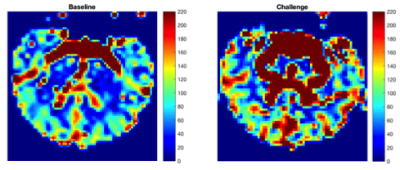 |
54 | IVIM-based cerebral perfusion (in ml/100g/min) values at rest, hypercapnia and ischemia in an MCA occlusion model
Mira Liu, Yong Jeong, Niloufar Saadat, Gregory Christoforidis, Timothy Carroll
This is a preliminary study of intravoxel incoherent motion (IVIM) in a two day study of normocapnia, hypercapnia, and post middle cerebral artery occlusion. It was established that IVIM perfusion values are linearly correlated to the reference perfusion values under a variety of physiologic states meaning IVIM perfusion values can be easily quantified. Once scaled, the IVIM CBF of white matter and grey matter normocapnia and post-occlusion cortex on both hemispheres were strongly correlated to the reference standard.
|
|
 |
3735.  |
55 | Mapping Brain Neurochemical and Functional Coupling Using Dynamic SPICE
Rong Guo, Yudu Li, Yibo Zhao, Yao Li, Zhi-Pei Liang
Neuronal metabolite (e.g., glutamate, GABA) concentrations in the brain are known to be correlated with neural activity. Currently, fMRS is the primary tool for measuring neurochemical changes in response to brain activity. However, fMRS has several major practical limitations, including low spatial resolution, low SNR, and very limited brain coverage. In this work, a new dynamic 1H-MRSI technique is used to address these difficulties. This technique can map dynamic metabolic changes from the whole brain at high spatial and temporal resolutions. In addition, it can simultaneously acquire fMRI images to track brain functional activity during the scan. With this unique capability, we have carried out functional MRSI experiments with motor tasks to investigate the coupling between neural metabolism and neural activity. The experimental results clearly show an increase in Glx in the motor cortex during the motor activation.
|
3736. 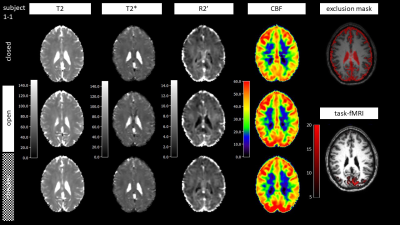 |
56 | Quantitative functional imaging of visual cortex activity in humans using multi-parametric blood oxygenation level dependent MRI
Christine Preibisch, Stella Koutsouli, Stephan Kaczmarz, Samira Epp, Valentin Riedl
Blood oxygenation level dependent (BOLD) functional magnetic resonance imaging (fMRI) is widely used to assess local neuronal activity. However, the absolute metabolic demand related to BOLD-signal change is still largely unknown. In the current study we investigated the feasibility of multi-parametric quantitative BOLD (mq-BOLD) measurements to detect changes in tissue oxygenation in healthy, cortical gray matter during different states of visual stimulation. Our results show that mq-BOLD measurements are well feasible for standard activation paradigms. However, subject motion and transient states of brain activation might impact on quantitative parameter mapping due to longer acquisition times.
|
|
3737. 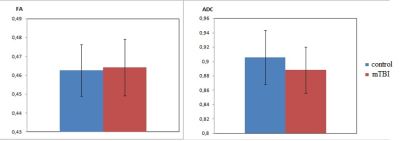 |
57 | Dysfunction of functional connectivity between default mode network and cerebellar structures in patients with mTBI in acute stage. rsfMRI and DTI study.
Maxim Ublinskiy, Natalia Semenova, Tolib Akhadov, Andrei Manzhurtsev, Petr Menshchikov, Dmitriy Kupriyanov
The revealed changes in DMN neuronal connection and cerebellar regions in acute stage of mTBI patients can be an initial step of damages leading to cognitive deficit which can be developed in future in long-term period of injury. We suggest that further research in this direction will demonstrate whether DMN functional integrity analysis can serve as a biomarker for monitoring the recovery of patients with mTBI.
|
|
3738. 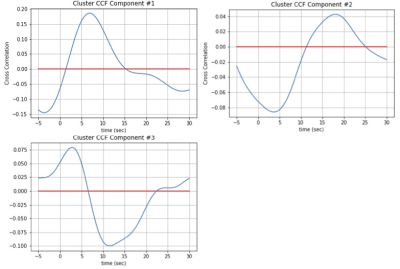 |
58 | Towards a more precise and comprehensive characterization of the relationship between EEG alpha rhythm and thalamic BOLD signal
SeyedMohammad Shams, Pierre LeVan, J. Jean Chen
In this study, the relationship between EEG alpha band power and the BOLD signal is examined in the thalamus. We overcome previous limitations in temporal resolution by using fast fMRI (MREG) acquisitions. We also consider a wider range of lags between EEG and BOLD signals than previous studies. In addition, cross correlations between alpha EEG and fMRI signals from all voxels in the thalamus region of all subjects are automatically classified using clustering to reveal consistent spatial-temporal patterns in the relationships between EEG alpha activity and BOLD signals in different parts of thalamus.
|
|
3739. 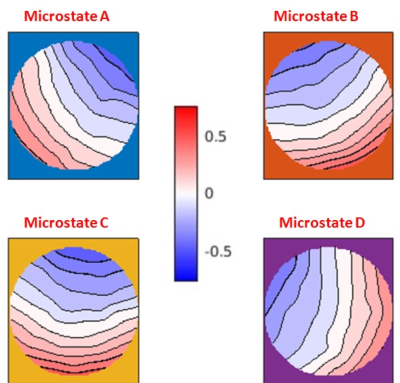 |
59 | Connectivity in the Default Mode Network of Schizophrenic Patients Investigated with Microstates and mGluR5 Receptor Availability Using Simultaneously Recorded Trimodal ([11C]ABP688-PET/MR/EEG) Imaging
Ravichandran Rajkumar, Claudia Régio Brambilla, Joshua Bierbrier, Shukti Ramkiran, Linda Orth, Andrej Ruch, Andreas Matusch, Markus Lang, Lutz Tellmann, Ezequiel Farrher, Jörg Mauler, Elena Rota Kops, Jürgen Scheins, Bernd Neumaier, Johannes Ermert, Hans Herzog, Karl-Josef Langen, Christoph Lerche, N. Jon Shah, Irene Neuner
This exploratory study aims at underpinning the relationship between functional connectivity (fMRI), microstates (EEG) and glutamatergic receptor (mGluR5) availability ([11C]ABP688-PET) in healthy controls (HC) and schizophrenic (SZ) patients using simultaneously acquired trimodal (PET/MR/EEG) data. The single modality results show hyperactivity in vDMN regions of SZ patients (fMRI), a significant decrease in volume of distribution (Vt) of SZ patients (non-smoker group), and increased microstate global field power (GFP) in SZ patients. Correlations between Vt and GFP did not reveal any significant results, but the trend suggests a strong influence of smoking status and its association with global reductions in mGluR5 availability.
|
|
3740.  |
60 | Detection of oscillatory event-related visual potentials and BOLD signals using interleaved simultaneous multi-slice inverse imaging and electroencephalography
Shu-Yu Huang, Yi-Tien Li, Ying-Hua Chu, Kevin Wen-Kai Tsai, Guan-Yi Lu, Wen-Jui Kuo, Fa-Hsuan Lin
We propose to interleave simultaneous multi-slice inverse imaging (SMS-InI) concurrently with EEG. In this way, EEG recorded with gradient-artifact-free intervals (1.9
|
|
3741. 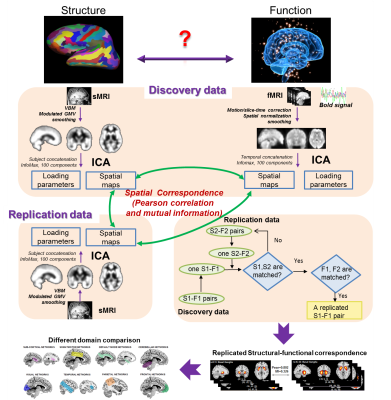 |
61 | Correspondence between structure and function in the human brain using data from over 15,000 individuals
Na Luo, Jing Sui, Jessica Turner, Zening Fu, Anees Abrol, Eswar Damaraju, Jiayu Chen, Dongdong Lin, David Glahn, Amanda Rodrigue, Vince Calhoun
This study compared the structural-functional correspondence on a large discovery dataset (7104 functional scans, 6005 structural scans) and a replication dataset (9214 subjects). Independent component analysis was applied to identify structural and functional networks. Spatial correlation was then computed using Pearson correlation and mutual information. Results indicated that 1) 24 replicated pairs were identified showing high structural-functional correspondence; 2) the structural-functional correspondence showed the following hierarchy: Basal ganglia > Somatomotor, Visual > DMN, Temporal, Cerebellum > Frontal and Parietal domains; 3) replicated results allowing us to provide evidence of a stable template of structural-functional correspondence for the public to use.
|
|
3742. 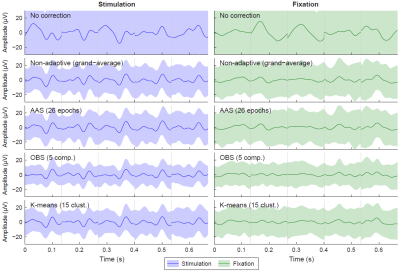 |
62 | On the variability of cardiac pulse artifacts across heartbeats affecting EEG recordings in simultaneous EEG-fMRI: a 7T study
João Jorge, Charlotte Bouloc, Lucie Bréchet, Christoph Michel, Rolf Gruetter
EEG recordings performed in MRI scanners suffer from complex artifacts caused by heart function, termed pulse artifacts (PAs), which can strongly compromise EEG quality. This study investigated the properties and mechanisms of PA variability across heartbeats, which remains poorly understood. Simultaneous EEG-fMRI was performed at 7T on healthy participants with concurrent breathing and cardiac recordings. PA variability showed an important impact on EEG quality, and was linked not only to changes in head position/orientation across time, but also, and more importantly, to respiration and heart rate. These findings have important consequences for PA correction, highly relevant to most EEG-fMRI applications.
|
|
3743. 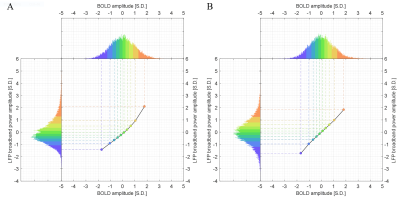 |
63 | The Relationship between Local Field Potential and Blood-oxygenation-level Dependent Signal Can Be Nonlinear
Xiaodi Zhang, Wen-Ju Pan, Shella Keilholz
Many studies that involve simultaneous local field potential (LFP) and blood-oxygenation-level dependent (BOLD) signal measurements use correlation analysis, which assumes a linear relationship between the two. To experimentally determine whether the relationship is linear, we obtained a LFP vs BOLD response curve from simultaneous LFP and BOLD measurements. The relationship between the two was nonlinear under isoflurane but not under dexmedetomidine, which suggests that correlation may not always correctly capture the relationship between LFPs and BOLD.
|
|
3744. 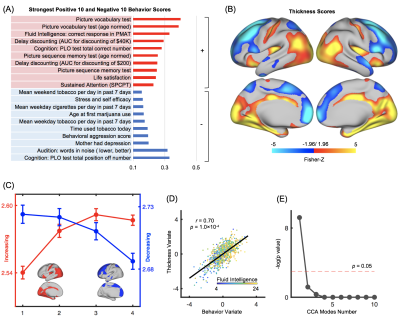 |
64 | Divergent structural and functional changes across brain hierarchy account for population variation in demographics and behavior
Feng Han, Xiao Liu
A robust link was recently established between resting-state functional connectivity and human behavioral measures. To understand the structural basis underlying this relationship, we examined the population covariation of the cortical thickness, resting-state connectivity, and a set of demographic and behavioral measures. We found that divergent changes at the lower- and higher-order brain regions in the cortical thickness and resting-state connectivity are structural and functional imaging features that are most tightly linked to the population behavioral variation. The findings suggest that differentiated changes across brain hierarchy could be important to brain function.
|
|
3745. 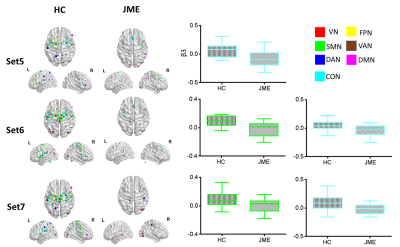 |
65 | Rhythmic EEG inputs modulate the thalamocortical network in epilepsy Presentation Not Submitted
Yun Qin, Zhiliang Li, Tao Zhang, Cheng Luo, Dezhong Yao
Thalamus has the capacity to generate oscillations characterized by different frequency and levels of synchrony. However, little is known of what function the generated EEG dynamic pattern may serve in thalamocortical interactions. In this study, we used psychophysiological interaction framework to detect fMRI thalamocortical coupling modulated by dynamic EEG connectivity patterns, and tested the alteration of the modulatory couplings in juvenile myoclonic epilepsy. The results found frequency-dependent characteristics for the thalamocortical coupling. The group comparison revealed the couplings were altered with certain thalamus sets involved in JME, which may have implications for better understanding of the thalamocortical circuit influenced by epileptic activity.
|
|
3746. 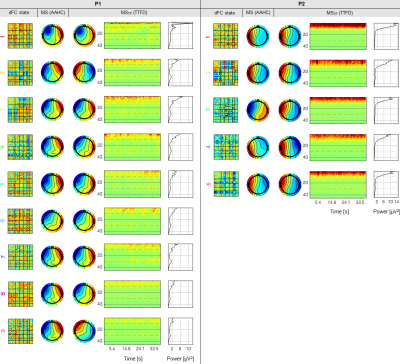 |
66 | Classification of BOLD-fMRI dynamic functional connectivity states based on simultaneous EEG microstates
Rodolfo Abreu, Alberto Leal, Patrícia Figueiredo
Dynamic functional connectivity (dFC) states have been identified in BOLD-fMRI data, but their electrophysiological underpinnings remain a matter of debate. The simultaneous acquisition of the EEG has previously allowed the identification of EEG signatures of dFC states. Here, we further investigated whether EEG microstates can be used to classify dFC states. We found that highly accurate classification could be achieved based on the three EEG microstates with the highest global explained variance, in simultaneous EEG-fMRI data acquired from eight epileptic patients. These results further support the electrophysiological underpinnings of fMRI dFC states, highlighting their relationship with EEG-derived microstates.
|
|
3747. 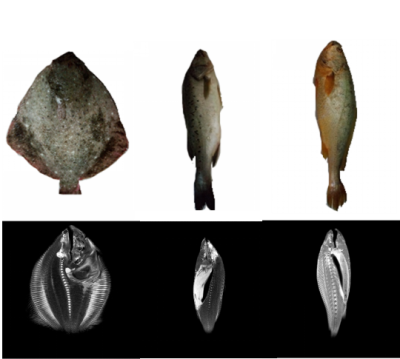 |
67 | Adipose Tissue Evaluation in Economic Fish with MRI Imaging Translation via Conditional Generative Adversarial Networks Presentation Not Submitted
rui nian, shuang kong, shichang zhang*, xiaoyu li, qiang yuan
High presence of excess fat makes strong implications in obesity and its complications. High-fat diet could trigger fat accumulation. In this paper, we investigated and developed one quantitative online assessment strategy for adipose tissues in economic fish with Conditional Generative Adversarial Networks (CGAN) by means of magnetic resonance imaging (MRI), which could automatically help insights into the morphology of the adipose tissues in fish.
|
|
3748.  |
68 | BOLD Representation of Canonical EEG Microstates
Obada Al Zoubi, Ahmad Mayeli, Masaya Misaki, Vadim Zotev, Aki Tsuchiyagaito, Jared Smith, Hazem Refai, Martin Paulus, Jerzy Bodurka
We extracted the topographical similarity of EEG signals with four canonical EEG microstate (EEG-ms, A through D) templates from 47 healthy subjects. Then, a general linear model (GLM) examined topographical similarities using time courses convolved with hemodynamic response function (HRF) as regressors of interest for individual subjects. A one-sample t-test was applied
|
|
3749 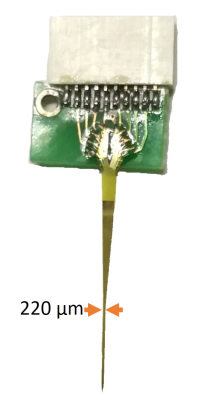 |
69 | Evaluation of a flexible polyimide-based microelectrode array for MR-compatibility and recording performance in 7T research system Video Permission Withheld
Xiao Yu, Bo-Wei Chen, Boyi Qu, Tingting He, You-Yin Chen, Hsin-Yi Lai
For simultaneous recording of spike signal and functional magnetic resonance imaging (fMRI) response, both MR-compatibility and performance of electrophysiological signal acquisition of the electrode matters. Previously, we have designed a flexible polyimide-based microelectrode array which has good biocompatibility, as well as high and stable signal-to-noise ratio for chronic recording. This study evaluated the MR-compatibility and recording performance of microelectrode array in the 7T research system (Siemens, Erlangen, Germany). The results suggest that it has the potential to facilitate simultaneous spike-recording during MR scanning in 7T.
|
|
3750.  |
70 | Line Scanning fMRI combined with optical calcium recordings to resolve the direct BOLD response to underlying slow oscillation-associated traveling waves
Dirk Cleppien, Felipe Aedo-Jury, Miriam Schwalm, Nuse Afahaene, Albrecht Stroh
In this multimodal approach consisting of line scanning (ls)-fMRI combined with optical calcium recordings, we investigated the direct BOLD response on a sensory stimulus in the slow wave brain state in anesthetized rats. We were able to observe the fMRI correlate of a slow wave recruiting the field of view with a significant latency between the recruitment of posterior and anterior voxels. This latency suggest the identification of the propagation of slow waves, as described with optical methods.
|
|
 |
3751. 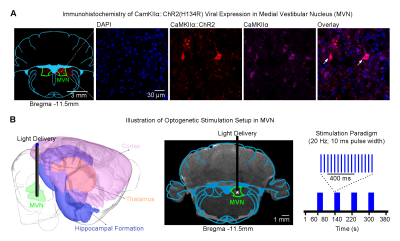 |
71 | Optogenetic fMRI of large-scale vestibular system and their cross-modal functions
Alex T. L. Leong, Yong Gu, Xunda Wang, Russell W. Chan, Ying-Shing Chan, Ed X. Wu
The vestibular system - pivotal for our sense of balance and orientation - integrates input from our other dominant senses, such as audition and vision, to create a multisensory percept. However, little is known regarding the extent of modulatory effects (if any) that the vestibular system exerts on the other sensory processing. Here, our report combined fMRI, optogenetics and sensory stimuli to provide large-scale brain-wide insights into the extent of cross-modal modulatory effects of the vestibular system on sensory processing. We reveal that vestibular nucleus optogenetic stimulation can modulate auditory and visual sensory processing at midbrain, thalamic and cortical regions.
|
 |
3752. 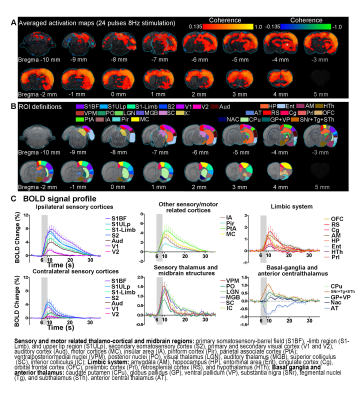 |
72 | Optogenetically-evoked spindle-like activity from thalamus propagates brain-wide and enhances rsfMRI connectivity
Xunda Wang, Alex T. L. Leong, Shuai Guo, Celia M. Dong, Ed X. Wu
Hierarchical nesting of spindles and slow oscillations have been identified as a unique characteristic for long-range functional neural integrations in
|
3753. 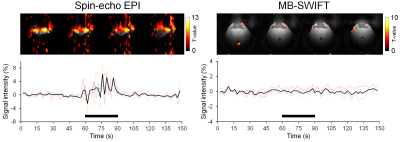 |
73 | Towards artefact-free awake rat brain fMRI/EEG studies with multiband-SWIFT fMRI
Jaakko Paasonen, Hanne Laakso, Tiina Pirttimäki, Petteri Stenroos, Lauri Lehto, Michael Garwood, Shalom Michaeli, Djaudat Idiyatullin, Silvia Mangia, Olli Gröhn
EPI sequence is the most common choice for fMRI investigations. EPI, however, is loud for awake studies, prone to susceptibility-induced artefacts, and sensitive to motion. Therefore, we investigated whether the unique features of MB-SWIFT would make it a potential alternative for EPI to overcome these issues. Our results suggest that MB-SWIFT is dramatically more silent compared to EPI, body movement does not affect the voxels in brain, gradient-switching artefacts are minimal in electrophysiological data, and good quality resting-state fMRI data can be obtained from awake rats. We conclude that MB-SWIFT is an advantageous alternative to EPI in demanding experimental applications.
|
|
3754. 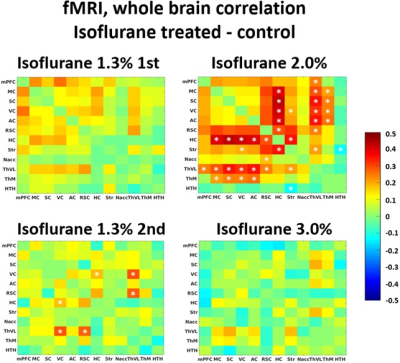 |
74 | Long-term effect of isoflurane anesthesia on functional connectivity detected by fMRI and local field potential measurements
Petteri Stenroos, Tiina Pirttimäki, Jaakko Paasonen, Raimo Salo, Ekaterina Zhurakovskaya, Heikki Tanila, Olli Gröhn
Isoflurane, a commonly used anesthetic in preclinical studies, is known to alter functional connectivity during anesthesia. It has been found that isoflurane can induce brain plasticity and cause long-term changes on brain function. Therefore, we studied the connectivity changes caused by single isoflurane (3h, 1.8%) exposure after a one-month waiting period by resting state fMRI and local field potential (LFP) measurements. Treated rats exhibited significantly strengthened connectivity between hippocampus and somatosensory cortex both in fMRI and LFP, indicating long-term modulation of brain activity by single administration of isoflurane anesthesia compared to non-treated controls.
|
fMRI Contrast Mechanisms & Signal Characteristics
Digital Poster
Digital Poster
fMRI
Wednesday, 15 May 2019
| Exhibition Hall | 13:30 - 14:30 |
| Computer # | |||
3755. 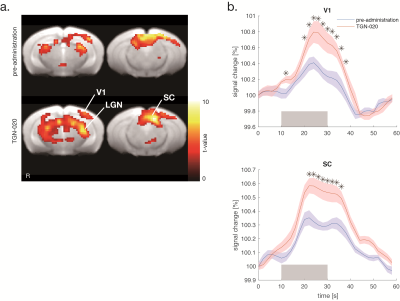 |
76 | Blocking AQP4 channels impacts BOLD fMRI but not Diffusion fMRI response patterns induced by visual stimulation
Yuji Komaki, Clément Debacker, Boucif Djemai, Luisa Ciobanu, Tomokazu Tsurugizawa, Denis Bihan
We compared BOLD and Diffusion fMRI mouse brain maps obtained through visual stimulation before and after TGN-020 administration, an AQP4 receptor antagonist and astrocyte swelling inhibitor. Activations were observed in the primary visual cortex and the superior colliculus with both methods. BOLD signal changes were significantly increased after AQP4 inhibition, while the DfMRI signals were not affected. These results suggest that the DfMRI signal does not originate from astrocyte swelling.
|
|
3756. 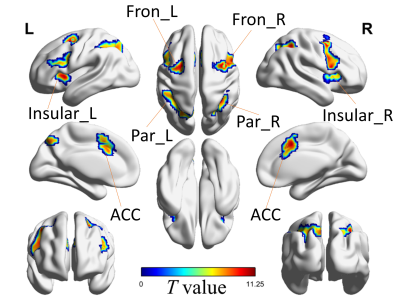 |
77 | Hemodynamic response of white matter to event-related functional tasks Presentation Not Submitted
Muwei Li, Zhaohua Ding, John Gore
There is increasing evidence that white matter (WM) elicits robust blood oxygenation level-dependent (BOLD) responses to
|
|
3757. 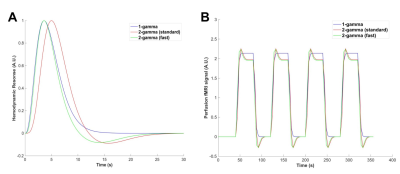 |
78 | Improved Selection of Hemodynamic Response Function in ASL Based Perfusion fMRI
Qingfei Luo, Wen-Ming Luh, Jerzy Bodurka
Two types of hemodynamic response function (HRF) are used in the data analysis of ASL based perfusion fMRI (ASL-fMRI): single gamma function (1-gamma) and the sum of two gamma functions (2-gamma). This study aims to optimize the selection of HRF by comparing the performances of standard 1-gamma and 2-gamma HRFs and also a modified 2-gamma HRF, which has earlier response peak time than the standard one. Our visual ASL-fMRI experiment indicate that the modified 2-gamma provides the best detection sensitivity and we recommend to use it in ASL-fMRI.
|
|
3758. 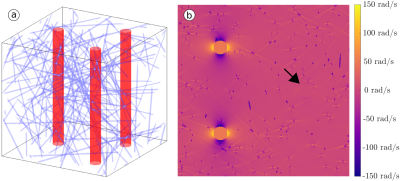 |
79 | The role of perivascular spaces in white matter blood oxygenation level dependent MRI
Jonathan Doucette, Laura Kim, Enedino Hernández-Torres, Friedrich Anastasopoulos, Christian Kames, Alexander Rauscher
Using vascular parameters obtained from dynamic susceptibility contrast MRI, the gradient echo and spin echo blood oxygenation level dependent (BOLD) signals were simulated at 3 and 7T in order to investigate the effects of tissue orientation and perivascular spaces. We show that both the magnitude and the tissue orientation dependence of the BOLD effect is amplified by perivascular spaces.
|
|
3759. 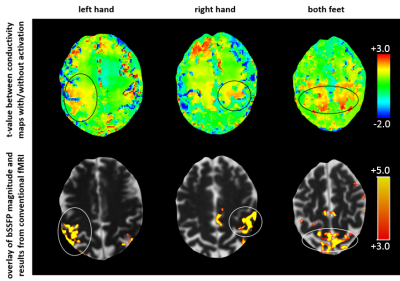 |
80 | Electrical Properties Tomography based Functional Magnetic Resonance Imaging (EPT-fMRI)
Michael Helle, Ulrich Katscher
This study presents a new approach for the assessment of functional brain areas by using Electrical Properties Tomography (EPT). The measurements are performed similarly to conventional fMRI experiments to investigate brain activation for primary motor cortex areas, whereas EPT maps are generated for activation and resting periods and compared to BOLD fMRI images.
|
|
3760. 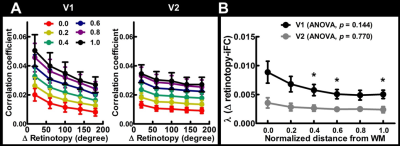 |
81 | Cortical depth- and feature-dependent intrinsic functional connectivity in human visual and auditory cortices
Pu-Yeh Wu, Hsin-Ju Lee, Jyrki Ahveninen, Jonathan Polimeni, Hesheng Liu, Wen-Jui Kuo, Fa-Hsuan Lin
This study reveals the tonotopy- and retinotopy-dependent intrinsic functional connectivity (iFC) across cortical depths in the human auditory and visual cortieces, respectively. Using 7T fMRI data with 1-mm isotripic resolution, we demonstrated that feature-dependent iFC have a higher selectivity in the primary sensory than in the secondary sensory area. The selectivity was generally higher as we moved from superficial to deep cortical depths, while the difference between the primary sensory and secondary sensory area was more prominent in the intermediate cortical depth.
|
|
3761. 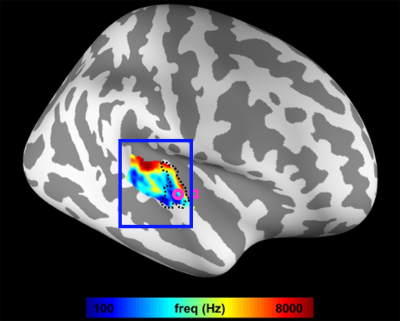 |
82 | Correlation between inter-cortical depth hemodynamic responses and oscillatory neuronal responses during music listening
Pu-Yeh Wu, Hsin-Ju Lee, Hsiang-Yu Yu, Cheng-Chia Lee, Chien-Chen Chou, Wen-Jui Kuo, Fa-Hsuan Lin
We explored the correlation between cortical depth-specific BOLD signal and oscillatory neuornal activity during music listening using high resolution fMRI data (3T with 1.5 mm isotropic resolution) and stereotactic electroencephalography. Three findings are: first, the hemodynamic responses in human auditory cortex was significantly correlated with neuronal oscillation in high gamma band (40 Hz to 90 Hz). Second, the intermediate cortical depth was more closely related to neuronal oscillation. Third, the neuronal-hemodynamic correlation was higher in core than in noncore region.
|
|
3762. 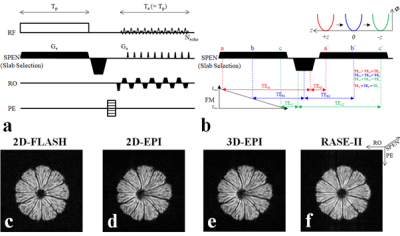 |
83 | BOLD-fMRI Using a 3D Ultrafast Gradient-echo-based Sequence Using Quadratic-phase Encoding (RASE-II) in Comparison with 2D and 3D EPI
Ryu JaeKyun, Jung Won Beom, Son Jeong Pyo, Kim Seong-Gi, Park Jang-Yeon
We recently introduced a novel ultrafast 3D gradient-echo-based imaging technique using spatio-temporal encoding (SPEN) or quadratic-phase encoding, which were dubbed RASE-I and -II (Rapid Acquisition with Sequential Excitation). RASE has less sensitivity to field inhomogeneities and susceptibility differences compared to conventional gradient-echo EPI (GE-EPI), sharing the advantages of 3D imaging such as high signal-to-noise ratio and high spatial resolution. In this study, we present promising results of RASE-II fMRI, i.e., better t-scores, tSNR than conventional 2D and 3D GE-EPI, on a 9.4-T animal scanner.
|
|
3763 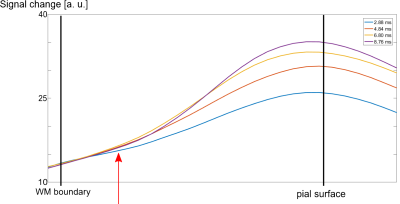 |
84 | Laminar fMRI with T2-prepared multi-echo FLASH Video Permission Withheld
Viktor Pfaffenrot, Peter Koopmans
Examining signal changes at the level of cortical layers using T2*-weighted fMRI suffers from a systematic bias caused by extravascular effects of draining veins. T2-weighting promises higher specificity to signal changes near the origin of neural activity. In this work, we use a T2-prepared, multi-echo FLASH sequence at 7 T in a flickering checkerboard experiment targeting the visual cortex to investigate the feasibility of this sequence for laminar fMRI. The layer profiles indicate the desired T2-weighted response in grey matter, but also a peak at the pial surface likely caused by intravascular effects in the pial veins.
|
|
3764. 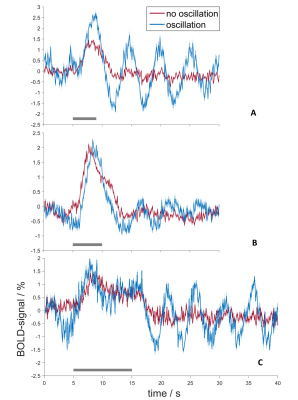 |
85 | fMRI signal oscillations in rats can be induced by electric paw stimulation but do not deteriorate the observed BOLD peak
Henriette Lambers, Lydia Wachsmuth, Franziska Albers, Martin Segeroth, Cornelius Faber
Signal time courses of BOLD fMRI measurements in rodents often show a damped oscillation which may superimpose with the expected hemodynamic response. In order to explore and characterize these oscillations, we performed EPI-BOLD measurements with high temporal resolution upon electrical paw stimulation. 55 % of the measurements showed oscillations with a frequency of 0.2 Hz. We could verify that these oscillations were induced by stimulation but did not affect the BOLD response. Consequently, hemodynamic response function models for statistical analysis are valid independently from the occurrence of oscillations.
|
|
3765. 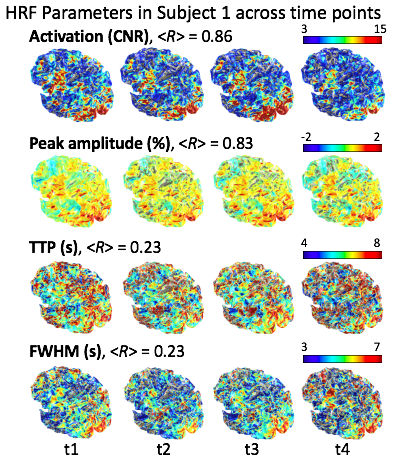 |
86 | Longitudinal study of BOLD HRF in human cortex
Amanda Taylor, Xiaowei Zou, Jung Hwan Kim, David Ress
A simple audiovisual stimulus combined with a fast-paced task evoked a strong HRF across a majority of cerebral cortex during four scanning sessions to measure the repeatability of BOLD over time. HRFs were characterized by spatial and temporal parameters and showed remarkable correlation across the time points, which spanned three hours, three days, and three months. Results showed that HRFs are repeatable for consistent quantification of neurovascular coupling.
|
|
3766. 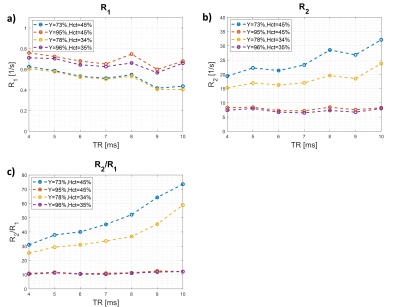 |
87 | R1 and R2 characterization of human blood with phase-cycled balanced steady-state free precession (bSSFP)
Marlon Pérez-Rodas, Hildegard Schulz, Rolf Pohmann, Klaus Scheffler, Rahel Heule
Balanced steady-state free precession (bSSFP) sequences have received increased interest for functional BOLD experiments since, in contrast to conventional EPI-based techniques, they are not prone to geometric distortions in the phase encoding direction. Characterization of measured BOLD signal changes requires consideration of extravascular as well as intravascular contributions. Knowledge about the relaxation rates of human blood is a prerequisite to quantify the intravascular contribution to the BOLD effect. Here, R1 and R2 relaxation rates of blood samples are intrinsically obtained from a series of phase-cycled bSSFP scans to account for the repetition time dependence of R2 due to rapid refocusing.
|
|
3767. 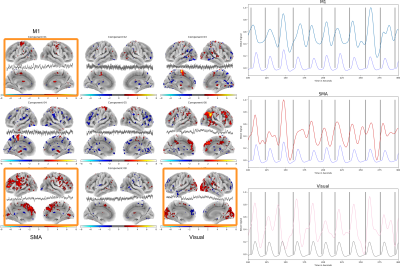 |
88 | Revisiting mental chronometry with isotropic resolution and full brain coverage.
Zahra Fazal, Samantha Noteboom, Daniel. Gomez, Jose. Marques, David. Norris
In this project, we are using a multiband echo-shifted EPI sequence for TR less than 160 ms combined with a novel analysis approach to measure interregional BOLD onset times from a visual-motor association task with full brain coverage and isotropic resolution.
|
|
3768. 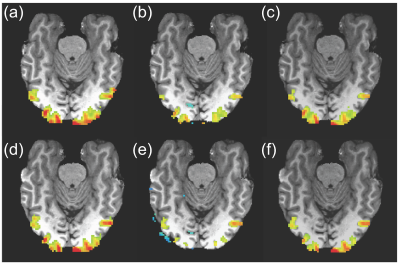 |
89 | Voxel-Specific Modeling of Physiological Fluctuations in BOLD fMRI Signal
Rong-Wen Tain, Shauna Stark, Samantha Rutledge, David Keator, Craig Stark
Cardiac pulsation and respiration have significant contributions to the BOLD signal. This is particularly challenging given the long TRs typically used in BOLD experiments since these fluctuations are at higher frequency than the sampling rate and therefore aliased to lower frequency components. This study presents a new voxel-specific method accounting for the physiological effects in BOLD time series signal. We show that this approach is able to improve the estimation of physiological effects compared to the widely used RETROICOR method.
|
|
3769. 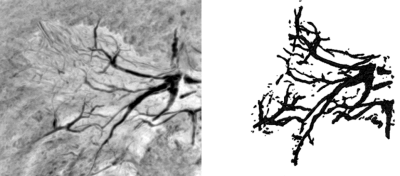 |
90 | Effects of Spinal Cord vascular geometry on the BOLD-fMRI contrast
Fabio Mangini, Laura Maugeri, Mauro DiNuzzo, Marta Moraschi, Daniele Mascali, Alejandra Sierra, Alessia Cedola, Federico Giove, Michela Fratini
The effects of the spinal cord (SC) vessel topology on the blood oxygenation level dependent (BOLD) signal is poorly characterized. We performed numerical simulations on models of vasculature
|
|
3770. 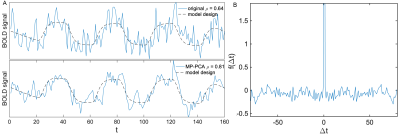 |
91 | MP-PCA denoising to improve detection of task-based fMRI activation in brain tumor patients
Benjamin Ades-Aron, Jelle Veraart, Els Fieremans, Dmitry Novikov, Timothy Shepherd
Functional MRI improves preoperative planning in brain tumor patients, however BOLD signal changes for task-based 3T fMRI are only 2-4% and the tumor often compromises patient performance. This retrospective study evaluated Marchenko-Pastur Principle Component Analysis (MP-PCA) denoising to increase sensitivity for cortical regions recruited during language task-based fMRI paradigms in brain tumor patients. MP-PCA denoising is shown to improve the clinical value and practical utility of performing preoperative fMRI in brain tumor patients.
|
|
3771.  |
92 | Dynamic Model-based Reconstruction for Oscillating Steady State fMRI
Amos Cao, Shouchang Guo, Doug Noll
We introduce Oscillating Steady State (OSS) fMRI, a method that uses quadratic phase cycling and balanced gradients to create an oscillating T2* sensitive signal. We also present a model-based reconstruction that converts these signal oscillations into B0 estimates, enabling correction for respiratory or scanner induced signal changes. OSS fMRI enables the SNR benefits of bSSFP-based methods, while adding T2* sensitivity and B0 encoding into a unique oscillating signal.
|
|
3772. 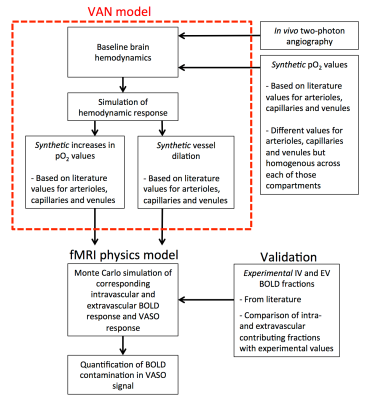 |
93 | Monte Carlo simulation of VASO fMRI from real microvascular angiograms of the mouse cortex
Élie Genois, Louis Gagnon, Sava Sakadžic, Anna Devor, David Boas, Michèle Desjardins
The vascular space occupancy (VASO) fMRI method probes changes in cerebral blood volume (CBV) but subsequent BOLD response contaminates the VASO signal reducing its SNR. Quantifying this BOLD contamination for different pulse-sequence parameters would improve our ability to measure CBV changes and optimize their quantification in a variety of physiological states and diseases. We have implemented a Monte Carlo method to model such effect from experimental cortical angiograms measured with two-photon microscopy on mice brains. Our results indicate that at 3T the BOLD contamination is relatively low (below 10%) but that this contamination is much higher at 7T and above.
|
|
3773. 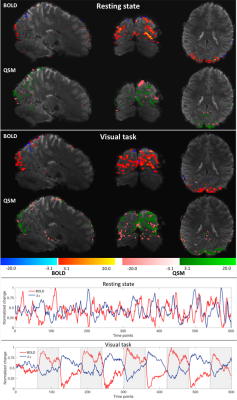 |
94 | Comparing correlation between BOLD and susceptibility changes during Resting state and Task-based experiments
Sagar Buch, Hacene Serrai, Ravi Menon
Quantitative susceptibility mapping (QSM) is a technique widely used for the measurement of venous oxygen saturation levels, through local deoxyhemoglobin concentration. In this work, QSM is used to explore the relationship between magnetic susceptibility and BOLD signal changes during resting state and task based fMRI experiments, in order to better understand their cerebrovascular mechanisms. Negative correlations between susceptibility and BOLD signal were observed and evaluated for both resting state and task based experiments.
|
|
3774. 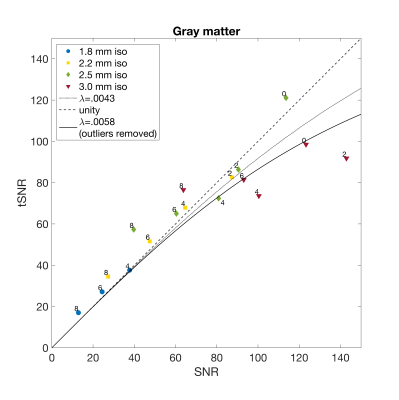 |
95 | Influence of multiband factor on temporal SNR limits using a clinical BOLD-EPI sequence
Pim Pullens, Jasper Degryse, Han Bossier, Bieke Moerkerke, Marcel Brass, Guy Vingerhoets, Rik Achten
Detectability of BOLD signal change is determined by temporal SNR (tSNR, mean divided by standard deviation of the signal over time), and ultimately determines how long needs to be scanned to obtain significant results in a fMRI experiment. With the clinical availability of multiband BOLD-EPI, TR can be shortened significantly, but it is unclear how MB factor influences tSNR. We show in a human subject that tSNR limits up to 192 can be reached and that multiple combinations of MB factor and voxel size can be used to reach similar tSNR values.
|
|
3775. 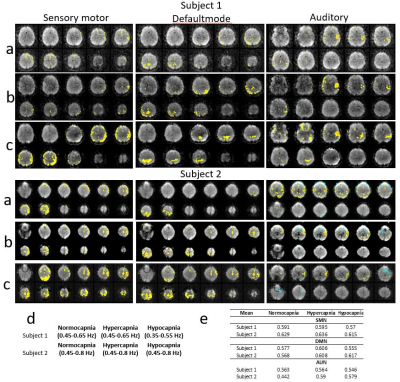 |
96 | On the detection of resting-state correlations at high-frequencies under hyper- and hypo- capnic conditions
Kishore Vakamudi, Khaled Talaat, Arpad Zolyomi, Arvind Caprihan, Stefan Posse
In this study, we investigate the detection of resting-state fluctuations at higher frequencies using changes in global blood flow using hyper- and hypo- capnic conditions. A new adaptive TR approach enables higher sensitivity for detecting the resting-state fluctuations at higher frequencies through optimized TR that is tailored to the individual cardiac and respiratory rates. We were able to detect major resting-state networks (sensory motor, default-mode, and auditory) at frequencies between 0.45-0.8 Hz in normo-, hyper-, and hypo- capnic conditions.
|
|
3776. 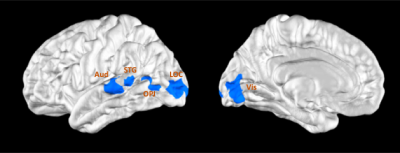 |
97 | The latency differentiates BOLD responses elicited by congruent and incongruent McGurk audio-visual stimulus pairs
Ren-Horng Wang, Shu-Yu Huang, Hsin-Ju Lee, Wen-Jui Kuo, Fa-Hsuan Lin
We used fast fMRI sampled at the 10-Hz rate to study fMRI timing in audiovisual integration. Using the McGurk protocol, we found that the superior temporal gyrus (STG) had significant BOLD time-to-half (TTH) difference between the McGurk and congruent audiovisual stimuli pairs. The significance of TTH difference between congruent and McGurk was progressively more significant from posterior to anterior regions (p-values at visual cortex, lateral occipital lob, occipital parietal junction, STG, and auditory cortex were 0.13, 0.12, 0.05, 0.02, and 0.01, respectively), suggesting that incongruent audio-visual stimuli cause more delayed the brain response at regions closer to primary auditory processing.
|
|
3777. 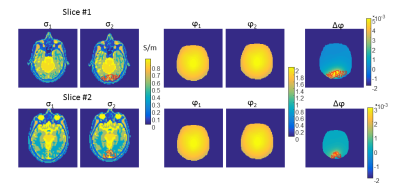 |
98 | Electrical conductivity as a potential mean to decouple the hemodynamic response from fMRI
Rita Schmidt
MR electrical properties imaging offers new means for probing physiological information in-vivo. The interest for fMRI lies in the dependence of electrical conductivity on structural macroscopic changes and on ionic concentration changes. In-vivo electrical conductivity acquisition has the potential to provide the means to decouple the hemodynamic response from fMRI. Changes in electrical conductivity can be measured using phase changes in a spin-echo experiment. We compared BOLD fMRI with phase changes in SE-EPI using basic visual task paradigm at 3T MRI, which showed faster time response and more localized spatial activation. Further study is required to analyze possible contributing factors.
|
|
3778 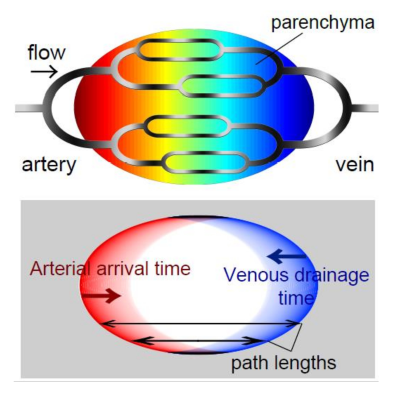 |
99 | The lag structure by BOLD-based blood flow tracking indicates the partial non-neuronal source of resting state functional connectivity in mouse Video Permission Withheld
Tomokazu Tsurugizawa, Clement Debacker, Boucif Djemai, Toshihiko Aso
A BOLD-based tracking technique was applied to 11 mice to investigate the cerebral circulation. Mapping of the phase of low-frequency component, which is called as “BOLD-based lag structure” showed the typical vascular structure as previous study. Interestingly, BOLD-based lag structure in bilateral somatosensory cortex was similar with the resting state functional connectivity between the bilateral somatosensory cortex. These results indicate the feasibility of this technique in mouse model. Furthermore, our results implies the partial contamination of circulating blood flow in resting state functional connectivity in mouse model.
|
|
3779. 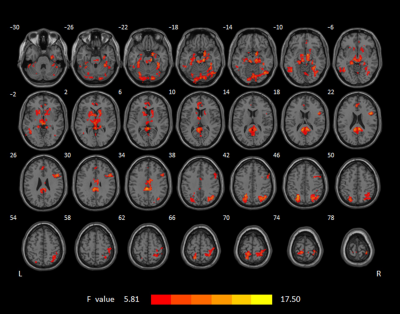 |
100 | Drug cue-Induced brain response in protracted abstinence and methadone maintenance measures for heroin addiction: An event-related fMRI study Presentation Not Submitted
Xuan Wei
Our research aims to compare PA with MMT,to reveal which abstinence way is better to recover the brain function in heroin-dependent individuals.24 heroin-dependent patients under PA ,19 heroin-dependent patients under MMT and 20 healthy volunteers were recruited. The functional images were acquired by using a spin-echo EPI. In the last part of this study, we proved PA is closer to healthy group.This study showed that PA is more advantageous than MMT to reduce heroin addiction in drug cue-reactivity.
|
fMRI: Applications
Digital Poster
Digital Poster
fMRI
Wednesday, 15 May 2019
| Exhibition Hall | 13:30 - 14:30 |
| Computer # | |||
3780.  |
101 | fMRI of Radiologists with a Diagnosis Task
David Ouellette, Dan-Ling Hsu, Eric van Staalduinen, Syed Hussaini, Sindhuja T. Govindarajan, Patricia Stefancin, Tim Duong
Radiologists display superior perception in the analysis of medical images, but there are currently no fMRI studies of radiologists during a complex diagnosis task. In this study, radiologists read a variety of medical images and chose a diagnosis during fMRI. Compared to age- and education-matched controls, radiologists had lower functional activation in several visuospatial areas, including the lateral ocipital cortex and lingual gyrus.
|
|
3781. 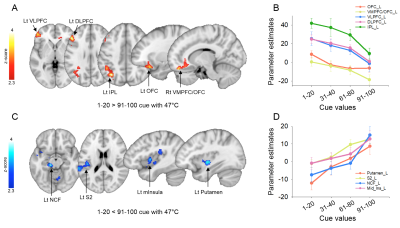 |
102 | fMRI Mapping of Cognitive Brain Networks Involved in Perceptual Bias
Manyoel Lim, Christopher O'Grady, Mary Lynch, Steven Beyea, Javeria Hashmi
Prior expectations are critical in the formation of perceptions around phenomona such as pain. This study uses functional MRI to elucidate regions associated with both top-down and bottom-up aspects of pain perception, finding a network of higher-cortical regions for the former and primarily sensory regions for the latter. Additionally, bias towards cues rather than actual pain stimuli was both hypothesized and observed. The findings therefore shed light on the physiological basis of neural activation behind the complex and highly-biased formation of pain perceptions.
|
|
3782.  |
103 | Cerebral blood flow changes associated with meditation practice time: a longitudinal study
Zongpai Zhang, Wenna Duan, Steffi Chettiar, Swanand Wagh, Wen-Ming Luh, George Weinschenk, Weiying Dai
Longitudinal cerebral blood flow (CBF) images were acquired in ten college students after 2-month meditation practice. The CBF difference before and after meditation practice and the association between CBF change and meditation practice time were analyzed on a voxel-by-voxel basis using SPM8. We found significant perfusion increase and decrease in the occipital and thalamus regions respectively. However, the CBF increase and decrease in the corresponding regions exhibited negative and positive association with practice time respectively. Regional analysis confirmed that the direction of CBF change may switch after some amount of meditation practice time, indicating a complex neural pathway of meditation.
|
|
3783.  |
104 | Engagement of multiple networks during meditation: an fMRI study
Vaibhav Tripathi, Rahul Garg, Vidur Mahajan, Anju Dhawan
Long-term effects of meditation and the differences between meditators and non-meditators have been studied extensively. In order to understand the corresponding mechanisms of action, brain areas activated while meditating need to be studied. Such studies are limited due to lack of a suitable experimental paradigm and analysis technique. We investigated experienced meditators who underwent a 20 minutes audio-guided meditation in the fMRI scanner. Using the Intersubject correlation (ISC) analysis, correlated activity across the subjects was found in frontal pole, middle frontal gyrus, precuneus, primary somatosensory cortex, visual cortex, lingual gyrus, and cerebellum.
|
|
3784. 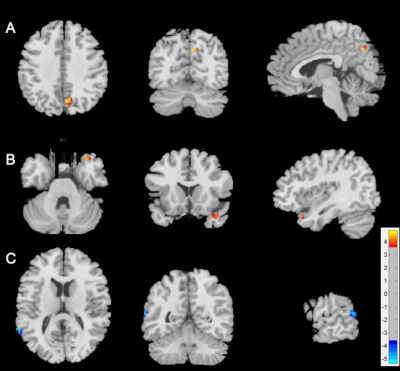 |
105 | Effects of eleven-week aerobic exercises on working memory of deaf children estimated using task state functional magnetic resonance imaging
Hang Qu, Wang Wei, Weiqiang Dou
In this study, we used a combined aerobic exercise and task functional magnetic resonance imaging (fMRI) on deaf children for eleven weeks to investigate the alternation of working memory function after exercise. The classic 2-back task included make odd-even judgment and short-term memory. The experimental group showed a significant improvement in the 2-back task performance and alternation of functional activity in temporal lobe, precuneus temporal lobe and precuneus. These findings may help to explain the synaptic plasticity of brain.
|
|
3785. 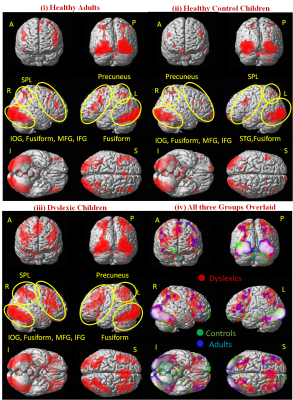 |
106 | Dual-route mechanism for pictorial visual perception in developmental dyslexia
Sunita Gudwani, S.Senthil Kumaran, Rajesh Sagar, Madhuri Behari, Manju Mehta, Vaishna Narang, SN Dwivedi, NR Jagannathan
Reading a window to world’s information, is a coordinated skill of grapheme-phoneme interface (letter-sound) at symbolic level. Inefficient mapping of this alphabets-horizontal string is labeled as dyslexia (reading problem). It can be developmental or acquired (post-stroke) disorder. Developmental dyslexia (DD) is heterogeneous state with disputed underlying mechanism(s) constraining optimal remediation. Compared to typical readers, DD literature is bifurcated into children with strength and impairment for visual perception. To unfold it neurobiologically, nonsymbolic visual processing role was studied. Observed bilateral brain activation (functional MRI) of ventral stream (inferior occipital and fusiform) and modified dorsal route-gating for figure-ground filtering in DD.
|
|
3786.  |
107 | Subcortical and cortical fMRI assessment of auditory pathway function associated with lifetime noise exposure in normally hearing listeners
Rebecca Dewey, Susan Francis, Hannah Guest, Garreth Prendergast, Rebecca Millman, Christopher Plack, Deborah Hall
We investigated the relationship of lifetime noise exposure with subcortical and cortical auditory fMRI BOLD responses to broadband noise in 62 individuals with clinically normal audiometric thresholds. We demonstrate robust individual and group responses to a broadband noise across structures in the auditory pathway. In line with animal models, we show a significantly increased BOLD response to stimulus onset in individuals with high noise exposure compared to those with low noise exposure in all auditory structures assessed. We also show a trend towards individuals with high noise exposure exhibiting a greater sustained BOLD response.
|
|
3787. 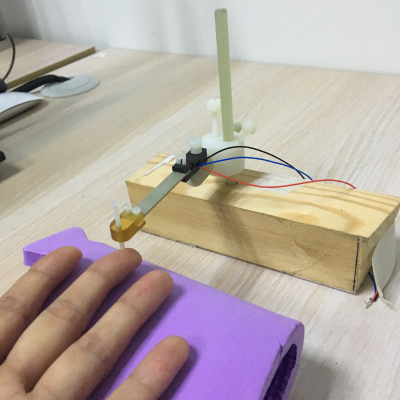 |
108 | 7T functioanl MRI reveals frequency-dependent responses during vibrotactile stimulation at somatosensory cortex
Boyi Qu, Xiao Yu, Kaiyue Wang, Mengjie Xin, Hsin-Yi Lai
To investigate whether the brain can directly encode different vibrotactile frequencies, we made a MR-compatible lab-designed vibrotactilestimulator to presented pulse stimuli on middle finger (with a frequency difference in the same duration) andusing BOLD fMRI to explore the effectsofvibrotactilefrequencyin somatosensory cortex with 7T MR research system. The results showedthat the lab-designed MR compatible vibrotactile stimulator could elicit BOLD responsesin the somatosensory cortex. Also, the BOLD response was frequency-dependent with the peak at 6Hz.
|
|
3788.  |
109 | Effect of cue induced craving on brain morphometry and function in adolescent inhalant users
Shobhit Jain, S Kumaran, Anju Dhawan, Raman Pattanayak , Raka Jain
Inhalants are legal, inexpensive substances that are often abused by adolescents. This study compared the BOLD changes in brain associated with cue-induced craving in adolescent inhalant users (n=13) and healthy controls (n=12) to elucidate the neural mechanisms associated with cue-induced craving. The cases exhibited an increased activation of superior occipital gyrus, inferior parietal lobule, cingulate gyrus, thalamus, and culmen and a decreased activation of insula as compared to control group for craving cues. Visual cue reactivity was associated with activation of the areas responsible for visual perception, visuo-spatial attention and working memory, control and motivation.
|
|
3789. 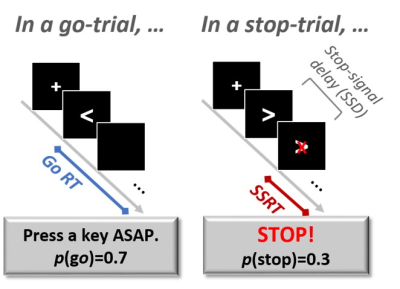 |
110 | The faster the better: onsets of pre-SMA and right inferior frontal activations predict successful stopping in a stop-signal task
Hsin-Ju Lee, Fa-Hsuan Lin, Wen-Jui Kuo
Using fast fMRI (whole-brain 10 Hz sampling), we revealed BOLD activities in the pre-SMA and right inferior frontal gyrus are activated faster for successful than for unsuccessful stopping.
|
|
3790 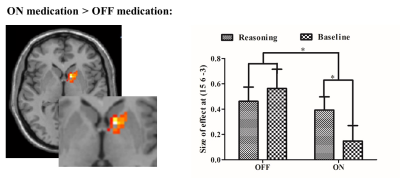 |
111 | Dopaminergic modulation of reasoning ability in non-demented Parkinson’s disease Video Permission Withheld
Xiuqin Jia, Tao Jiang, Zihao Zhang, Kun Li, Peipeng Liang
Patients with Parkinson's disease (PD) are more likely to suffer cognitive decline and experience difficulties in daily living requiring reasoning including medication use, financial management, and nutrition and food preparation even at early stage of the disease.1,2 The present study aimed to explore L-dopa modulation on the reasoning ability in PD. Twenty non-demented PD underwent reasoning fMRI examinations OFF-medication and ON-medication. It was found that ON-medication PD patients exhibited improved reasoning performance and recruited the striatum compared to OFF-medication. The current findings suggest that L-dopa treatment mediated the neural activity in the striatum and further improved the behavior performance.
|
|
3791. 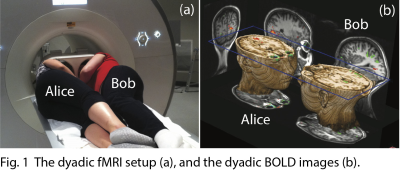 |
112 | Brain-to-Brain Interaction and Entanglement
Ray Lee
Recognizing that the coherence of proton nuclear spin ensembles in dyadic brains is periodically enforced by the RF excitation pulses so that superposition states may be embedded in MR signals, the mathematical language of quantum theory is utilized to describe a dyadic fMRI experiment. Within this platform, the data-driven dyadic communication model, two coupled three-layer neural networks, predicts not only brain-to-brain interaction operations but also entanglement operations which might profoundly expand our understanding of human social communication.
|
|
3792. 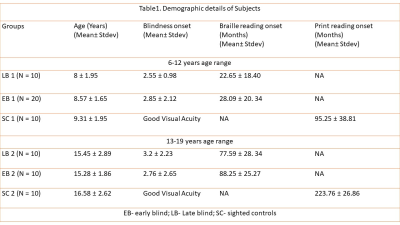 |
113 | Neurocognitive modifications associated with auditory perception in children and adolescent group in early and late blind subjects: A functional magnetic resonance imaging study
Ankeeta Ankeeta, S Kumaran, N Jagannathan, Rohit Saxena
Perceiving the world without any visual cue in
|
|
3793 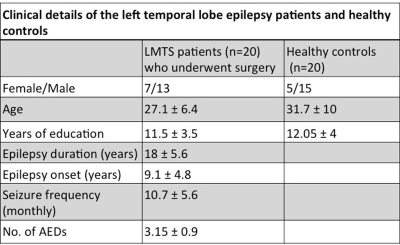 |
114 | A combined task based fMRI connectivity and VBM study to lateralization of memory function in pre-and post-surgery mesial temporal lobe epilepsy patients. Video Permission Withheld
Kapil Chaudhary, Senthil Kumaran, Sarat P Chandra, Manjari Tripathi
Patients with temporal lobe epilepsy (TLE) have associated cognitive dysfunction and memory impairment on anterior temporal lobe resection (ATLR). Semantic verbal memory reorganization was investigated using functional connectivity (FC) and VBM in pre-and post-operative TLE subjects and healthy controls. Reduction in GM concentration was observed in left temporal lobe post-operatively in comparison to pre-surgery session and healthy controls. Semantic verbal memory components revealed increased FC in right hemisphere with decreased memory scores at follow-up (6 months post-surgery) compared to that of pre-surgery, indicating damage in the medial temporal region due to surgical resection resulting in semantic verbal memory network dysfunction.
|
|
3794.  |
115 | Working memory deficits in childhood cancer survivors: an fMRI study
Patricia Stefancin, Christine Cahaney, Robert Parker, Thomas Preston, Laura Hogan, Rina Meyer, Cara Giannillo, Debra Giugliano, Tim Duong
Little is known about the neural correlates of cognitive deficits in chemotherapy treated survivors of childhood cancer. We used event related fMRI to study working memory in childhood cancer survivors. Subjects underwent an n-back task to test working memory function. Patients showed reduced BOLD signal on correct responses compared to controls in the anterior cingulate, posterior cingulate, and sensory association cortices. Patients showed increased activation on error trials in the angular gyrus and superior parietal lobule. The affected brain regions are known to be involved in memory function, reward, motor planning and motivation.
|
|
3795. 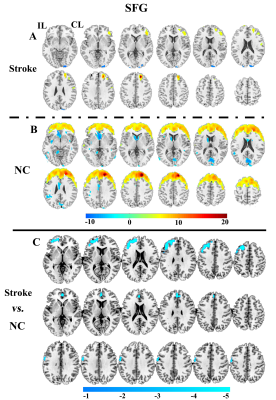 |
116 | Detecting CBF to Explore Verbal Memory Impairment Mechanisms in Subcortical Stroke Patients Presentation Not Submitted
Caihong Wang, Peifang Miao, Sen Wei, Kaiyu Wang, Jingliang Cheng
In order to explore the neural substrates underlying verbal memory (VM) impairment in subcortical stroke patients, we recruited sixty patients with chronic subcortical stroke and sixty normal controls. 3D-ASL imaging was used to measure the resting-state values of voxel-wise cerebral blood flow (CBF) and the alterations of functional covariance network were detected. In this study, the different CBF levels in the stroke patients and the normal controls, as well as the close correlation between the CBF values and the VM scores, indicate that the VM impairment in stroke patients may be associated with the disconnection of frontal-lobe network.
|
|
3796. 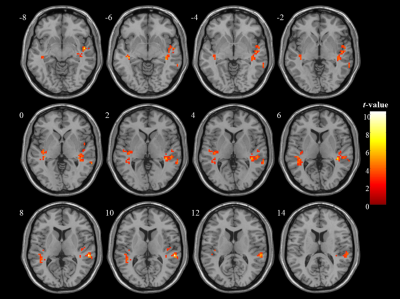 |
117 | Influence of smoking cessation treatment by varenicline to brain—a resting-fMRI study Presentation Not Submitted
Peng Peng, Chun-lin Li, Bin Jing, Shui-lian Chu, Qing-lei Shi, Xiu-qin Jia, Tao Jiang
This study investigated the activation changes of brain regions in smokers before and after cessation treatment using a resting state fMRI. The results demonstrated that treated smokers will have improved functions of brain regions related to emotion and memory after using varenicline. This improvement is not only the direct benefit of quitting smoking, but also helps quitters cope with the discomfort and negative emotions of quitting. All subjects showed a decrease in smoking addiction and withdrawal response, suggesting that varenicline can help quitters maintain their withdrawal status.
|
|
3797. 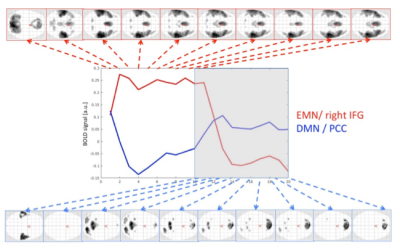 |
118 | Dynamic up- and down-regulation of large-scale cortical networks during task-on and task-off periods.
Katarzyna Kazimierczak, Karsten Specht, Justyna Beresniewicz, Kristiina Kompus, René Westerhausen, Renate Grüner, Lars Ersland, Kenneth Hugdahl
This study was intended to capture the dynamics of networks up- and down-regulation over time, with focus on the extrinsic mode network (EMN) and the default mode network (DMN), using functional magnetic resonance imaging (fMRI). Finite impulse response function (FIR) featured in the SPM software package was used to estimate the BOLD response. The results featured initial rapid activation of EMN in task-periods, while DMN began to drift towards up-regulation already by the end of the task-period.
|
|
3798. 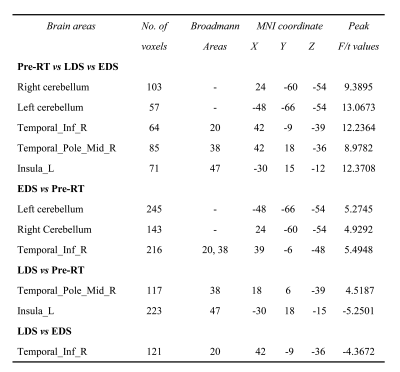 |
119 | Abnormal local spontaneous brain activity revealed by resting-state fMRI as a biomarker for predicting radiation-induced neurocognitive dysfunction in patients with nasopharyngeal carcinoma Presentation Not Submitted
Yadi Yang, Chuanmiao Xie, Long Qian, Zhipeng Li, Yingwei Qiu, Xiaofei Lv
In this study, we hypothesize that radiation therapy induce longitudinal neurocognitive dysfunction in patients with nasopharyngeal carcinoma. To verify this hypothesis, resting-state functional magnetic resonance imaging (fMRI) was used to detect the local spontaneous brain activity in 38 patients with nasopharyngeal carcinoma 20 healthy controls at the baseline and follow-up examinations. The changes in brain activity at the early delayed stage after radiation therapy are then used to predict the brain functional impairment at a later stage. The results showed that radiation therapy may induce significant changes in reginal homogeneity in the brain, and such changes at early delayed stage may serve as a potential biomarker for predicting neurocognitive dysfunction at a later stage.
|
|
3799. 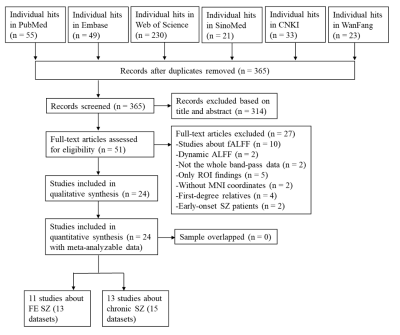 |
120 | Abnormalities of intrinsic regional brain activity at resting state in schizophrenia: a meta-analysis of resting-state functional MRI
JiaYing Gong, Junjing Wang, Xiaomei Luo, Guanmao Chen, Huiyuan Huang, Ruiwang Huang, Li Huang, Ying Wang
Evidences of abnormal intrinsic brain activity in schizophrenia (SZ) are inconsistent demonstrated by previous studies. A meta-analysis that explored the differences of the ALFF between SZ patients (including first episode [FE] and chronic patients) and healthy controls were conducted. FE patients demonstrated decreased ALFF in the DMN and increased in the putamen, VN (visual network). Chronic patients showed decreased ALFF in the DMN, sensorimotor network, and VN and increased in the salience network, frontotemporal regions. Aberrant regional brain activity during the initial stage and widespread damage with the progression of disease contributes to understand the progressive pathophysiology feature of SZ.
|
|
3800. 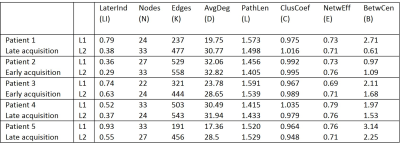 |
121 | Graph theoretic analysis of language sub-networks in Arabic-English bilingual patients undergoing fMRI for pre-surgical planning
Shruti Agarwal, Mona Mohamed, Hanzhang Lu, Jay Pillai
Task fMRI is routinely performed on patients for pre-surgical planning to localize critical components of the language network and assess hemispheric language dominance. However, the cortical representation of language in bilingual patients (those who are fluent in more than one language) is more complex than in monolinguals, and may involve overlapping but distinct sub-networks. The focus of our current study is to assess the functional connectivity strength of language networks derived from task fMRI activation maps obtained using paradigms performed in both primary native (L1) and secondary (L2) languages in a group of Arabic-English bilingual patients.
|
|
3801. 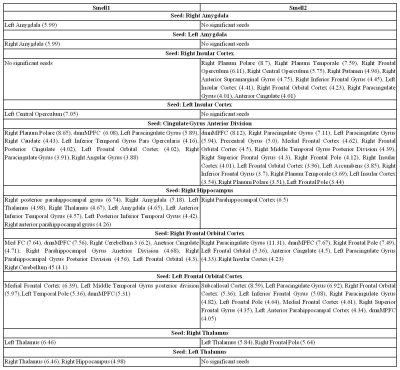 |
122 | Altered connectivity following olfaction fMRI in Patients with Parkinson’s Disease: A comparative study using two different odors
Shefali Chaudhary, S Kumaran, Vinay Goyal, Priyanka Bhat, Ankita Sharma, Gauri Kaloiya
Olfactory impairments are one of the cardinal non-motor symptoms in Parkinson’s Disease (PD). Functional Connectivity analysis was carried out for olfaction task with floral fragrance (smell 1) and citrus fragrance (smell 2) on 10 PD patients (9M/1F, mean age ± SD=57.7±5.6 years). Main effects depicted heterogeneous connectivity and differential lateralization for both the smells. Amygdala and the thalamus were affected for both the smells in patients with PD and may be attributed to the pathology. Olfaction specificity for hippocampal connectivity in floral smell and for orbitofrontal, insula and anterior cingulate in citrus smell suggest differential recruitment of cognition linked areas.
|
|
3802 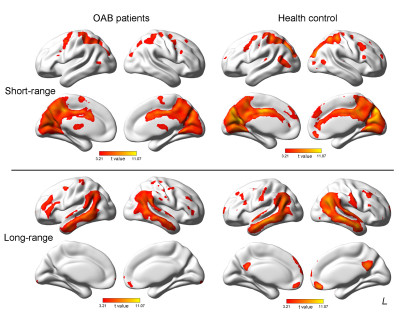 |
123 | Disrupted functional connectivity strength in overactive bladder syndrome patients Video Permission Withheld
Long Zuo, Shuangkun Wang, Yang Zhou, Hua Gu, Biao Wang, Tao Jiang
A dysregulation of the brain-bladder control network has been revealed by the functional brain imaging studies. However, the brain functional connectivity strength (FCS) of OAB still remains unclear. Our study investigated the changes of intrinsic whole brain functional connectivity pattern in OAB using FCS. Patients with OAB have impaired pattern of FCS, which shows abnormal short-range and long-range FCS in brain regions associated with brain-bladder network. Behavioural treatments of the OAB based on fMRI may provide new sight into clinical practice.
|
|
3803. 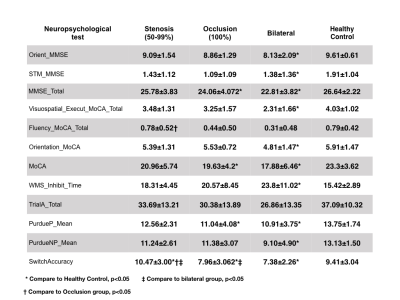 |
124 | Neuropsychological Assessments and ALFF across Multiple Categories of Carotid Artery Stenosis
MEI-YU YEH, Changwei W. Wu, Meng-Yang Ho, Tsong-Hai Lee, Fu-Nien Wang
We explored the relationship between neuropsychological tests and ALFF based on three types of patients with carotid artery stenosis: unilateral stenosis, unilateral occlusion and bilateral stenosis. We found that patients with occlusion and bilateral stenosis had stronger ALFF than controls, but the neurophysiological results did not match the ALFF outcomes.
|
|
3804. 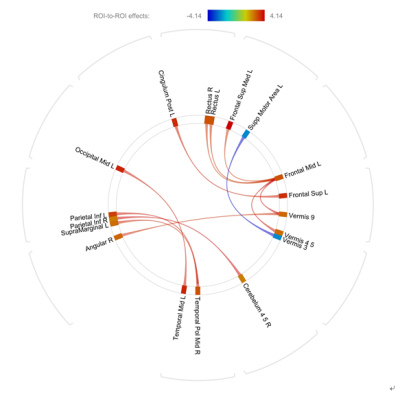 |
125 | Altered resting-state functional connectivity in patients with cervical vertigo Presentation Not Submitted
Cuili Kuang, Yunfei Zha, Yang Fan
As a pioneering work to cervical vertigo in functional connectivity perspective, in some extent, we discovered the potential specific spatiotemporal neuronal functional mechanisms alteration, and altered functional connections were correlated to clinical scale scores. These findings might support complementary evidence for its clinical cognition.
|
fMRI: Connectivity Methods
Digital Poster
Digital Poster
fMRI
Wednesday, 15 May 2019
| Exhibition Hall | 14:30 - 15:30 |
| Computer # | |||
3855. 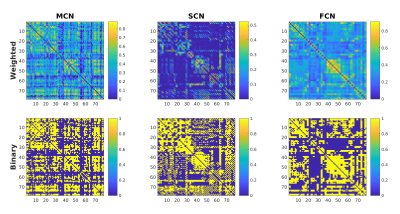 |
1 | Brain connectivity assessed by mechanical covariance
Haitao Ge, Armando Manduca, David Jones, Clifford Jack JR, John Huston III, Richard Ehman, Matthew Murphy
MRI-based measures play an important role in the field of connectomics, which aims to map the brain’s network organization in health and disease. Novel imaging tools may provide new insights into this organization. In this work, we tested whether MR elastography-based stiffness estimates can be used to measure brain connectivity. The mechanical connectivity network (MCN) was significantly correlated with established structural and functional connectivity methods, and also exhibited the expected small world organization. Nonetheless, MCN topological measures significantly differed from the existing methods, suggesting MRE may provide a new perspective on the brain’s organization.
|
|
3856. 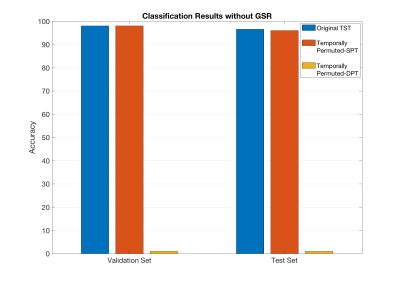 |
2 | Functional Connectome Fingerprinting using Recurrent Neural Networks Does Not Depend on the Temporal Structure of the Data
Gokce Sarar, Shili Wang, Jiawei Ren, Thomas T. Liu
Functional connectome fingerprinting can identify individuals with high accuracy with long duration scans (> 6 min) but the performance significantly degrades with shorter (72s) duration scans. It has been argued that Recurrent Neural Networks (RNN) can achieve high identification performance with short duration data by taking advantage of temporal information in the fMRI signals. We test this claim by permuting the temporal ordering of the data. We show that the RNN can achieve high accuracy for short duration data even when the temporal structure is destroyed, suggesting that the RNN performance depends primarily on the spatial correlation of the data.
|
|
3857. 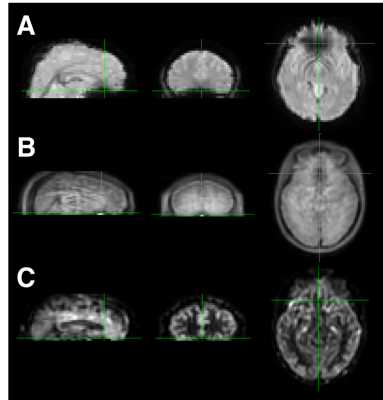 |
3 | Arterial spin labeling pre-processing strategies for functional connectivity analysis
Kalen Petersen, Daniel Claassen, Manus Donahue
Arterial spin labeling-based functional connectivity (ASL-FC) is an emerging method to identify synchronous brain networks from perfusion fluctuations. ASL-FC may compensate for some susceptibility-induced limitations in blood-oxygenation-level-dependent (BOLD)-FC, however ASL-FC processing strategies are only beginning to be investigated. We evaluate optimized ASL-FC pre-processing for network detection, testing the effects of six pre-processing strategies by comparing spatial and temporal features with BOLD-FC in major brain networks. Spatial smoothing, surround subtraction, and global signal regression are necessary to increase ASL-FC sensitivity. ASL-FC also allows for low frequencies to be interrogated, which contain high power but are inaccessible to common BOLD-FC analyses.
|
|
3858 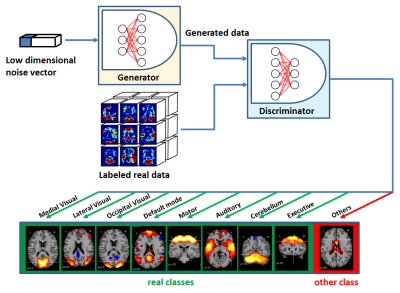 |
4 | Automatic Identification of ICA Components using A Generative Adversarial Network Video Permission Withheld
Yiyu Chou, Snehashis Roy, Catie Chang, John Butman, Dzung Pham
Manual classification of the components derived from ICA analysis of rsfMRI data as particular functional brain resting state networks (RSNs) can be labor intensive and requires expertise; hence, a fully automatic algorithm that can reliably classify these RSNs is desirable. In this paper, we introduce a generative adversarial network (GAN) based method for performing this task. The proposed method achieves over 93% classification accuracy and out-performs the traditional convolutional neural network (CNN) and template matching methods.
|
|
3859. 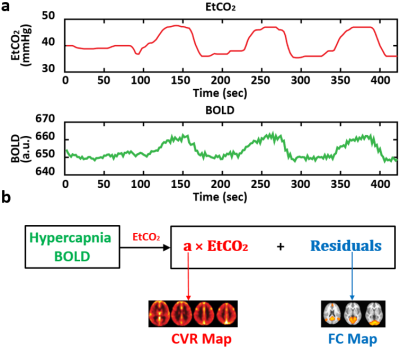 |
5 | Simultaneous measurement of functional connectivity and cerebrovascular reactivity (CVR): feasibility of vasculature-normalized fcMRI
Xirui Hou, Peiying Liu, Hong Gu, Micaela Chan, Li Yang, Shin-Lei Peng, Yihong Yang, Denise Park, Hanzhang Lu
Although widely used in fMRI to assess functional connectivity (FC), the blood-oxygenation-level-dependent (BOLD) signal is not merely a representation of neural activity, but also inherently modulated by vascular physiology. It is therefore desirable to conduct FC mapping with consideration of vascular properties, ideally in the same scan. The present work demonstrated that FC and cerebrovascular reactivity (CVR) could be obtained from BOLD images collected during a single CVR scan. Moreover, the FC indices from gas-inhalation data showed a significant correlation with CVR, suggesting the potential of using CVR as a covariate or normalization factor in interpreting FC results.
|
|
3860. 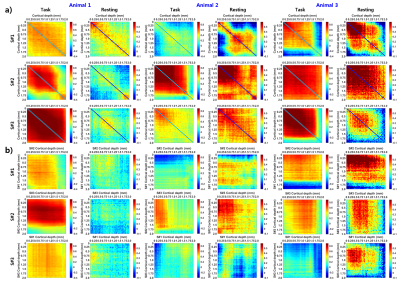 |
6 | Multi-Slice LINE-scanning (MS-LINE) method to characterize the laminar specificity and variability in both evoked and resting-state fMRI
Sangcheon Choi, Hang Zeng, Bharat Biswal, Bruce Rosen, Xin Yu
Ultra-high field magnetic field strengths open new possibility for studying the neuronal input/output circuitry of the cortex and functional connectivity across the cortical layers. However, the spatiotemporal characteristics of laminar-specific fMRI signal remains to be better characterized in both task-related and resting state condition. Here, we present Multi-Slice FLASH based LINE-scanning (MS-LINE) methods, showing the multi-slice laminar-specific fMRI variability at different cortical regions of anesthetized rats. The results identify the distinct neurovascular coupling laminar patterns corresponding to different state of brain activity.
|
|
3861. 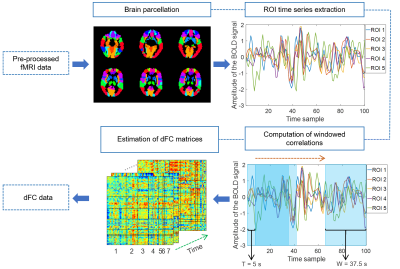 |
7 | Classification of sleep stages from fMRI dynamic functional connectivity using deep learning
Joana Carmona, Rodolfo Abreu, Carlos Santiago, Alberto Leal, Jacinto Nascimento, Patrícia Figueiredo
Sleep stage classifiers monitoring the wakefulness level of resting-state fMRI recordings have been proposed by several studies; however, the application of deep learning methods remains largely unexplored. We investigated the performance of Convolutional Neural Networks (CNNs) in the classification of sleep stages using fMRI-derived dynamic Functional Connectivity (dFC) features and simultaneous EEG-based labels. All tested architectures exhibited accuracies above 80%, with the best performance achieved using a shallow network. The learned filter weights were coherent with known stage-specific patterns of thalamo-cortical dFC. CNNs yielded comparable classification accuracy to Support Vector Machines (SVMs), without the need for exhaustive hyperparameter tuning.
|
|
3862. 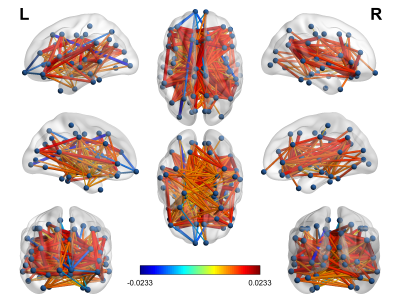 |
8 | Identifying confounds in human brain functional connectomes: physiological and cognitive contributions
Phillip Ward, Sharna Jamadar, Stuart Oldham, Aurina Arnatkeviciute, Gary Egan
Inter-subject analysis of brain function using fMRI is hampered by physiological factors and the neurovascular origin of the semi-quantitative blood oxygenation level dependent signal. A common technique to address these issues is to compute the individual subject fMRI signal correlations between brain regions and compare the functional connectomes across subject groups. In this work, we examined the effect of physiological factors that can contaminate functional connectomes in a large cohort of healthy elderly people. To quantify the impact of the physiological variance we computed the physiological connectome and modelled its impact on the relationship between the functional connectome and cognitive performance.
|
|
3863. 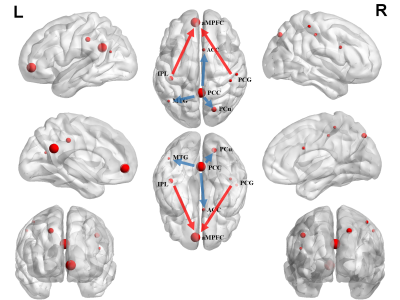 |
9 | Altered Effective Connectivity Anchored in the Posterior Cingulate Cortex and the Medial Prefrontal Cortex in Cognitively Intact Elderly APOE e4 Carriers: A Preliminary Study Presentation Not Submitted
Xiao Luo, Kaicheng Li, Qingze Zeng, Peiyu Huang, Yong Zhang, Minming Zhang
The APOE ε4 allele is the most reliable genetic risk factor for developing sporadic AD. Based on Granger causality analysis (GCA), we analyzed the APOE ε4-related effects on whole-brain directional connectivity in healthy elderly populations, by setting connected node located in anterior and posterior default mode network (DMN). We found that APOE ε4 carriers had reduced effective connectivity (EC) from the PCC to the anterior and posterior DMN subsystems; additionally, the carriers had increased EC from the parietal cortex to the anterior DMN subsystem. Second, the correlation analyses indicated the decreased EC in the carriers might result from neurofibrillary changes.
|
|
3864.  |
10 | Olfaction connectivity in Patients with Parkinson’s disease: A comparative fMRI study.
S Kumaran, Shefali Chaudhary, Vinay Goyal, Priyanka Bhat, Ankita Sharma, Gauri Kaloiya, Mani Kalaivani
Olfactory loss is one of the most common non-motor symptoms in Patients with Parkinson’s disease. ROI based functional connectivity analysis was performed on 10 healthy subjects (HC, 6M/4F, mean age=57±4.5 years) and 10 subjects with Parkinson’s disease (9M/1F, mean age=57.7±5.6 years) with olfaction fMRI (floral smell). Altered olfaction linked functional connectivity was present for amygdala, insula and cingulate gyrus in PD. Functional connectivity for olfactory cognition (hippocampus/orbitofrontal) was found intact in both the groups. Primary olfactory structures are more affected compared to the upstream structures, leading to the observed olfactory impairment.
|
|
3865. 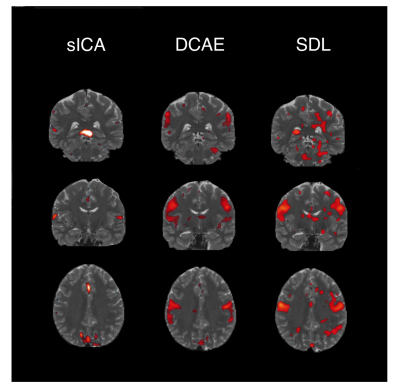 |
11 | Sparse Dictionary Learning and Deep Convolutional Auto-encoders as Alternative Methods to ICA for Resting-State Network Detection
Alice Shen, Gregory Simchick, Brandon Campbell, Qun Zhao
Though Independent Component Analysis (ICA) is a commonly-used method for resting state network (RSN) detection from resting-state fMRI (rsfMRI) data, it is limited by its assumption of spatial independence requiring that detected networks be non-overlapping. This study investigates the use of Sparse Dictionary Learning (SDL) and Deep Convolutional Auto-Encoders (DCAE) as alternative methods for RSN detection using Human Connectome Project rsfMRI data. Using the Smith10 RSN Atlas as a ground truth, Pearson spatial correlation and spatial overlap scores were used as metrics of performance, and it was found that SDL and DCAE outperform ICA in detecting RSNs in single session analyses.
|
|
3866. 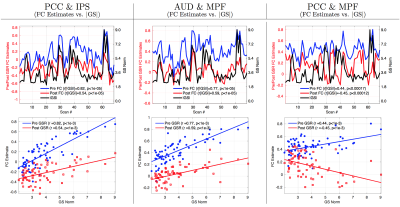 |
12 | Global signal measures are significantly related to functional connectivity variations across scans both before and after global signal regression
Alican Nalci, Wenjing Luo, Thomas Liu
Global signal regression (GSR) is widely employed to reduce the influence of nuisance factors in functional connectivity (FC) estimates. Here, we investigate the GS contributions to the variability of FC estimates across different scans. We show that correlation-based FC estimates are significantly related to the GS norms across scans. We further show that even after GSR there is still a significant relation between the GS norms and FC estimates, indicating that inter-scan FC variations can largely reflect GS effects both before and after GSR.
|
|
3867. 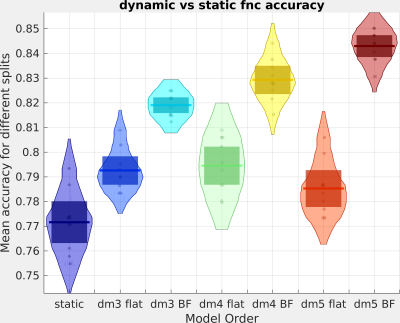 |
13 | A BRUTE FORCE APPROACH TO IMPROVE THE CLASSIFICATION ACCURACY IN RESTING STATE FMRI DATA
Debbrata Kumar Saha, Eswar Damaraju, Barnaly Rashid, Anees Abrol, Sergey Plis, Vince Calhoun
Currently, extensive research is ongoing to perform classification between healthy controls (HC) and patients by extracting features from resting state fMRI based dynamic connectivity states where these states are typically identified by applying different clustering algorithm. However, for classification purposes, the information captured by all dynamic states may not be significant. In this work, we propose a brute force (BF) approach where we consider a subset of these states to perform classification. Our results indicate that in most of the cases, there exists a subset of states which provides better accuracy instead of utilizing information from all of the states.
|
|
3868. 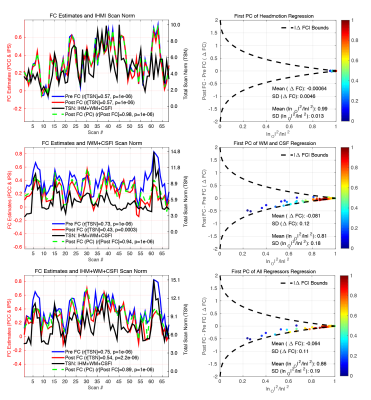 |
14 | Resting-state functional connectivity estimates across scans are correlated with nuisance metrics both before and after nuisance regression
Wenjing Luo, Alican Nalci, Thomas Liu
Nuisance regression is commonly used to reduce the influence of nuisance effects on functional connectivity (FC) estimates. Here we demonstrate that FC estimates across different scans are significantly correlated (prior to nuisance regression) with the norms of various nuisance signals including head motion regressors and signals from non-functional regions. We further show that nuisance regression does not necessarily eliminate the observed correlations between the FC estimates and nuisance norms. We demonstrate that the limited efficacy of nuisance regression is partly due to a theoretical bound that limits the difference in FC estimates obtained before and after regression.
|
|
3869. 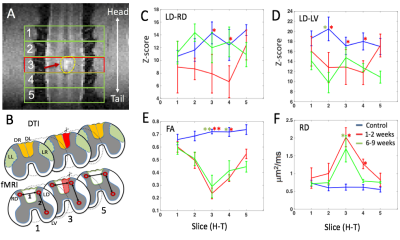 |
15 | Quantitative Assessment of Temporal Changes in fMRI and DTI Parameters in the Squirrel Monkey Spinal Cord after Injury
Arabinda Mishra, Feng Wang, Li Chen, John Gore
Previous studies have reported changes in resting state functional connectivity between horns in spinal cord following injury. In this work we quantified changes in connectivity and diffusion parameters at identical spinal segments in squirrel monkey cervical spinal cords acquired in concurrent sessions to compare the temporal variations of functional and structural changes during recovery after spinal cord injury (SCI). The degree of axonal disruption and demyelination measured using fractional anisotropy and radial diffusivity at two stages of recovery were compared in various white matter tracts.
|
|
3870. 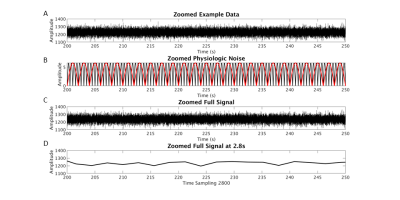 |
16 | Simple Data Acquisition Choices can Adversely Affect Preprocessing Strategies in Resting State fMRI
Anna Crawford, Mark Lowe
Common resting state fRMI preprocessing steps are done in the Fourier domain, in particular temporal filtering. These can introduce temporal artifacts that can be exaggerated by using data time-series that are not power of 2 in length. We show that using non-power of 2 data can affect the shape of the temporal filter being applied and can increase unwanted correlations from aliased physiologic noise for example and introduce increased autocorrelations in the data.
|
|
3871. 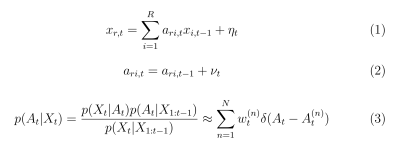 |
17 | Sequential Monte Carlo for studying effective connectivity in fMRI
Mauro Costagli, Ercan Kuruog?lu, Pierfrancesco Ambrosi, Guido Buonincontri, Laura Biagi, Michela Tosetti
The signal fluctuations in Functional Magnetic Resonance Imaging (fMRI) have been proved suitable for investigating brain connectivity. Sequential Monte Carlo methods (“particle filters”) aim at estimating internal states in dynamic systems when only partial and noisy observations are available. Differently from the majority of techniques commonly used for investigating brain connectivity, which assume stationarity, particle filters are designed for stochastic time-varying systems. We present a particle filtering algorithm tailored to fMRI data, whose purpose is to help assessing the presence of causal influences that certain brain areas may exert over others. The algorithm has been validated on a simulated network and applied to real fMRI data.
|
|
3872. 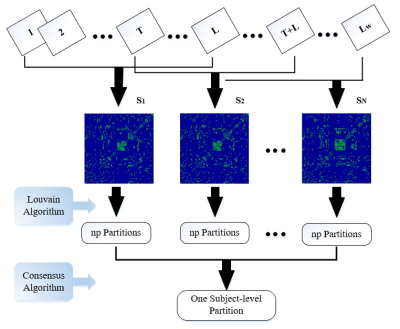 |
18 | A combination of dynamic community structure and machine learning methods in tracking Alzheimer's disease-related functional reorganization
Wenliang Fan
Brain networks have a modular structure in function and this modular organization changes dynamically with time. However, the available brain network modularization methods are limited to detect functional modules for static brain network.So the aim of this sttudy is to propose a consensus algorithm to evaluate the modularization of functional brain network of healthy individuals and patients with Alzheimer's disease.The measures for the modularization of functional brain networks included normalized mutual information (NMI), average participation coefficient and classification accuracy.To evaluate the results from the consensus algorithm, machine learning based classification was performed on a new AD data sets.
|
|
3873. 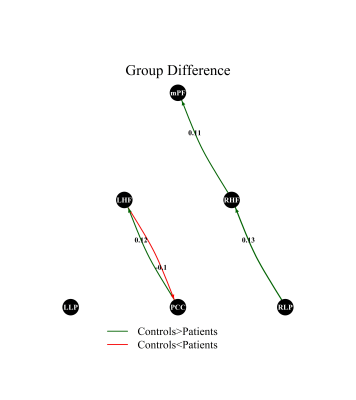 |
19 | Slice Timing Effects on Spectral Dynamic Causal Modeling
Cole Cook, Guyjoon Hwang, Veena Nair, Jedidiah Mathis, Andrew Nencka, Jeffery Binder, Mary Meyerand
Functional MRI may not be slice time corrected when time differences are less than one second. However, these differences may be important for causal neuronal relationships. We investigated slice timing correction in spectral dynamic causal modeling using multiband resting-state data with TR = 802 ms from controls and temporal lobe epilepsy patients. Differences investigated were numeric value, parameter interpretation, and group level models. No significant difference in the first two were found. Group level modeling differences were found. Thus, slice timing correction appears necessary when applying spectral dynamic causal modeling even with slice timing differences of less than one second.
|
|
3874. 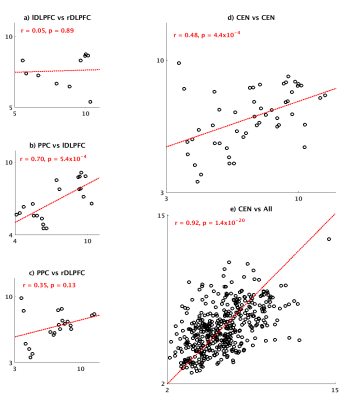 |
20 | Seed-based test-retest reliability of resting state function magnetic resonance imaging at 3T and 7T.
Ajay Nemani, Mark Lowe
A novel hybrid seed-based approach to assess the test-retest reliability of ICNs is introduced that uses an exhaustive but systematic, ROI-limited search for seed pairs with maximal correlation. We examine the reproducibility of these seed pairs and their relation to four well-known ICNs. We then use this approach to assess test-retest reliability between subjects scanned at 3T and 7T field strengths.
|
|
3875.  |
21 | The functional network construction by using Pearson’s correlation, mutual information and convergent cross mapping Presentation Not Submitted
Zhizheng Zhuo, Xiangyu Ma, Lijiang Wei, Zhe Ma, Haiyun Li
To compare and evaluate the functional networks constructed by using Pearson’s correlation, mutual information and convergent cross mapping.
|
|
3876. 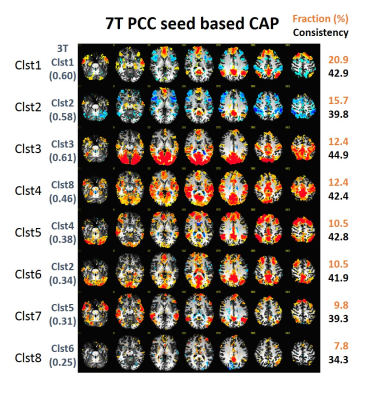 |
22 | Comparison of 3T and 7T PCC seed based spontaneous co-activation analysis
Wanyong Shin, Crawford Anna, Xiao Liu, Mark Lowe
Dynamic functional connectivity techniques are increasingly being used investigate changes in neuronal network during resting state fMRI scanning. The spontaneous co-activation (CAP) approach has been proposed to reduce the dimensionality and shows the potential to characterize dynamic brain network in various ways. This study presents the first 7T CAP analysis, compared CAP analyses at 7T to 3T.
|
|
3877. 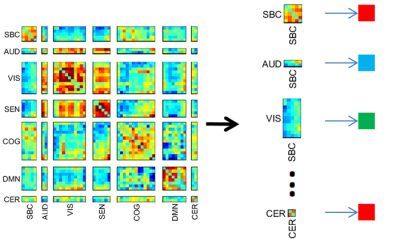 |
23 | Functional Domain Connectivity Strength in Schizophrenia
Victor Vergara, Vince Calhoun
Functional network connectivity (FNC) has been successfully used to detect dysfunctions on the brain of schizophrenia patients. However, this work proposes the idea that effects can be observed when studying functional domains (groups of functionally related brain areas). A set of previously unobserved dysfunctions were detected by studying the domain connectivity strength. Domain connectivity is an important framework for future research of functional connectivity.
|
|
3878. 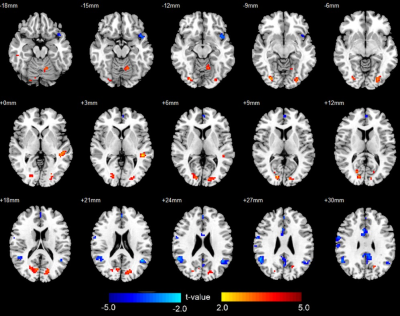 |
24 | Regional Brain Resting-State Neural Activity in Patients with Single Ventricle Heart Disease
Xiaopeng Song, Bhaswati Roy, Sadhana Singh, Ashish Sahib, Nancy Halnon, Alan Lewis, Mary Woo, Nancy Pike, Rajesh Kumar
Patients with single ventricle heart disease (SVHD) commonly show brain structural injuries in autonomic, mood, and cognition regulatory areas. However, whether SVHD subjects have functional impairments in these sites is unknown. We examined regional neural activity changes in SVHD patients, and found reduced regional homogeneity (ReHo) in posterior cingulate, medial prefrontal cortex, inferior parietal lobule, and left insula, and increased ReHo in bilateral middle occipital gyrus, cerebellar cortices, and left superior temporal gyrus over control subjects. These functional changes might be associated with impairments in autonomic, mood, and cognitive functions found in the condition.
|
fMRI Connectivity Applications: Human
Digital Poster
Digital Poster
fMRI
Wednesday, 15 May 2019
| Exhibition Hall | 14:30 - 15:30 |
| Computer # | |||
3880. 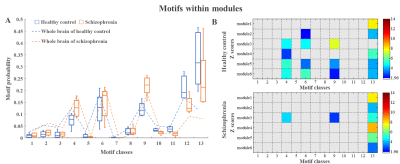 |
26 | Identifying motif patterns of directed brain functional networks in schizophrenia Presentation Not Submitted
Man Xu, Yihao Guo, Kangkang Xue, Jingliang Cheng
In this study, we aimed to investigate the motif patterns of the directed brain functional networks in schizophrenia. We employed the convergent cross mapping approach to measure the directed connections, and calculated the frequency spectrum and the statistical significance of 13 three-node motif classes. Our results showed that the count of all motif classes was significantly reduced, the significance of chain-like motifs was decreased and the significance of loop-like motifs was increased at both whole brain and modular scales in schizophrenia. The motif analyses have potential to provide new insights of the abnormal information flow patterns in schizophrenia.
|
|
3881. 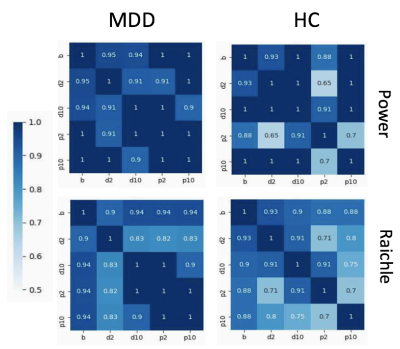 |
27 | Changes in resting state networks in major depression following ketamine administration
Jennifer Evans, Carlos Zarate
Recently, it has been shown that individual classification of subjects across scans is possible using correlation matrices derived from their resting state data. In the current study, a cohort of patient with major depression and healthy controls each had five resting state fMRI scans over the course of a double blind randomized placebo controlled cross-over ketamine infusion study We apply this classification scheme to our data to see if we can link individual functional connectivity profiles to behavioral improvements after ketamine.
|
|
3882. 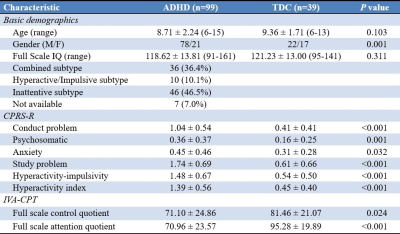 |
28 | Weaker Intra- and Inter-nodal Connectivity of Resting State Networks in Drug-naive Attention-Deficit/Hyperactivity Disorder
Yingxue Gao, Hailong Li, Xuan Bu, Xinyu Hu, Xiaoxiao Hu, Lianqing Zhang, Lu Lu, Shi Tang, Kaili Liang, Yanlin Wang, Chuang Yang, Xiaoqi Huang
We used group-level independent component analysis (ICA) to investigate functional network connectivity in drug-naïve ADHD children. We extracted eight resting state networks and found that lower intranodal and internodal functional connectivity among executive control, precuneus and default mode networks in ADHD children compared to controls, especially located in prefrontal and parietal regions. This finding may provide new insights into functional connectivity alterations in ADHD children and promote the exploration of functional network connectivity in future researches.
|
|
3883. 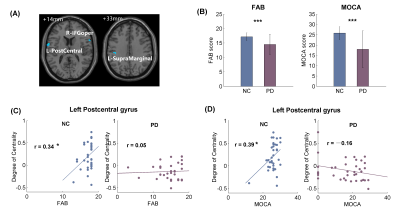 |
29 | Hemisphere-specificity between global synchronization of spontaneous brain activity and movement function in Hippocampus of Parkinson’s disease patients: a resting-state fMRI study Presentation Not Submitted
Yanjun Liu, Mengyan Li, Haobo Chen, Shaode Yu, Guihe Hu, Xiuhang Ruan, Xinhua Wei, Yaoqin Xie
This study enrolled age-match of 36 people with PD and 35 normal controls (NC) in resting-state functional MRI. Altered global signal synchronizations in PD were explored, and correlations between global synchronizations and clinical assessments (cognitive and movement functions) were investigated. Alterations of global synchronizations were observed in left postcentral gyrus (PostC), left supramarginal gyrus and right opercular-inferior frontal gyrus in people with PD. The correlation results imply postcentral gyrus and hippocampus as critical brain regions associated with both cognitive performances and movement functions in PD.
|
|
3884. 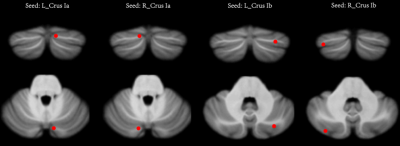 |
30 | Disrupted Cerebellar Connectivity with the Central Executive Network and the Default-mode Network in unmedicated Bipolar II Disorder Presentation Not Submitted
Xiaomei Luo, Guanmao Chen, Yanbin Jia, Jiaying Gong, Shaojuan Qiu, Shuming Zhong, Lianping Zhao, Feng Chen, Shunkai Lai, Zhangzhang Qi?, Long Qian, Li Huang, Ying Wang
The present study aims to investigate the FC between the cerebellum and cerebrum, particularly the central executive network (CEN) and the default-mode network (DMN) in BD II. Seed-based connectivity analyses were performed in 94 unmedicated BD II depression and 100 healthy controls (HCs). Patients with BD II depression showed disrupted FC between the cerebellum and the CEN (mainly in the left dlPFC and ACC) and DMN (mainly in the left mPFC and temporal lobe), suggesting the significant role of the cerebellum-CEN and -DMN connectivity in the pathogenesis of BD.
|
|
3885. 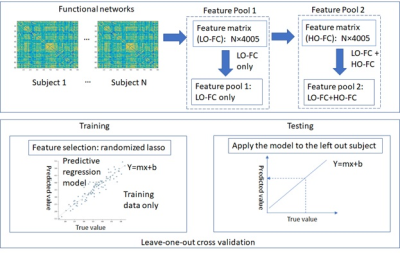 |
31 | Investigating the feasibility of predicting somatosensory function of stroke patients from resting-state functional connectivity
Xiaoyun Liang, Chia-Lin Koh, Chun-Hung Yeh, Alan Connelly, Leeanne Carey
Accumulating evidence from human imaging data supports association between connectivity and outcome after stroke. However, whole-brain functional-connectivity (FC) involves high-dimensional data, which essentially calls for multivariate analysis. Regardless, univariate analysis has been dominantly employed for such studies. More insights into stroke recovery by employing machine learning techniques can be offered due to their multivariate capabilities. In this study, we investigated if residual sensory function (Tactile discrimination threshold, TDT score) of stroke patients can be predicted from resting-state FC. Our results show that TDT scores can be predicted more accurately by combining both low-order and high-order FC than low-order functional connectivity alone.
|
|
3886. 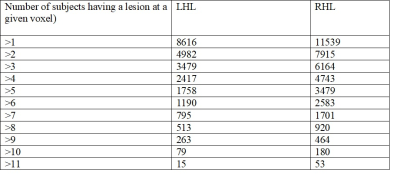 |
32 | Altered functional connectivity manifested by disrupted network modularity in chronic stroke patients
Xiaoyun Liang, Chia-Lin Koh, Chun-Hung Yeh, Alan Connelly, Leeanne Carey
Recent studies have shown that brain connectivity analyses offer valuable information in quantifying network alterations after stroke , which could further enhance our understanding the mechanism of stroke recovery. Given the issue of heterogeneous lesion locations, a recent approach, GMGLASS, is employed to alleviate this issue due to its capability in conducting group comparison studies despite large inter-subject variability. Furthermore, while previous studies have shown that homotopic connections are disrupted due to stroke lesions, how lesion laterality disrupts brain networks, especially at modular level, is not known yet. In this study, we quantified the whole-brain functional connectivity differences using network analysis methods; furthermore, we investigated disruption of homotopic connections at network modular level.
|
|
3887. 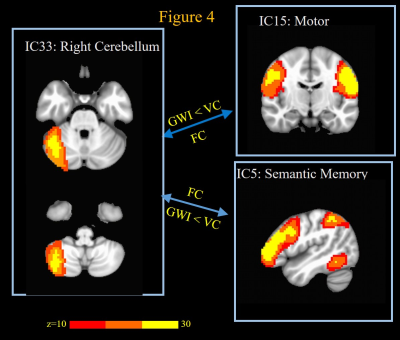 |
33 | Brain mechanisms underlying Gulf War Illness revealed by connectomics signatures of the disease
Kaundinya Gopinath, Unal Sakoglu, Bruce Crosson, Robert Haley
Around 200,000 veterans (up to 32% of those deployed) of the 1991 Gulf War (GW) suffer from GW illness (GWI), which is characterized by multiple deficits in cognitive, emotion, sensory and nociception domains. In this study we examined 60 GWI patients and 30 age-matched controls with resting state fMRI (rsFMRI) in order to map impairments in brain function networks in GWI with group independent components analysis. GWI veterans exhibited impaired/abnormally increased FC between different brain function networks, revealing brain mechanisms underlying neurological impairments in GWI.
|
|
3888 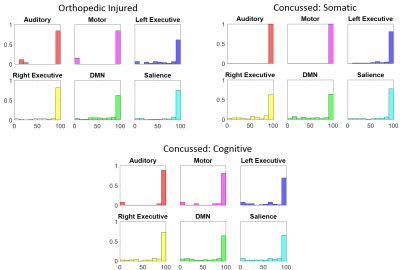 |
34 | Dynamic Functional Connectivity Distinguishes Concussed Youth Based on Symptomology Video Permission Withheld
Raphael Fernandes Casseb, Alexander Barton, Lisa Langevin, Alireza Sojoudi, Keith Yeates, Bradley Goodyear
Concussion in youth is a growing health issue, and accurate diagnostic, progostic and assessment tools are lacking. In this study, we used a toolbox recently developed by our group (HOCo) to investigate dynamic functional connectivity in fMRI datasets obtained from groups of concussed and orthopedic injured (OI) control subjects. We estimated the proportion of the time that regions of the brain are significantly connected within specific networks. We found that concussed youth with somatic symptoms exhibited more stable connections of the motor and auditory networks, relative to OI subjects and concussed youth with cognitive symptoms.
|
|
3889. 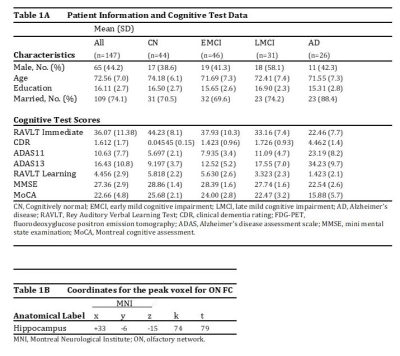 |
35 | Olfactory Network Functional Connectivity with the Hippocampus in Alzheimer’s Disease
Lu Jiaming, Nicole Testa, Rebecca Jordan, Qing Yang, Paul Eslinger, Prasanna Karunanayaka
The rhinencephalic brain regions are specifically vulnerable to AD pathology. This suggests that olfactory assessment may be able to serve as a measure of AD progression. In this research, we investigated the functional connectivity (FC) between the olfactory network (ON) and the hippocampus as a sensitive marker to detect progressive AD pathophysiology. The results show that the ON FC is able to differentiate between early mild cognitive impairment (MCI) and late MCI subjects. As such, ON FC may provide critical insights into relationships between olfactory, memory and, other cognitive deficits in AD.
|
|
3890. 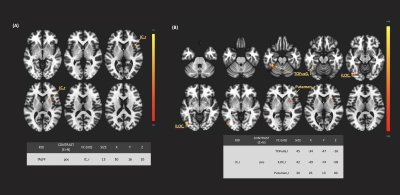 |
36 | Fractional amplitude of low frequency fluctuation associated with chess expertise: possible role of insular cortex
Dan-Ling Hsu, David Ouellette, Patricia Stefancin, Sinduja Tirumalai Govindarajan, Tim Duong
While various expertise domains have been studied extensively, the literature body provides only a few reports on chess expertise at rest. To fill the literature gap of resting-state study on chess expertise, we fALFF differences on a dataset consists of 29 chess experts and 29 novices and found a higher fALFF in the right
|
|
3891. 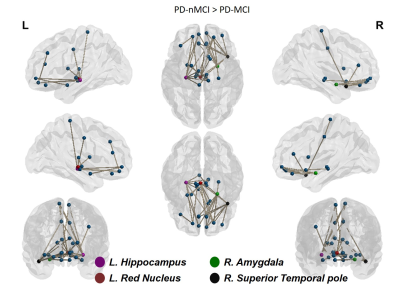 |
37 | Aberrant Functional Connectivity and Network Topology in Parkinson’s Disease Patients with Mild Cognitive Impairment.
Karthik Sreenivasan, Ece Bayram, Sarah Banks, Jason Longhurst, Zhengshi Yang, Xiaowei Zhuang, Dietmar Cordes, Aaron Ritter, Jessica Caldwell, Brent Bluett, Virendra Mishra
Studies have shown that cognitive impairment is a frequent non-motor manifestation of Parkinson’s disease (PD), and can already be detected in 15 to 40% of newly-diagnosed PD patients with up to 80% of patients eventually developing dementia. Our results show decreased functional connectivity between regions known to be implicated in high level cognitive functioning in Parkinson’s disease patients with mild cognitive impairment (PD-MCI) , when compared to the cognitively normal PD patients(PD-nMCI). Furthermore, we found altered network topology in PD-MCI compared to the PD-nMCI group that was differentially correlated with neuropsychological measures.
|
|
3892. 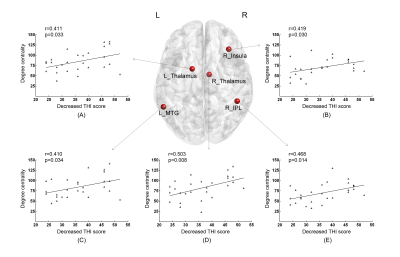 |
38 | Baseline functional connectivity features of the neural network nodes can predict improvement after masking therapy in tinnitus patients
Han Lv, Pengfei Zhao, Zhenghan Yang, Zhenchang Wang
We proved our hypothesis that functional connectivity features of the brain nodes determined by DC have potential in predicting the response of masking therapy.
|
|
3893. 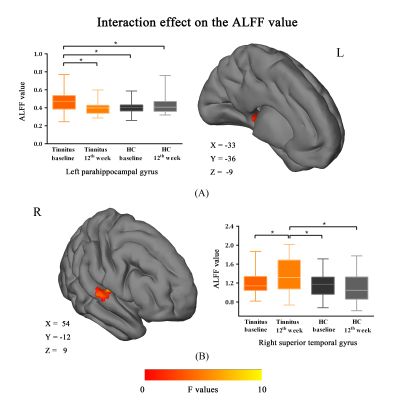 |
39 | The effects of masking therapy in tinnitus patients are characterized by longitudinally altered local activity and functional connectivity
Han Lv, Pengfei Zhao, Zhenghan Yang, Zhenchang Wang
This study is the first to investigate the neural modulation mechanism of long term masking therapy in tinnitus patients by combined employing two analytic methods.
|
|
3894.  |
40 | The effect of 2-month meditation on brain functional connectivity
Zongpai Zhang, Wen-Ming Luh, Wenna Duan, Yang Liu, George Weinschenk, Weiying Dai
The sustained effect of meditation on brain functional connectivity (FC) was evaluated longitudinally in ten college students. FC maps before and after meditation practice were compared and the changes of FC were correlated to practice time. We observed a significantly increased FC between the default mode network (DMN) and the dorsal attention network (DAN), and within DAN. The increased FC between DMN and DAN and within DAN was associated with increased practice time. The findings support fast shifting of attention after practicing meditation for two months and lay a foundation for its clinical transformation if confirmed in a larger study.
|
|
3895.  |
41 | The association between functional brain network and functional outcome after acute ischemic stroke
Shihui Chen, Xiaopei Xu, KK Lau, Leonard SW Li, Yuen Kwun Wong, Christina Yau, Henry KF Mak, Queenie Chan, Hing-Chiu Chang, Edward S Hui
The relation between the functional brain networks and the recovery of acute stroke patients have been investigated. The choice of frequency scale may have major impact on the results of functional connectivity and network analysis. In our study, we acquired resting state data from 11 patients with ischemic stroke and explored longitudinal changes in functional connectivity and brain network measures for various frequency. We also investigated the association between these longitudinal changes and brain functional recovery.
|
|
3896. 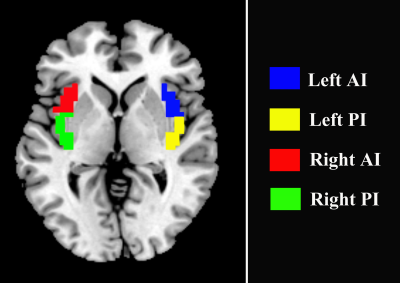 |
42 | Increased Functional Connectivity of Insular Subregions Imporves Smoking Cessation Likelihood
Chao Wang, Minming Zhang
Most smoking cessation attempts result in failure. Damage to the insular cortex disrupts smoking behavior in stroke patients. Neuroimaging studies have shown that chronic smokers had altered functional connectivity (FC) of insular subregions. Here, we further investigated the different FC changes of insular subregions between smokers who quitted successfully and those who relapsed after smoking cessation treatment. We found that smokers who quitted successfully had increased FC of anterior insula, while those who relapse had decreased FC of insular subregions. These novel findings suggest that increased connectivity of insular subregions could imporve likelihood of cessation.
|
|
3897. 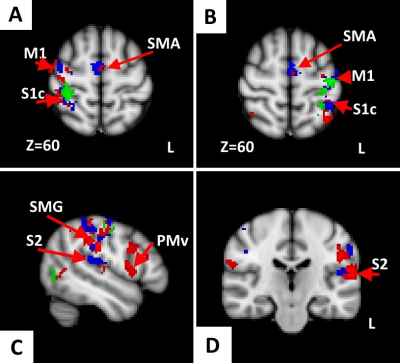 |
43 | Peculiarities of brain activation during dominant hand tactile perception in lateralized Parkinson disease Presentation Not Submitted
Oleksii Omelchenko
Parkinson's disease (PD) in mostly presented with asymmetrical motor symptoms. Disturbed sensorimotor integration and decrease of somatosensory cortex activation
|
|
3898. 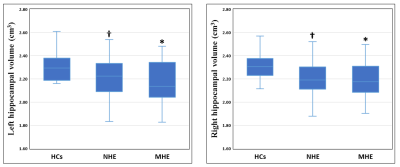 |
44 | Hippocampal atrophy and functional connectivity disruption in cirrhotic patients with minimal hepatic encephalopathy Presentation Not Submitted
Hua-Jun Chen, Zhongshuai Zhang, Tian-Xiu Zou
The hippocampus is a crucial pathological node for minimal hepatic encephalopathy (MHE) and it is associated with various cognitive impairments. We assessed hippocampal FC alterations in relation to regional volume and their associations with PHES results of cirrhotic patient and reached the following findings. (i) Hippocampal volume is significantly lower in MHE. (ii) A disruption of hippocampal connectivity to the default-mode network was observed in the MHE patients. (iii) The bilateral hippocampal FC strength (but not hippocampal volume) was positively correlated with the PHES results of the cirrhotic patients and aggravate with HE progression. Our findings revealed that both structural and functional abnormalities of the hippocampus are involved in the mechanism underlying cognitive deterioration with disease progression.
|
|
3899. 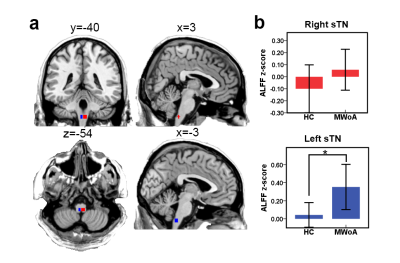 |
45 | Altered the spinal trigeminal nucleus spontaneous brain activity and functional connectivity in female migraineurs without aura
Zhaoxia Qin, Shuai Xu, Shiyu Ban, Jian-Ren Liu, Xiaoxia Du*
The purpose of this study was to investigate spontaneous neuron activity in spinal trigeminal nucleus (sTN) and its intrinsic functional connectivity (FC) with other key structures in migraineurs during resting-state fMRI scans. Thirty-five female migraine without aura (MWoA) during headache interictal phase and 35 age matched female HC were recruited. We found higher ALFF z-value of left sTN in female MWoA. We also found significantly weaker FC between the sTN and caudate putamen (CPu), and dorsolateral prefrontal cortex (DLPFC). Our results help us better understand the pathology of migraine.
|
|
3900.  |
46 | Neural signatures underlying cognitive styles of field independence and field dependence: Evidence from resting-state fMRI Presentation Not Submitted
Shilpi Modi, Deepak Sharma, Mukesh Kumar, Prabhjot Kaur, Imran Khan, Soumi Awasthy, Subash Khushu, Maria D'Souza
Cognitive style refers to the individual differences in the distinct preferences to think, learn, solve problems and to perceive and organize information about the surrounding space. Field dependence/ independence (FDI) is the most widely studied cognitive style and is measured by Group Embedded Figures Test (GEFT) that requires a participant to locate the simple shape embedded in a complex figure. FI subjects are less influenced by the information from the prevailing visual fields and perform better on GEFT as compared to the FD subjects. The cognitive style of an individual has been shown to be related to their cognitive functioning especially spatial memory performance, learning and retrieval of
|
|
3901. 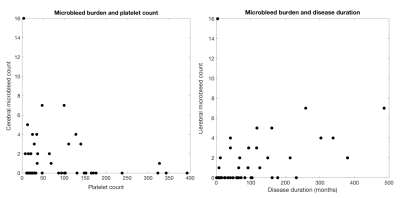 |
47 | Resting-state network distinguishes level of cerebral microbleed burden in patients with Immune Thrombocytopenia
Melanie Morrison, Nichola Cooper, Camelia Vladescu, Adam Waldman
In this study we evaluated resting state networks associated with cerebral microbleed presence in patients diagnosed with Immune Thrombocytopenia and identified a potential correlate of tiredness in the right superior parietal lobule.
|
|
3902. 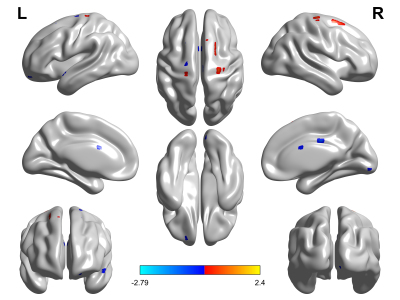 |
48 | Differences in resting state fMRI alterations between left and right early Bell’s palsy
Xiaowei Han, Lei Du, Wenwen Gao, Guolin Ma, Lizhi Xie
Bell’s palsy is defined as an idiopathic unilateral facial nerve palsy. Sixty-seven patients and 37 age- and sex-matched healthy controls were recruited in this study. Brain fractional amplitude of low-frequency fluctuation (fALFF) and and following functional connectivity (FC) were analyzed between left and right palsy groups. The results revealed brain reintegrating mechanisms differed between patients with left and right Bell’s palsy.
|
|
3903. 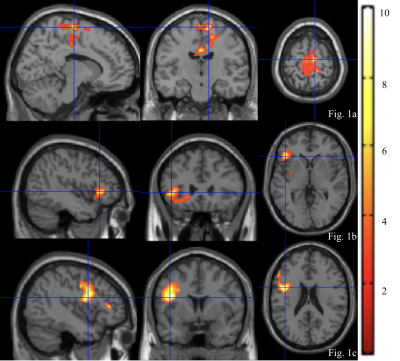 |
49 | Effect of meditation on brain function activated by an attention task Presentation Not Submitted
Yang Liu, Wenna Duan, Zongpai Zhang, George Weinschenk, Wen-Ming Luh, Weiying Dai
The effect of meditation on brain functional activation when engaged in an attention task was evaluated longitudinally using BOLD fMRI in nine young healthy subjects. Functional activation before and after meditation practice was compared and the change of functional activation was correlated with practice time. Following the meditation practice, response time to the attention task was significantly shorter; functional activation in the somatomotor network, frontal, basal ganglia, and insular regions was significantly reduced; more practice time was associated with less reduced activation. The findings suggest that meditation can improve brain efficiency but may have a complex neural mechanism.
|
|
3904. 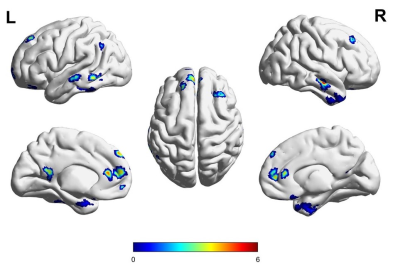 |
50 | Default mode networks connectivity characterization in young adults with sickle cell disease using 7T resting functional magnetic resonance imaging
Nadim Farhat, Helmet Karim, Tales Santini, Neilesh Vinjamuri, Howard Aizenstein, Enrico Novelli, Tamer Ibrahim
In this study, we investigated altered resting state default mode network (DMN) connectivity using functional magnetic resonance imaging (rs-fMRI) at 7T in young adults(n=13) with sickle cell disease. The DMN of SCD of young adults had higher connectivity as compared to a healthy controls(n=9 ) gender, age, and racially matched group.
|
fMRI: Analysis Methods
Digital Poster
Digital Poster
fMRI
Wednesday, 15 May 2019
| Exhibition Hall | 14:30 - 15:30 |
| Computer # | |||
3905. 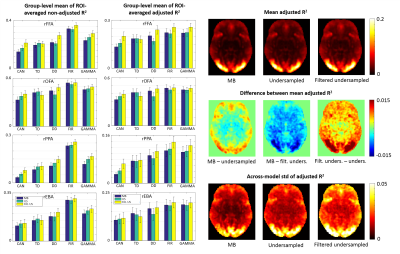 |
51 | Evaluation of GLM fit dependency on the temporal sampling rate and the applied HRF model in BOLD fMRI
Virág Darányi, Petra Hermann, Zoltán Nagy, Zoltán Vidnyánszky, Ádám Kettinger
Modeling the haemodynamic response in fMRI is still subject of research. Recent developments in accelerated MRI enabled subsecond whole-brain fMRI. In this work we aim to examine the dependency of BOLD signal analysis on the temporal sampling rate and the applied HRF model by numerically undersampling a fast acquisition. Standard GLM fits with different HRF models were performed, followed by group-level statistical analyses and goodness-of-fit computations. The results indicate that variance across HRF models is increased in the undersampled datasets, while the low-pass-filtered undersampling also shows a possibility to enhance the statistical power on the group level.
|
|
3906.  |
52 | Impact of small parcellation changes on global and local brain connectivity metrics: a study of resting state fMRI
Francesca Bottino, Martina Lucignani, Camilla Rossi Espagnet , Daniela Longo, Antonio Napolitano
This work studied the impact of small parcellation changes on functional brain connectivity metrics. The study made use of Rs-fMRI dataset formed of 73 healthy controls and 73 schizophrenic patients. Brain parcellation was performed with standard atlasDKT40. Starting from this parcellation, fifty new parcellations were created by randomly modifying it. Weighted and unweighted adjacency matrices were constructed. 38 local and global network measures were derived. Brain connectivity measure variation factor was computed for each analysed measure. This study identified measures that are more robust with respect to spatial error in parcellation.
|
|
3907. 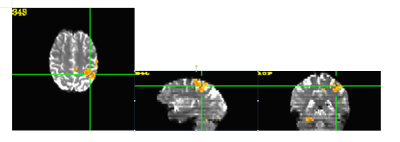 |
53 | Automatic seed selection for resting state fMRI data analysis by using machine learning
Mingyi Li, Katherine Koenig, Jian Lin, Mark Lowe
To facilitate seed-based resting state fMRI (rs-fMRI) data analysis, we have been developing a method to automatically compute the seed location by using anatomical and rs-fMRI data. In the method, self-organizing map (SOM) is used to cluster voxels within searching ROI and then the seed locations are derived from the voxel clusters. The methods were tested on ten subjects to find seed in the motor cortex. The computed seeds successfully matched unilateral finger tapping fMRI maps in eight out of ten subjects.
|
|
3908. 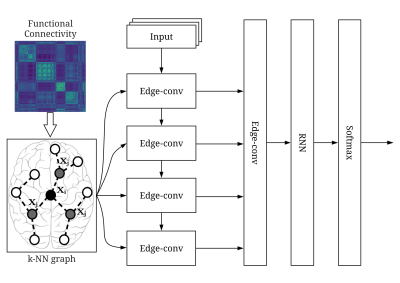 |
54 | Recurrent Edge-Convolutional Neural Network for Individual Identification Using Resting-state fMRI Data
Lebo Wang, Kaiming Li, Xu Chen, Xiaoping Hu
Convolutional neural networks extract local features effectively on volumetric data. For the ROI-based fMRI data, we proposed the recurrent edge-convolutional neural network to model spatial coactivation pattern and dynamics. Edge-convolution could depict the relation between hyper-neighborhoods based on pre-computed functional connectivity and
|
|
3909. 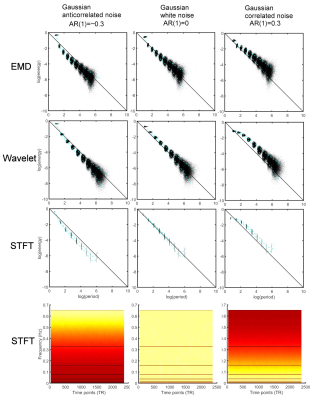 |
55 | Empirical Mode Decomposition and Energy-Period Characteristics of Brain Networks in Group fMRI Resting-State Data
Dietmar Cordes, Zhengshi Yang, Xiaowei Zhuang, Muhammad Kaleem, Tim Curran, Karthik Sreenivasan, Virendra Mishra, Rajesh Nandy
In this project, we have studied resting-state networks using Empirical Mode Decomposition (EMD) to obtain energy-period information and compared results with the Maximal Overlap Discrete Wavelet Transform (MODWT) and the Short-Time Fourier Transform (STFT). We chose the STFT and MODWT for comparison with EMD, because the STFT is based on Fourier basis functions, the MODWT allows more adaptivity but still is model-based by wavelet functions, and EMD is model-free, adaptive and entirely data-driven. EMD showed the strongest relationship to frequency and energy content for different clusters of resting-state networks.
|
|
3910. 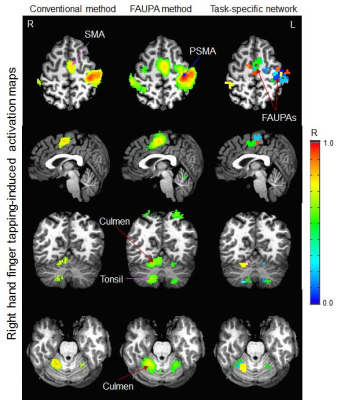 |
56 | Human brain task-specific network mapping
Jie Huang
The activity of neural networks gives rise to simple motor behaviors as well as complex behaviors. To understand how the network activity is transformed into human behaviors, it is necessary to identify task-specific networks and analyze the dynamic network activity that changes with time. A functional area of unitary pooled activity (FAUPA) is defined as an area in which the temporal variation of the activity is the same across the entire area. Using the signal time course of a task-associated FAUPA may identify the functional network specific for the task. This study introduced a novel method to map task-specific networks.
|
|
3911. 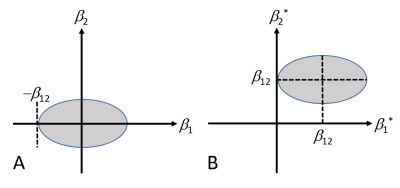 |
57 | Combination of Primary and Temporal Derivative Estimates in Functional MRI
Kwan-Jin Jung
In the general linear model analysis of a task fMRI, the response latency was analyzed by including a derivative parameter estimate of the hemodynamic response function. The existing method of combining the two estimates was improved to provide a more appropriate sign and amplitude of the combined estimate, which was presented in 2018 ISMRM. The last year’s method has been further improved to determine the sign of the combined estimate using a coordinate transformation method and to regulate the variance of the combined estimate by introducing an ellipse model. The new WSA method was experimentally confirmed using the HCP database.
|
|
3912. 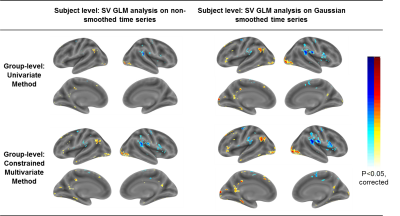 |
58 | Multivariate group-level analysis to detect fMRI task activation
Xiaowei Zhuang, Zhengshi Yang, Tim Curran, Rajesh Nandy, Dietmar Cordes
A constrained multivariate model is introduced for fMRI group-level analysis to increase the sensitivity in group activation detection by incorporating local neighboring information. Results from both simulated data and real episodic memory data indicate that a higher detection sensitivity for a fixed specificity can be achieved in group-level activation detection with the proposed method. Applying multivariate analysis in both subject and group levels of analysis can further improve the activation detection performance. Statistical thresholds for significance of the group-inferences in the multivariate method are computed non-parametrically.
|
|
3913. 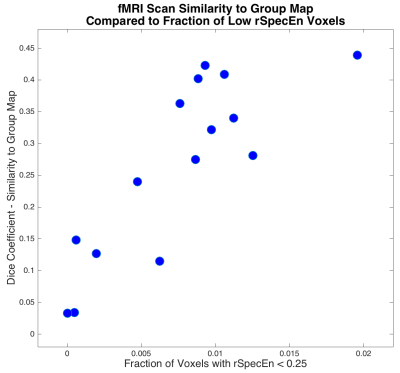 |
59 | Spectral Entropy: A Useful Engineered Feature for Classification of fMRI Data Quality?
Christopher O'Grady, Steve Patterson, Alessandro Guida, James Rioux, Antonina Omisade, Javeria Hashmi, Steven Beyea
This work evaluates the use of regularized spectral entropy (rSpecEn) as a potentially useful engineered feature for the classification of fMRI scan quality in real time. rSpecEn relies on the frequency sparsity of task-based fMRI signals, and a data-driven regularization method is employed to counteract unavoidable noise. Comparison to known measures of quality are used, as well as the use of fMRI scans with intentionally degraded quality. Sensitivity to fMRI data quality measures and an exploration of high accuracy scan quality classification are presented in this feasibility study.
|
|
3914. 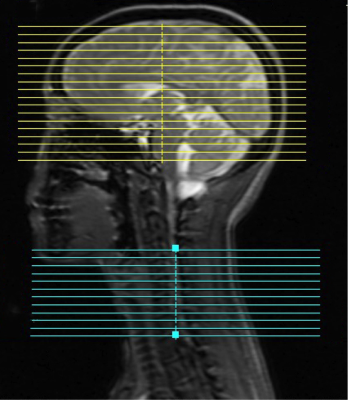 |
60 | Physiological Noise Correction in Simultaneous Brain and Spinal Cord fMRI
Christine Law, Ken Weber, Robert Barry, Sean Mackey, Gary Glover
Effect of RETROICOR and RVHRCOR on brain and spinal cord activation is qualified from simultaneously acquired fMRI motor task data. tSNR and activation volume at subject-level are examined using (1) no physiological noise correction, (2) RETROICOR only, (3) RETROICOR and RVHRCOR. Although RETROICOR and RVHRCOR improve tSNR in both brain and spinal cord while removing false activation in brain, these corrections can remove true activation in spinal cord. Examination with and without physiological correction is the only known way to determine whether subject-level activation were removed by noise correction. In general, an increase in activation volume after physiological noise correction is a good indicator of little correlation between physiology and task.
|
|
 |
3915. 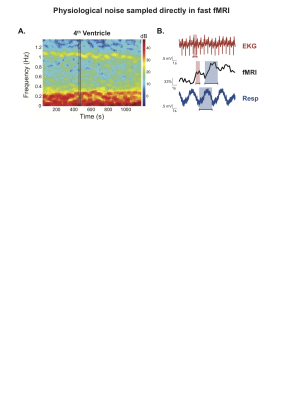 |
61 | Physiological noise removal in fast fMRI without separate physiological signal acquisition
Uday Agrawal, Emery Brown, Laura Lewis
Recent work has shown that commonly used methods to account for physiological noise and serial correlations in conventional fMRI are inadequate for fast (TR<500 ms) fMRI and may lead to incorrect inferences1. We created a model of physiological noise based on harmonic regression with autoregressive noise that utilizes the enhanced sampling of fast fMRI to estimate physiological noise directly from the fMRI data; therefore, it does not require physiological reference signals such as respiration. We found that our model performs as well as gold standard reference-based approaches in removing physiological noise and improves the detection of task-driven fMRI activity.
|
3916 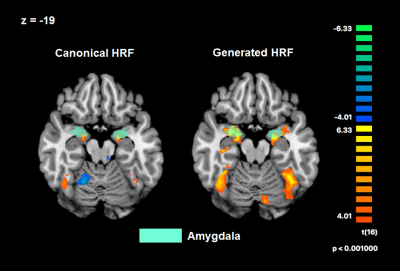 |
62 | Improvement of functional sensitivity using multi-echo EPI and BOLD response based HRF model at 7T Video Permission Withheld
Uksu Choi, Toshiko Tanaka, Masahiko Haruno, Ikuhiro Kida
To study amygdala function, we used multi-echo EPI sequence as fMRI at 7T to reduce the effects of local magnetic field inhomogeneity in the region. Additionally, to increase sensitivity, we modified a hemodynamic response function model from an empirical model. These methods allowed us to detect robust activation of the amygdala and brain areas related to emotional face discrimination tasks in addition to increased functional connectivity between them. Using an appropriate acquisition method and statistical model can improve sensitivity in regions whose signal is suffered by local magnetic field inhomogeneity in ultra-high field fMRI studies.
|
|
3917 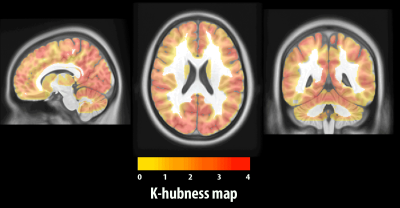 |
63 | Oxygen and Glucose metabolism in connector hubs estimated from resting-state fMRI Video Permission Withheld
Fatemeh Razavipour, Kangjoo Lee, Stephane Blinder, Jean-Paul Soucy, Claudine J. Gauthier, Christophe Grova
Connector hubs are highly functionally connected regions of the brain, allowing efficient distant communication between segregated modules. To study their metabolism we localized them from resting-state fMRI data using a Sparsity-based analysis method and estimated the number of functional networks associated with each voxel (K-hubness). We used quantitative MRI with gas manipulations to estimate baseline cerebral metabolic rate of O2 (CMRO2), cerebral blood flow, oxygen extraction fraction, and FDG-PET to estimate the resting cerebral metabolic rate of Glucose (CMRGlu). Our results showed a power-law model of the relationship between K-hubness and their CMRO2 and CMRGlu, confirming the metabolic efficiency of hubs.
|
|
3918. 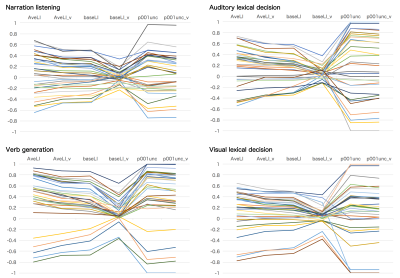 |
64 | Which lateralization index and which language task should we use in lateralization test?
Kayako Matsuo, Kazufumi Akiyama, Yasushi Kaji
It is crucial to select a good language task in fMRI to examine the language lateralization. We examined the concordances of 6 lateralization indices (LIs) using 4 language tasks. We confirmed that our previously developed LI, AveLI, showed a better concordance of index values across 4 tasks. Also, the verb generation task showed a better concordance across the 6 LIs than other tasks. In addition, this task showed a plausible ratio of rightward asymmetry (5 out of 16 left/both-hand preferred). Thus, we concluded to conduct the verb generation task and compute AveLI as a robust index of the language lateralization.
|
|
3919 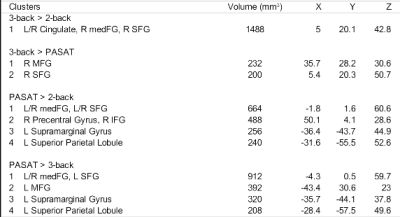 |
65 | An ALE meta-analytic comparison of verbal working memory tasks Video Permission Withheld
Timothy Wanger, Lawrence Sweet
The n-Back and Paced Auditory Serial Addition Test (PASAT) are common verbal working memory tasks (VWM). Activation Likelihood Estimation (ALE) meta-analyses examined n-Back and PASAT literature, revealing regions associated with salience, emotional processing, and VWM. Contrasts revealed differential dorsolateral prefrontal cortex, left posterior parietal cortex, and midline supplementary motor area activation between the tasks. Findings demonstrate the sensitivity of ALE meta-analysis to reveal similarities and differences associated with the cognitive and emotional aspects of VWM tasks. They provide the first glimpse into regions activated by the PASAT using meta-analyses that indicate potential overlapping utility.
|
|
3920. 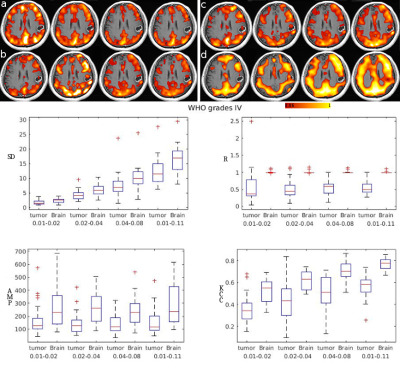 |
66 | Assessment of Global and Regional Difference of Resting State Cerebral Vascular Reactivity index in Patient with Brain Tumor
Mehrnaz Jenabi, Kyung Peck, Madeleine Gene, Andrei Holodny
The resting state fMRI (rfMRI) was used to estimate the BOLD signal change in response to natural breathing to measure the impairment of cerebra vascular reactivity (CVR) due to the presence of tumor. CVR associated values were obtained from the low frequency fluctuation of rfMRI and averaged over whole brain and tumor region of interests to measure the frequency related CVR properties respectively. These results indicate the existence of inter/intrasubject variability in low frequency and more sensitivity of the whole brain homogeneity to frequency rather than tumor. CVR mapping can determine the area of potential neuro-vascular uncoupling in the brain.
|
|
3921. 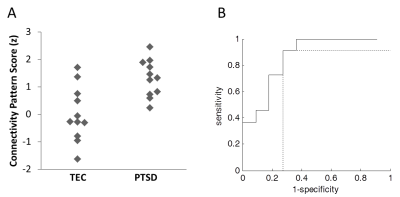 |
67 | Abnormal brain network configuration associated with posttraumatic stress disorder: a novel combined approach using graph theory and scaled subprofile modeling
Natalie Wright, Ronak Patel, Candice Monson, Todd Girard, Ji Hyun Ko
Posttraumatic stress disorder (PTSD) is a prevalent psychiatric disorder with etiology and symptom expression that can vary greatly among patients. Currently, no objective clinical biomarker exists for assessing clinical severity and treatment response. In order to develop a reliable method of characterizing PTSD, we must understand how the brain changes in response to trauma. We propose a novel approach, combining graph theory analysis and scaled subprofile modeling (SSM) to identify degree centrality and its group-discriminating topographical patterns, respectively. This method has been successful in distinguishing fMRI scans of PTSD patients from trauma-exposed controls, and resulted in a reliable PTSD-related network configuration.
|
|
3922.  |
68 | Diagnosing first-episode depression with high-order regional homogeneity
Li-Ming Hsu, Yujie Liu, Han Zhang, Shijun Qiu, Dinggang Shen
The brain is a dynamic biosystem where the regions communicate with each other in a time-varying and adaptive way. Recently, abnormally varied brain statuses in brain diseases have been demonstrated with dynamic functional connectivity (FC) and a newly developed technique, high-order FC, which measures synchronization of the FC dynamics, providing a valuable way to characterize high-level brain function. However, there is a lack of method in quantification of local synchronization of the FC dynamics, another important facet of the high-level brain functional organization that could underpin complex regional brain activities. To this end, we propose a new method called high-order regional homogeneity (high-order ReHo) to evaluate such complex organizations of the local FC dynamics. We demonstrated that such a metric is more sensitive compared to the traditional low-order ReHo approach in individualized depression classification.
|
|
3923 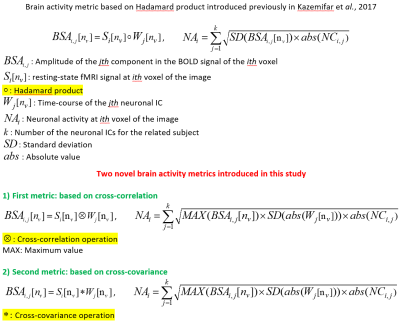 |
69 | Brain Activity Mapping Based on Low-Frequency Fluctuations of the Resting-State BOLD Signal: Comparing Healthy Elderly to Mild Cognitive Impairment and Alzheimer’s Disease Video Permission Withheld
Seyyed M. H. Haddad, Christopher J. M. Scott, Stephen R. Arnott, Miracle Ozzoude, Stephen C. Strother, Sandra E. Black, Michel J. Borrie, Elizabeth Finger, Maria C. Tartaglia, Donna Kwan, Derek Beaton, Sean Symons, Andrea Soddu, Manuel Montero-Odasso, Robert Bartha
Our group recently introduced a neuronal activity (NA) metric based on a texture feature of the low-frequency fluctuations within the resting-state BOLD signal. This NA measure was associated with decreased glucose metabolism in mild Alzheimer’s disease (AD) measured by FDG-PET. To improve the sensitivity of this NA metric we introduce two variations achieved by rigorously regulating (using cross-correlation and cross-covariance) the amplitude of the BOLD signal oscillations derived from the constituent neuronal components. These novel metrics were evaluated in people with mild cognitive impairment and AD (N=14) demonstrating lower neuronal activity compared to healthy elderly (N=14).
|
|
3924.  |
70 | Relative assessment of language lateralisation with fMRI: evaluation of a novel threshold-independent method
Irène Brumer, Enrico De Vita, Jonathan Ashmore, Jozef Jarosz, Marco Borri
The assessment of language lateralisation with fMRI using the laterality index is limited by the dependence of the results on the chosen activation threshold. To overcome this limitation, different threshold-independent laterality index calculations have been introduced. This work proposes a new method and evaluates how it performs in comparison with three previously reported methods. The methods were evaluated on fifteen healthy subjects who performed picture naming, verb generation, and word fluency tasks. The novel method is simple to implement, fast, robust, reproducible, and compares well with the others in differentiating strong from weak lateralisation on both hemispheric and regional scales.
|
|
3925.  |
71 | Automatic classification of Type 2 diabetes mellitus with and without microangiopathy via feature selection and support vector machine based on resting-state fMRI Presentation Not Submitted
Jingge Lian, Jilei Zhang, Maolin Li, Kangan Li*
Type 2 diabetes (T2DM) mellitus is associated with microvascular complications which can increase risk of cognition impairment and dementia. Recently, machine learning, espicailly support vector machine, were introduced to functional MRI studies in individual classification of diseases. In current study, we used support vector machine to perform individual classification of T2DM with (T2DM-C) and without (T2DM-NC) microangiopathy using ALFF and ReHo features based on rs-fMRI data. The selected features were determined to be key features for classification between groups using recursive feature elimination and may be associated with abnormalities of the spontaneous brain activity in T2DM-C
|
|
3926. 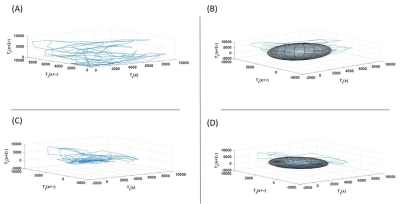 |
72 | Schizophrenia Patients Exhibit Aberrant Phase-Space Embedding of CEN/DMN Interaction
Zhenhai Zhang, Kaiming Li, Xiaoping Hu
A proper method for distinguishing Schizophrenia (SZ) patients from people belonging to normal controls is invaluable for diagnostics. Standard techniques of identifying SZ patients include a variety of clustering-based methods. For example, those based on
|
|
3927. 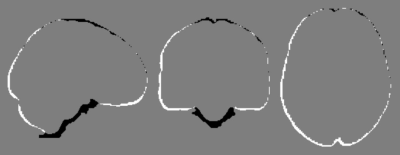 |
73 | Construction of high precision and resolution render files for SPM and XJview
Weiwei Men, Xu Cui, Lang Qin, Jia-Hong Gao
Render file is one of the typical formats used to display brain surface in brain analysis software such as SPM and XJview. However, current images of render files included in SPM and XJview have issues of low resolution, blurring, and inaccurate spatial localization. Therefore, it is necessary to create a render file with high precision and resolution to better display the activation results generated in SPM. In this study, a set of improved render files were constructed using a modified ICBM_2009c template.
|
|
3928. 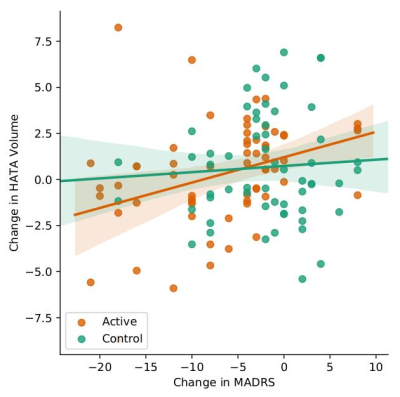 |
74 | Real-time fMRI amygdala neurofeedback training reduces depression symptoms and appears to normalize amygdala and hippocampal volumes
Beni Mulyana, Masaya Misaki, Kymberly Young, Vadim Zotev, Jennifer Stewart, Samuel Cheng, Jerzy Bodurka
We evaluated structural brain changes as a result of real-time fMRI neurofeedback (rtfMRI-
|
|
3929. 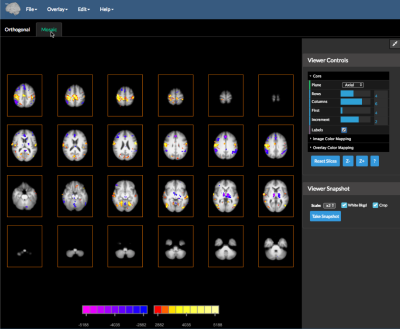 |
75 | Live figures in BioImage Suite Web for improved results, visualizations, and data transparency
Dustin Scheinost, Zachariah Saltzman, Cheryl Lacadie, Haley Garbus, John Onofrey, Xenophon Papademetris
Figures of neuroimaging results are typically static. In other words, these figures only show the slices and statistical information that the creator of the figures previously selected. However, other researchers may want to visualize other information. Here, we present “live figures” using the BioImage Suite Web (BISWeb) software. “Live figures” represent an encapsulation of all information used to make the figure (i.e. images, slice, thresholds, colormap, etc) that is than saved to a file and can be loaded back into BISWeb. The only requirement to view these “live figures” is a modern web-browser. No other software needs to be installed.
|
fMRI: Acquisition & Artefacts
Digital Poster
Digital Poster
fMRI
Wednesday, 15 May 2019
| Exhibition Hall | 14:30 - 15:30 |
| Computer # | |||
3930. 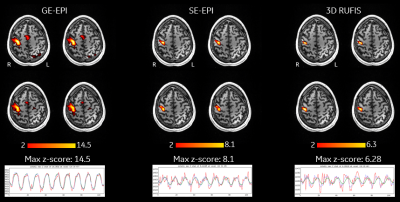 |
76 | Quiet, Low-Distortion Whole Brain T2-BOLD fMRI at 7T
Brian Burns, Trevor Flynn, Ana Solana, Peng Cao, Angela Jakary, Anne Menini, Florian Wiesinger, Peder Larson
EPI-based 7T fMRI techniques suffer from spatial distortions in areas of B0 inhomogeneity, signal dropout near air-tissue boundaries, and gradient induced acoustic noise can be as high as 115-120dB. We have developed fast, quiet, low-distortion whole brain 7T fMRI by using the T2-prepared Rotating Ultrafast Imaging Sequence (RUFIS). RUFIS is a ZTE technique with low gradient switching, so it does not suffer from many of the problems of EPI-based methods. It has no spatial distortions and signal dropout, and is 40dB quieter than standard EPI-based technique. Whole-brain 3mm isotropic results for resting state and task-based 7T fMRI experiments are shown.
|
|
3931.  |
77 | Rotated Stack of Spirals 3D RARE for Single-shot Volumetric ASL Acquisition
Fanny Munsch, Manuel Taso, Li Zhao, R. Lebel, Arnaud Guidon, David Alsop
Single-shot accelerated volumetric Arterial Spin Labeling is desirable for studies of flow and function modulation but it typically degrades image quality relative to multi-shot interleaved acquisitions. We report a Stack of Spirals RARE acquisition with rotation of spirals between slice encodes and repetitions. This acquisition supports high quality single-shot reconstruction with 3D parallel imaging/compressed sensing while retaining the ability to perform conventional interleaved reconstruction of time averaged perfusion. Application of the sequence to quantification of resting state network fluctuations is demonstrated.
|
|
3932.  |
78 | Improving the sensitivity of Spin-Echo fMRI at 3.0 T by highly accelerated acquisitions
Antonia Barghoorn, Bruno Riemenschneider, Fei Wang, Juergen Hennig, Pierre LeVan
Spin-echo fMRI can be highly advantageous compared to gradient-echo fMRI with respect to magnetic field inhomogeneity artefacts, but is seldomly used for BOLD imaging due to its inferior sensitivity. The presented spin-echo implementation of a highly accelerated gradient-echo fMRI pulse sequence therefore aims to improve the sensitivity of spin-echo fMRI while profiting from a reduction of inhomogeneity-induced artefacts. Preliminary measurements using a temporal resolution of 134 ms for whole brain imaging show less signal dropout when compared to the gradient-echo counterpart, as well as an increase in the number of significantly activated voxels compared to the unaccelerated readout.
|
|
3933. 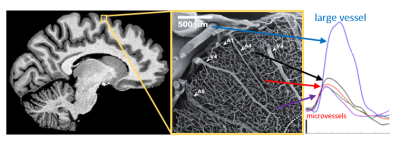 |
79 | Implementing human line-scanning fMRI: Initial results of ultra-high temporal and spatial resolution fMRI
Jeroen Siero, Icaro de Oliveira, Sangcheon Choi, Xin Yu
Here we present the initial results on implementing human line-scanning fMRI with the purpose of obtaining ultra-high temporal and spatial resolution data of hemodynamic changes in the human brain. This technique could yield novel insights for fundamental neuroscience on laminar information flow, but also for better understanding of microvascular pathophysiological mechanisms in a wide range of brain disorders.
|
|
3934. 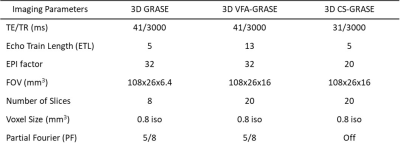 |
80 | Sub-Millimeter Resolution Compressed Sensing GRASE for T2-Weighted Functional MRI at 7 Tesla
Suhyung Park, Alexander Beckett, David Feinberg
At high magnetic field, 7T and above, T2-weighted fMRI has drawn attention for its high specificity in columnar and layer specific fMRI by minimizing draining vein effects compared to T2*-weighted GE-EPI based fMRI. 3D inner-volume gradient and spin echo (3D-GRASE) has been proposed and used for sub-millimeter resolution. However, reduced field-of-view (FOV) imaging in general has disadvantages compared to GE-EPI: 1) small FOV, 2) T2 induced blurring, both along the partition direction, and 3) low signal-to-noise ratio (SNR) from long TE with EPI readouts. To address both issues, 3D GRASE is extended to volumetric ky-kz random undersampling followed by performing CS for signal recovery (3D CS-GRASE). The ky-kz undersampling extends volume coverage without compromising the blurring while enhancing SNR due to short TE from inplane undersampling.
|
|
3935. 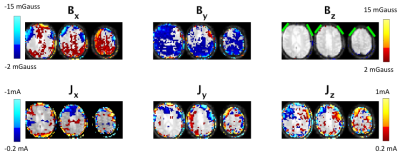 |
81 | MR Imaging of Current Vector Fields Induced by TDCS
Luis Hernandez-Garcia, Jonas Schollenberger, Eric Michielssen, John Jonides, Doug Noll
The present study introduces a method to measure the full current density vector field induced by a transcranial direct current stimulation (TDCS) device. Our proposed method uses MRI to measure components of the magnetic field with the phantom/head in different positions. We introduce the theory and demonstrate the method on a current phantom and a human volunteer.
|
|
3936. 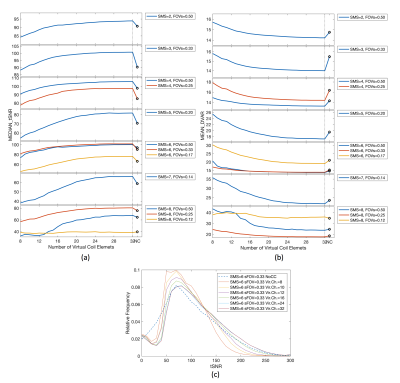 |
82 | Effect of Coil Compression on tSNR, DVARS and Computation Time on Simultaneous Multi Slice Imaging
Volkan Emre Arpinar, Kevin Koch, Sampada Bhave, L Tugan Muftuler, Baolian Yang, S Sivaram Kaushik, Suchandrima Banerjee, Andrew Nencka
Simultaneous multi-slice (SMS) imaging requires the application of a parallel imaging algorithm for image unaliasing. Including coil compression in SMS image reconstruction offers a benefit of reducing the computational load of the reconstruction algorithm and can better condition the matrix which is inverted in the unaliasing algorithm. The goal of this abstract is to evaluate the optimal level of coil compression to utilize with slice-ARC in Human Connectome Project (HCP) compliant, and other SMS protocols with a Nova Medical 32-channel head coil. It was found that, for all levels of coil compression, application of the compression algorithm yielded a benefit in reconstruction performance. Additionally, it was found that the application of coil compression does not significantly impact the selection of a CAIPI shift factor unless a coil compression of 50% or greater is used.
|
|
3937. 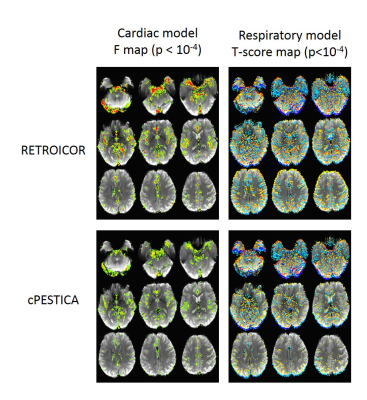 |
83 | Time variant cardiac noise correction in resting state fMRI without physiologic noise measures
Wanyong Shin, Mark Lowe
The cardiac and respiratory response functions derived from RETROICOR have substantial variation. We found the cardiac response function is phase, or time shifted across the brain while the respiratory function has a fixed phase, but changes polarity across the brain. Based on this finding, we propose a cardiac and respiratory noise correction method in rsfMRI data without external cardiac and respiratory fluctuation measures, and compare its performance to the RETROICOR model.
|
|
3938. 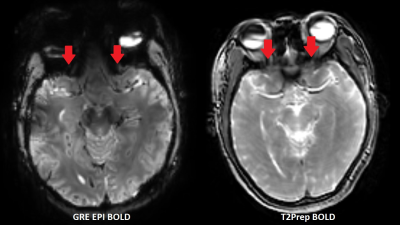 |
84 | Olfactory functional MRI (fMRI) using T2-prepared BOLD fMRI at ultra-high field (7T)
Adrian Paez, Suraj Rajan, Grace-Anna Chaney, Xinyuan Miao, Di Cao, Chunming Gu, Dapeng Liu, Alex Pantelyat, Liana Rosenthal, Zoltan Mari, Kelly Mills, Ted Dawson, Peter van Zijl, Susan Bassett, David Yousem, Vidyulata Kamath, Jun Hua
The olfactory cortex is difficult to image with conventional EPI-fMRI due to susceptibility artifacts especially at 7T. T2-prepared (T2prep) fMRI is an alternative method to reduce such artifacts. Here, we show that T2prep-fMRI offers superior temporal signal-to-noise ratio in the olfactory cortex over EPI-fMRI at 7T. The signal characteristics detected using T2prep-fMRI during short (6s) and long (60s) olfactory stimulation were consistent with literature. During the long stimulus, fMRI signals in the olfactory cortex returned to baseline in 5-10s, and activation of secondary olfactory regions (insular, orbitofrontal) were observed, which can be attributed to habituation effects in the olfactory system.
|
|
3939. 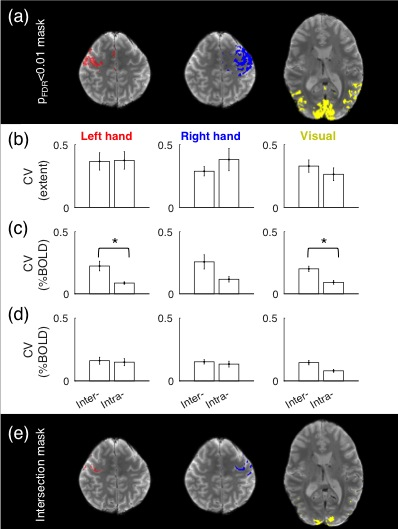 |
85 | Inter-site repeatability of motor-visual task fMRI responses at 7 Tesla
Ian Driver, Olivier Mougin, William Clarke, Catarina Rua, Andrew Morgan, Adrian Carpenter, Keith Muir, David Porter, Christopher Rodgers, Stuart Clare, Susan Francis, Richard Bowtell, Richard Wise
This work studies cross-site variability in 7 Tesla task fMRI measurements, collected as part of a “travelling heads” study. Participants were scanned at the five human UK 7 Tesla MRI sites, and results are presented from four of these sites. A motor-visual task was performed at each site with acquisitions matched as closely as possible. Despite some apparent differences in tSNR , we demonstrate that it is possible to achieve good agreement across sites. The %BOLD coefficient of variation of 0.1-0.2 across sites was similar to the within-site ranges. This work sets the foundation for multi-site 7 Tesla clinical trials.
|
|
3940. 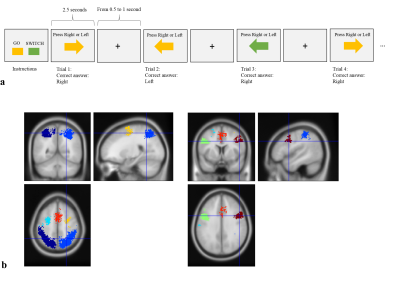 |
86 | Effect of spatial smoothing of the data acquired with Multiband and 3D EPI in functional MRI.
Nadège Corbin, Oliver Josephs, Lise Aujoulat, Clare Loane, Martina Callaghan
2D-EPI Multiband and 3D-EPI are commonly used approaches to acquiring high-resolution fMRI scans while maintaining reasonable scan times. In this work, the relative merit of these methods was investigated with respect to acceleration factor, coverage, physiological noise correction, and smoothing kernel. Both methods performed equivalently in term of activation t-scores and temporal SNR, regardless of the coverage or acceleration when no smoothing was applied. However, 2D MB benefited more from smoothing than 3D. Our hypothesis was that this was due to a higher degree of spatial correlation in the noise for the 3D acquisition and was confirmed by additional tests.
|
|
3941. 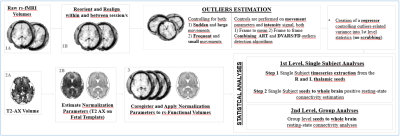 |
87 | An Optimized Processing Procedure for Fetal Resting State Imaging
Matteo Canini, Paolo Cavoretto, Veronica Giorgione, Antonella Iadanza, Silvia Pontesilli, Roberta Scotti, Massimo Candiani, Paola Scifo, Andrea Falini, Pasquale Anthony Della Rosa, Cristina Baldoli
Human fetal brain development is marked by the rapid growth of connections between brain structures during the last trimester of pregnancy. Crucially, data processing of fetal rs-functional scans (rs-fMRI) results largely affected by high degrees of movement, which impose severe constraints on interpretation of functional activation patterns leading to potentially biased results. In this work we present a standardized yet flexible preprocessing and normalization procedure allowing for data loss minimization (i.e. allowing to preserve the highest amount of volumes while consistently excluding outliers) and thus fostering reliable group-level inferences.
|
|
3942. 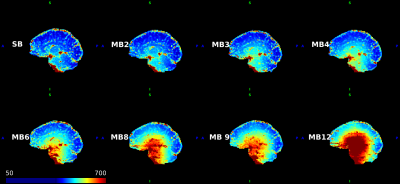 |
88 | Which multiband factor should you choose for your resting-state fMRI study?
Benjamin Risk, Junjie Wu, Deqiang Qiu
Multiband / simultaneous multislice increases the temporal resolution in resting-state fMRI but at the cost of noise amplification, which may result in erroneous estimates of correlation-coefficient based functional connectivity. We examined functional connectivity in resting-state scans from ten subjects with multiband factors ranging from two to twelve. The standard deviation of voxel time series varies across space, which is in part due to noise amplification. Multiband acceleration tends to decrease estimates of functional connectivity, particularly for correlations involving subcortical regions. Consequently, it may be challenging to disentangle low neural activity from high noise amplification.
|
|
3943. 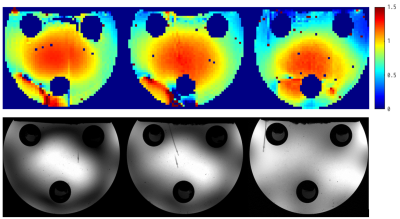 |
89 | EPI based MR thermometry and real-time monitoring for parallel RF transmission at 7T
Guoxiang Liu, Adnan Shah, Takashi Ueguchi, R. Waggoner, Shubham Gupta, Keiji Tanaka
A novel method for MR thermometery and real-time temperature monitoring is developed. Using the change in phase for fat between first and third navigator lines of EPI, the proposed method allows estimating the change in phase for water caused by the change in base frequency at echo time of EPI. Scanning a fat bag placed beside a phantom in different slices allow image reconstruction from the calculated phase difference. The proposed method does not require separate scans for fat and water allowing an effective monitoring of in vivo SAR for ensuring the safety of experimental subjects especially in parallel-transmit systems.
|
|
3944. 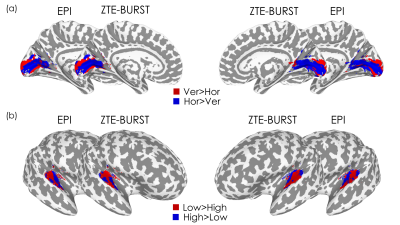 |
90 | Silent fMRI with visual and auditory stimulation using 3D radial T2*-weighted ZTE-BURST sequence
Marta Lancione, Guido Buonincontri, Luca Cecchetti, Mauro Costagli, Jan Kurzawski, Emiliano Ricciardi, Rolf Schulte, Ana Beatriz Solana Sanchez, Michela Tosetti
Besides being a major cause of patient discomfort, acoustic scanner noise (ASN) represents one of the main confounding factors in fMRI with auditory stimulation and in resting state conditions. The recent development of silent T2*-weighted MR sequences may open up new possibilities in the study of brain function in a quieter environment offering novel tools of acquisition, alternative to EPI. In this feasibility study we aim to produce and evaluate BOLD activity maps at 7T using a novel 3D radial T2* sequence (ZTE-BURST).
|
|
3945. 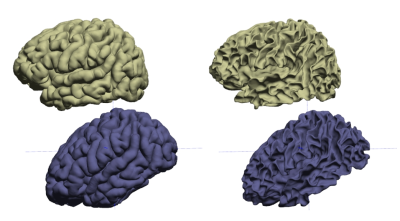 |
91 | T1w MPRAGE transformation based on distortion-matched anatomy for high-resolution fMRI
Adnan Shah, Takashi Ueguchi, Guoxiang Liu
We demonstrate transformation of T1w MPRAGE anatomy into functional space based on DAIREPI T1w-like reconstruction2. This transformation allows comparison of the respective tissue segmentations for highlighting brain regions affected by signal losses and distortions in functional imaging. Effective evaluation of functional imaging at 7T require such an offline quality check procedure to correctly identify the cause of missing hemodynamic activity in high-resolution fMRI at an individual subject-level. This proposed procedure offers a new way to perform analysis of high-resolution fMRI on a high-contrast T1w anatomy and cortical surface in the native EPI space.
|
|
3946.  |
92 | Comparison of continuous sampling with active noise cancellation and sparse sampling for cortical and subcortical auditory fMRI
Rebecca Dewey, Deborah Hall, Christopher Plack, Susan Francis
We compared cortical and subcortical auditory BOLD fMRI responses to epochs of broadband noise acquired using continuous sampling with active noise cancellation (TR = 2s) to sparse sampling (TR = 8s, 1993ms acquisition with 6007ms silence) in a repeated measures factorial design. High resolution (1.5 mm3) 3 Tesla fMRI data were acquired using multiband 2 and corrected for physiological noise and image distortions. BOLD beta estimates are compared for onset, offset and sustained auditory fMRI responses for both sampling schemes. We report the strengths and weaknesses of the two sampling methods.
|
|
3947. 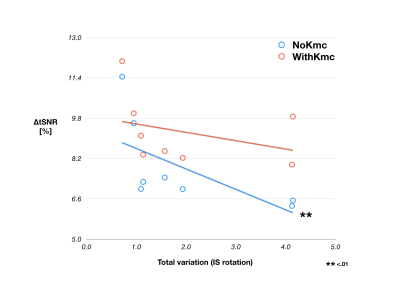 |
93 | Improving k-space physiological noise correction with motion correction in fMRI studies
Chisato Suzuki, R. Allen Waggoner, Kenji Haruhana, Keiji Tanaka, Kenichi Ueno
Although physiological noise correction could improve the signal quality, the signal contamination caused by subject motion would affect the ability to remove the noise. This study aims to characterize the impact of motion on the physiological noise correction in k-space and improve k-space physiological noise correction performance. The strength of motion significantly influenced the average tSNR after k-space physiological noise correction. By removing motion effect in advance, it is possible to make k-space physiological noise correction more effective.
|
|
3948. 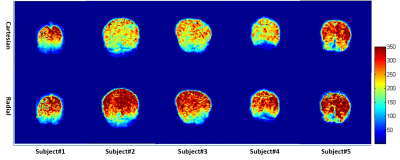 |
94 | SSFP-fMRI: Radial reading helps to Improve Temporal SNR
Vahid Malekian, Shahriar Shalikar, Fatemeh Rastegar, Abbas Moghaddam
SSFP allows us to have functional contrast close to spin-echo, but it suffers from low temporal-resolution. Increasing
|
|
3949. 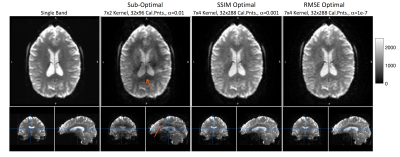 |
95 | Optimization of Simultaneous Multi-slice Imaging with Autocalibrating Reconstruction for Cartesian Imaging Parameters for Human Connectome Type Protocol
Volkan Emre Arpinar, Kevin Koch, Sampada Bhave, L Tugan Muftuler, S Sivaram Kaushik, Baolian Yang, Suchandrima Banerjee, Andrew Nencka
The optimal parameterization of simultaneous multi-slice (SMS) unaliasing kernel fitting with autocalibrating reconstruction for cartesian imaging (ARC) is not obvious. Here we systematically varied five variables that parameterize this calibration process to empirically determine optimal values for human connectome project (HCP) harmonized image reconstruction. Low levels of regularization, moderate sizes of ky-kernels, and increased numbers of ky-calibration points yield improved unaliasing performance.
|
|
3950. 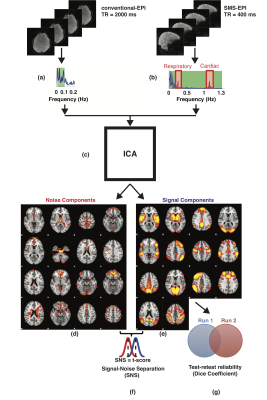 |
96 | Evaluation of simultaneous multi-slice EPI acquisition with an 8-channel coil for resting state functional MRI
Hesamoddin Jahanian, Samantha Holdsworth, Thomas Christen, Michael Moseley, Greg Zaharchuk
Simultaneous multi-slice (SMS) imaging has shown to be a promising tool for improving the efficiency of resting state fMRI (rs-fMRI). As the multi-slice acceleration factor in SMS increases, so does the temporal resolution, allowing increased sensitivity of rs-fMRI measurements. However, to achieve high multi-slice acceleration factors, SMS typically uses higher channel (>=32) receiver coils that may not be available in many research and clinical settings. In this study, we explored the efficacy of using SMS with a typical 8-channel receiver coil for rs-fMRI. Upon employing the slice orientation that maximizes the coil sensitivity variation along the slice direction, we were able to acquire high temporal resolution (TR=400 ms) rs-fMRI data. Compared with the conventional-EPI acquisition (TR=2000 ms), the proposed SMS-EPI acquisition provided superior sensitivity and test-retest reliability for rs-fMRI.
|
|
3951. 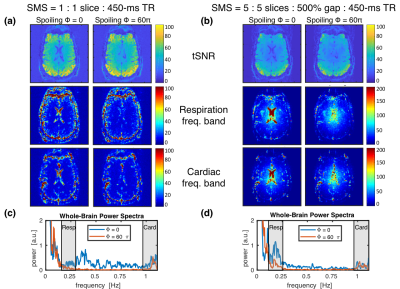 |
97 | The impact of gradient spoiling on the temporal stability of rapid 2D BOLD EPI
Avery Berman, Yulin Chang, Jingyuan Chen, Jonathan Polimeni
Short-TR BOLD fMRI studies have increased in popularity due to the advancement of simultaneous multi-slice (SMS) techniques and the many advantages afforded by rapid sampling. However, in rapid imaging of a single slice, disruptions to the steady-state from physiological sources can result in large temporal variability in long-T2 tissues, primarily around cerebrospinal fluid. We investigated the sources of this variability and how they translate from single-slice to whole-brain SMS-based fMRI.
|
|
3952. 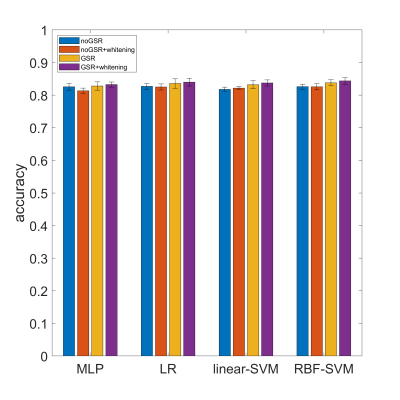 |
98 | Global Signal Regression in Resting-state fMRI Pre-processing Improves Classification Accuracy
Kaibin Xu, Yong Yang, Yong Liu, Bing Liu, Ming Song, Jun Chen, Yunchun Chen, Hua Guo, Peng Li, Lin Lu, Luxian Lv, Ping Wan, Huaning Wang, Huiling Wang, Hao Yan, Jun Yan, Yongfeng Yang, Hongxing Zhang, Dai Zhang, Tianzi Jiang
Global signal regression (GSR) is under debate whether or not influences the interpretation of functional connectivity (FC). However, few studies have compared and discussed the classification performance of GSR on a large dataset. We used a large dataset of resting-state fMRI data with 1082 subjects to test whether GSR influences the FC-based classification performance. We reached 81.35%-84.36% test accuracy using nested cross-validation. We tested the contribution of GSR, feature whitening and classifiers to the classification accuracy variance using three-way ANOVA and found significant main effects only for the GSR factor (F=7.14, P=0.0089). The results suggest GSR improves the classification accuracy.
|
|
3953. 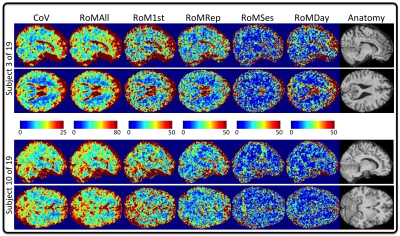 |
99 | On the Reproducibility of In-vivo Temporal Signal-to-Noise Ratio as a Quality Assurance Measure of fMRI Data
Yoojin Lee, Adam Kettinger, Susanna Gobbi, Zoltan Vidnyanszky, Philippe Tobler, Zoltan Nagy
Temporal signal-to-noise ratio (tSNR) is commonly used as a quality assurance measure of fMRI data. The aim of this study was to investigate how reproducibly tSNR maps could be collected in-vivo. We collected 16 fMRI time series in several sessions on two different days and calculated tSNR maps for each. The variability was evaluated over all runs, runs within the same session, runs between sessions and runs between days. Reproducibility turned out to be very poor, which precludes using tSNR as an outcome measure for testing variables that are expected to provide modest but otherwise important improvements to data quality.
|
|
3954. 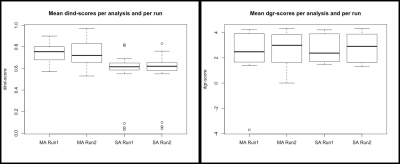 |
100 | Denoising in task fMRI
Peter Van Schuerbeek
To improve the outcome of task fMRI analyses, we compared the result maps obtained following a modulated analysis pipeline with despiking and CompCor added as denoising steps, with those obtained following the standard analysis pipeline. The data was taken from 5 studies. We focused on the overlap between the obtained individual findings, between the individual and group results and between the findings of 2 fMRI sessions. Our results revealed a reduction in false results in the ventricles, but failed to show an increased repeatability of fMRI results after the denoising. In conclusion, denoising prior to the statistical analysis seems advisable.
|
 Back to Program-at-a-Glance |
Back to Program-at-a-Glance |  Back to Top
Back to Top